
Reflex
Violence
The Way
of Internal Gung-fu
The Erle Montaigue System
A Moontagu Book

Reflex Violence
The Way of Internal Gung-fu:
The Erle Montaigue System
Moontagu Books Australia
Erle Montaigue
Appearing in the Photos:
Ben Montaigue
Photographer:
Eli Montaigue
Thank you to Rob and Mause Eaglen for their devotion and
hard work in running our annual WTBA camps in Australia.

Publisher’s Note:
This book contains material never
before published. The enclosed
information can only have come
from Erle Montaigue, being the only
Westerner to have received this
information. It is illegal to copy and
portion of this book other than brief
extracts for review articles. You
must obtain permission directly from
the copyright holder ©2000. It is also
illegal to plagiarize any part of this
book to use in some other
publication, paper, electronic, or
video and film, by changing it in
some way to make out as if it has
not come from this source.
This book is provided free of charge
in good faith so that all may enjoy
the great benefits of this pinnacle of
all Taijiquan systems. You may
download it free of charge. But
please do not plagiarize it. Even
though it is free, it is still covered by
international copyright laws.
Moontagu Books
POB 792
Murwillumbah, NSW 2484
Australia
Ph: +61 2 6679 7145
Fax: +612 6679 7028
E-mail: info@moontagu.com
http://www.moontagu.com
Copyright © 2000
Moontagu Books Australia
First Published in Australia
Electronically March 2000
All Rights Reserved
ISBN: 0-949132-07-9
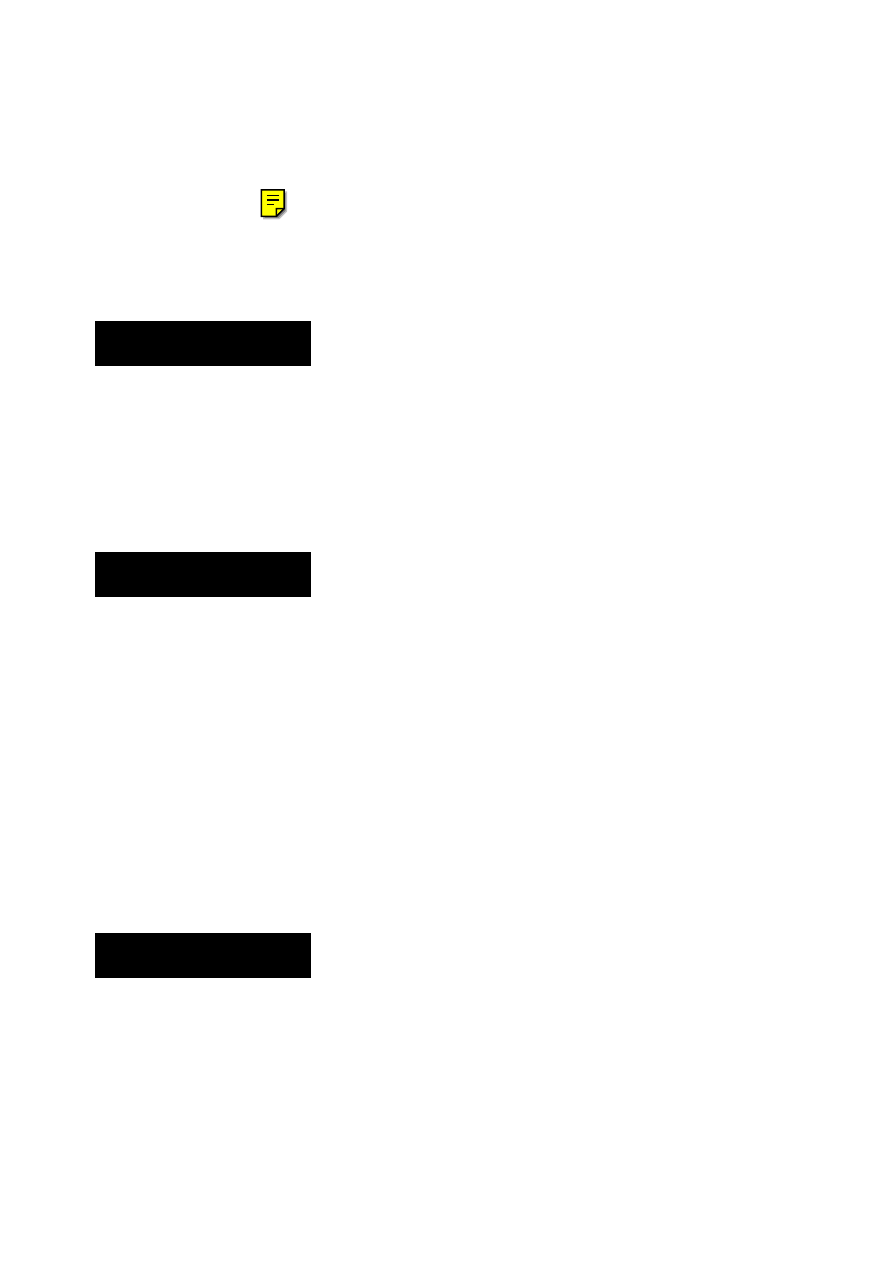
CONTENTS
Introduction
Reflex Violence............................................ 1
Fa-Jing ........................................................ 2
The Reptile Brain ......................................... 9
Melissa Soalt’s Section................................. 11
Rules for Fighting........................................ 24
Chapter One:
Accessing the Reptile Brain...........................34
Qigong & The Reptile Brain.........................41
Dim-Mak & Reptile Brain ...........................43
A Physical Reptile Brain Method...................46
Danger Signs...............................................47
Cell Memory...............................................48
Reptile Brain in Healing and Fighting.............49
The Keys....................................................51
Other Ways to the Reptile Brain....................51
The Ears & Backbone..................................53
Chapter Two
The Reflex Violence Fighting Methods ..........55
Introduction: Page 4

Introduction.
S
udden Violence is an apt name for the eclectic martial arts or
self-defense system that I now teach. The name was suggested to
me by a friend and student, Doug in the USA. It has come
mainly from the Internal Martial Arts of Taijiquan and
Bagwazhang. The name, “Reflex Violence” comes from the video
series called ‘Sudden Violence’ A series that only dealt with the very
direct and dangerous street-fighting method that I now teach.
However, there was already a book called Sudden Violence, so I
changed the name to ‘Reflex Violence’ which is more in keeping
with what the internal martial arts are about anyway.
Hidden within the Internal Martial Arts are some of the most vio-
lent self-defense methods ever invented. And that’s what
self-defense has to be in order to survive street attacks. If you try to
‘yield’ to an attack in the traditional manner that most teachers tell
us to, then you invite defeat and possible injury and death in street
attacks. And it is so obvious to me that teachers who tell their stu-
dents that all they have to do it to yield to an attack just to show the
attacker that they know what they are doing, have never themselves
been in a serious, life-threatening situation.
It’s all there in the Taijiquan and Bagwazhang ‘classics’. However,
most teachers take these classic saying too literally and try to execute
what those classics say before they have risen to a high enough level.
You cannot understand what the great old masters have said when
you are not at their level to begin with. The old masters did not
write the classics when they were beginning! They wrote them once
they had understood fully the meaning of ‘internal’ and ‘small
frame’. They wrote them when they were very advanced. What is the
use of writing a guide for beginners? The beginner can learn the ba-
sic movements from anyone who knows them well enough. But
once learnt, it is very important to have a teacher who is able to im-
part the inner knowledge and also to take the student onto the more
advanced forms. And only then will the students understand the
true meaning of what the classics are trying to teach us.
The whole secret to learning about ‘Reflex violence’ in the internal
martial art, are in the movements themselves and how the practitio-
ner executes those movements. How the body moves is singularly
the most important area of one’s training. I have seen so-called ka-
rate masters who should not be any more than a blue belt because of
Reflex Violence: Page 1

the way they move. Sure they know all of the movements of the
kata, but they cannot do them! Then I have seen others who do
know about fa-jing and who have only been studying for a relatively
shorter time. You can easily see that most of them do not have any
real power, power that comes from fa-jing, because their body is so
stiff!
Fa-jing
Fa-jing is the motor of Reflex Violence and how to use the internal
martial arts effectively. But not many know what fa-jing is nor how
to use it. Again, I have seen so-called Taijiquan masters and people
who call themselves Grandmaster, performing fa-jing, or what they
call fa-jing, and they would not even harm a fly let alone a raging
maniac intent of doing them great harm. Fa-jing has to be explo-
sively physical and explosively internal using Qi.
So I will be stressing the use of fa-jing all throughout this book be-
cause it is so important to any self-defense, no matter what your
style of martial art.
Fa-jing has two levels; the pure physical, whereby we are able to at-
tack with extremely powerful attacks from very short distances and
the ‘internal way’ where we also make use of something else other
than pure physical movement. I must add here that it is impossible
for anyone to gain the ‘internal way’ of fa-jing without having learnt
the physical way first. The babies who stand up and walk before they
crawl are very few. So it is very important to crawl before you can
run.
The test for fa-jing is this. Have someone hold a hard punching mitt
on one hand. You touch the mitt with the tips of your fingers. Now,
without drawing your hand back any more than the distance from
your fingers to your palm, you must punch the mitt to cause the mitt
to be repulsed back violently. This is external fa-jing. Internal fa-jing
is when the holder of the mitt, receives a sore palm from that punch!
Actually, the sore palm comes from attacking the mitt from about 9
inches away. The fingers on the mitt are simply a way of testing that
you have external fa-jing to begin with. There are three punches that
I have people perform in this manner to see if they have fa-jing in or-
der to join and become instructors of ‘Reflex Violence’, The Erle
Montaigue System’.
The first punch is the Taiji snap punch. This is a common punch
from Taiji only, that not many regard as very common! To begin
Introduction: Page 2

with, the whole body must be totally loose (in a state of ‘sung).
Right down to the very fingertips, must be like a rag doll. The waist
is the area of the body that will give you external fa-jing power. And
in reality, it is beyond the scope of this book to teach anything else
other than purely external fa-jing as the internal way must be taught
by a master. However, if you can even get an inkling of what exter-
nal fa-jing is all about, then you will be miles ahead of what you al-
ready know and will be able to enter into ‘Reflex violence’.
Reflex Violence comes from the subconscious mind or what we call
the ‘Reptile Brain’ or Brainstem part of the brain. This is the survival
brain, the brain that all animals have in order to survive. The Reptile
Brain cannot help you while you are being a ‘human’. So when we
are told to ‘block’ that punch, and do a reverse punch to the abdo-
men in defense of such and such an attack, we can be nothing else
other than logical thinking humans. And logical thinking humans
lose fights! How many times have you heard something like? “He
was an animal when he attacked.” He WAS an animal which is why
street fighters have so much power and aggression which far out-
weigh any logical ‘martial arts’ training you might have received. A
martial art is nothing more than a series of movements and as such
cannot be used to self-defense until you have received the informa-
tion that turns a martial art into a self-defense art.
And that is what this book is all about, taking your martial arts sys-
tem and turning it into a devastating form of self-defense. Turning
the mild-mannered reporter into a raging bull.
Taijiquan Snap Punch
The Taijiquan snap punch begins with the palm held as in
Photo
No. 1.
Notice however, the positioning of the whole body. The
back is slightly rounded. The shoulders are totally relaxed or in a
state of ‘sung’. The energy is sunk to a point called the ‘Tantien’. You
are using what we call “Eagle Vision.” This is the type of vision that
you can only use when you go into the “Reptile Brain” mode. It
causes you to see everything. Not so focused as in normal human
mode, but every tiny movement near you causes you to react when it
is within your sphere of attack. Even a toe twitching causes you to
be ready etc. You never focus upon your attacker, your eyes are
slightly glazed so that you can use a kind of peripheral vision. Your
arms hang out in front of you like tree branches ever ready for action
directed by your waist. Your whole body is ‘connected’ so that if one
part of your body moves, the whole body will also move. The power
comes from the waist which is of course connected to your arms. In
most so-called ‘external’ martial systems, the arms move by them-
Reflex Violence: Page 3
1
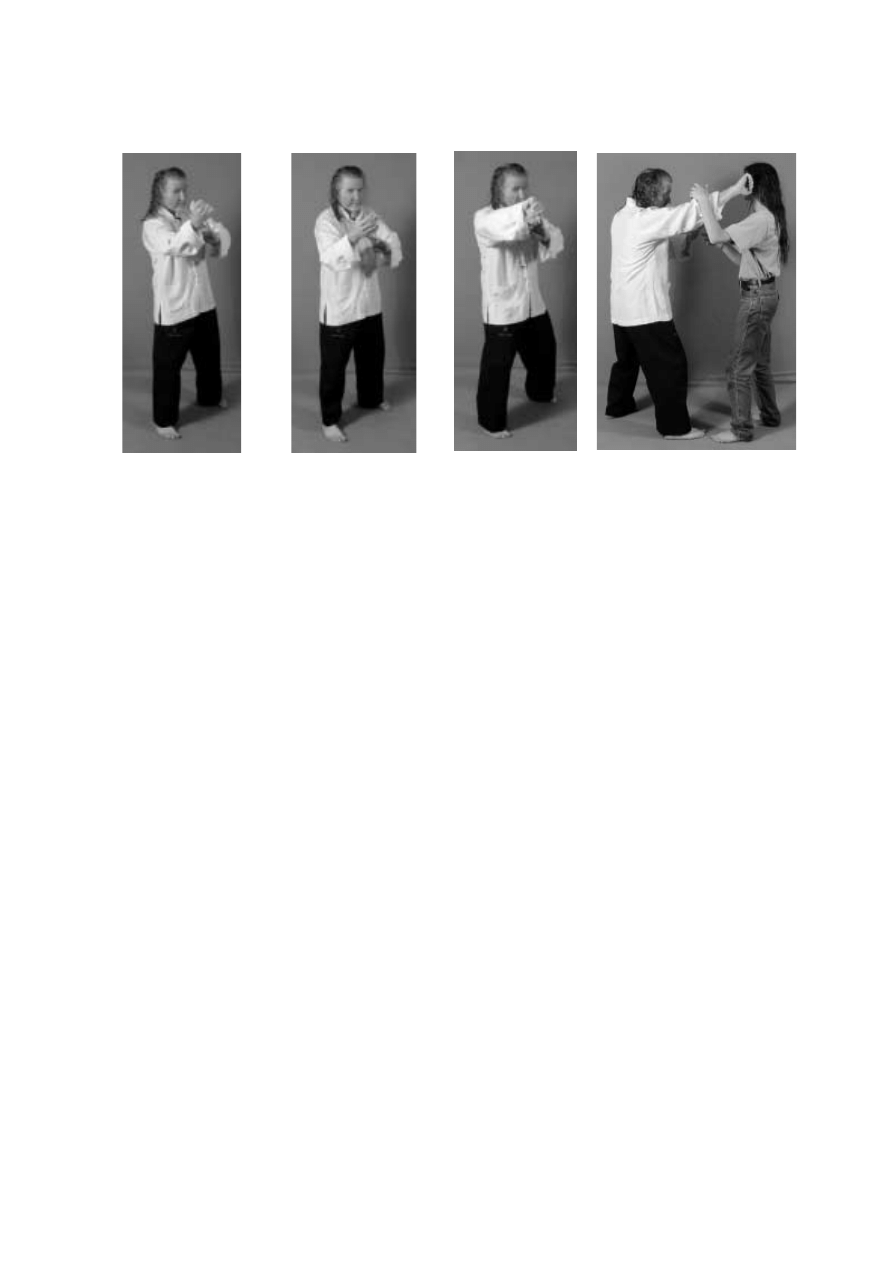
selves using only the power from the arm muscles, but in the Inter-
nal Martial systems, the arms are only extensions of your whole
body. It’s like this: If you have a piece of pipe and attached to the top
of the pipe is a cross-member, another pipe making a ‘T’, when the
vertical pipe is turned for instance only slightly, the end of the ‘T’
piece moves much further and harder. You do not have to turn the
vertical pipe very quickly in order to have the ‘arms’ moving at great
speed and power. And it’s the same with the human body in fight-
ing. If the arms and indeed the whole body is ‘attached’ and only
moving as a result of what the main part of the body does, then the
waist has only to move slightly and violently to cause an explosion of
power in your arms. This is natural. So your arms are moving in to-
tal harmony with what your body is doing.
When the waist turns violently to your left if you have your right
palm ready to punch as in the above photo, there is slight pause
when the fist is catching up to what the waist is doing, like a rubber
band. So when the fist finally catches up with what the waist is do-
ing, it explodes outward. Now, if you snap your waist back the other
way at just the precise moment that your fist is making contact,
there will be a second centrifugal movement causing what we call
‘Twisting Power’. Then we have ‘Spiral Power’ (Spiral Qi) by the
fist also turning over upon impact so that it makes contact as in
Photo No. 2.
This is the first punch in the learning of fa-jing. It uses
the last three knuckles.
Introduction Page 4
2
3
4
5

Penetration Punch
The second punch is called the ‘Penetration Punch’ and is called so
because of its ability to penetrate even the best on-guard stances.
This punch begins with the palm facing slightly upward as in
Photo
No. 3.
It makes contact with the smallest finger part of the hand on
the top and makes contact with the first two knuckles. This punch
also uses the fa-jing waist shake in the opposite direction to generate
the extreme power necessary to cause this punch to work.
Photo
No. 4.
The reason this is called a ‘penetration punch’ is that because
of its movement to end up as it does and from its beginning posi-
tion, the action of the forearm on the person holding the good on
guard stance is to force his arm violently outward simply by its ac-
tion. You do not have to think about slamming his arm out of the
way. The punch just does it for you. All you have to think about is
using the punch and the blocking will happen automatically.
Photo
No. 5
shows how it works in a fighting situation by attacking to the
temple as it breaks through the guard.
Back Fist Punch
The last of the three punching methods for fa-jing is the Back Fist.
Many people get this punch wrong in that they think that it has to
have much forward motion or swing. Again, this punch, in just the
same way that the other two have great power over small distances,
also gains power from what the body is doing. Think of your palm
and wrist as the end of a whip and your body as the rest of the whip.
You begin the movement by turning your body in the correct direc-
tion. In this case to my right as I am using my right hand. Just before
impact, you violently turn your waist back to your right which will
pull your left arm backward violently. Now, this is where the loose-
ness of the whole body comes in. If you were to have a stiff forearm
and wrist, your fist would be pulled back with your arm thus negat-
ing the forward motion. However, because the wrist is very loose
like a whip, when you withdraw your arm by turning your waist,
your wrist and palm continue in that same direction with great
speed. So all you have to do is to close your fist as the wrist is at its
fullest point to gain the maximum power for this strike.
Photo No.
6
.
The Targets
The three punches can be used against many targets so I will show a
couple of main targets for each punch. The Internal Snap Punch can
be used to almost anywhere around the head and neck. One of the
Reflex Violence: Page 5
6
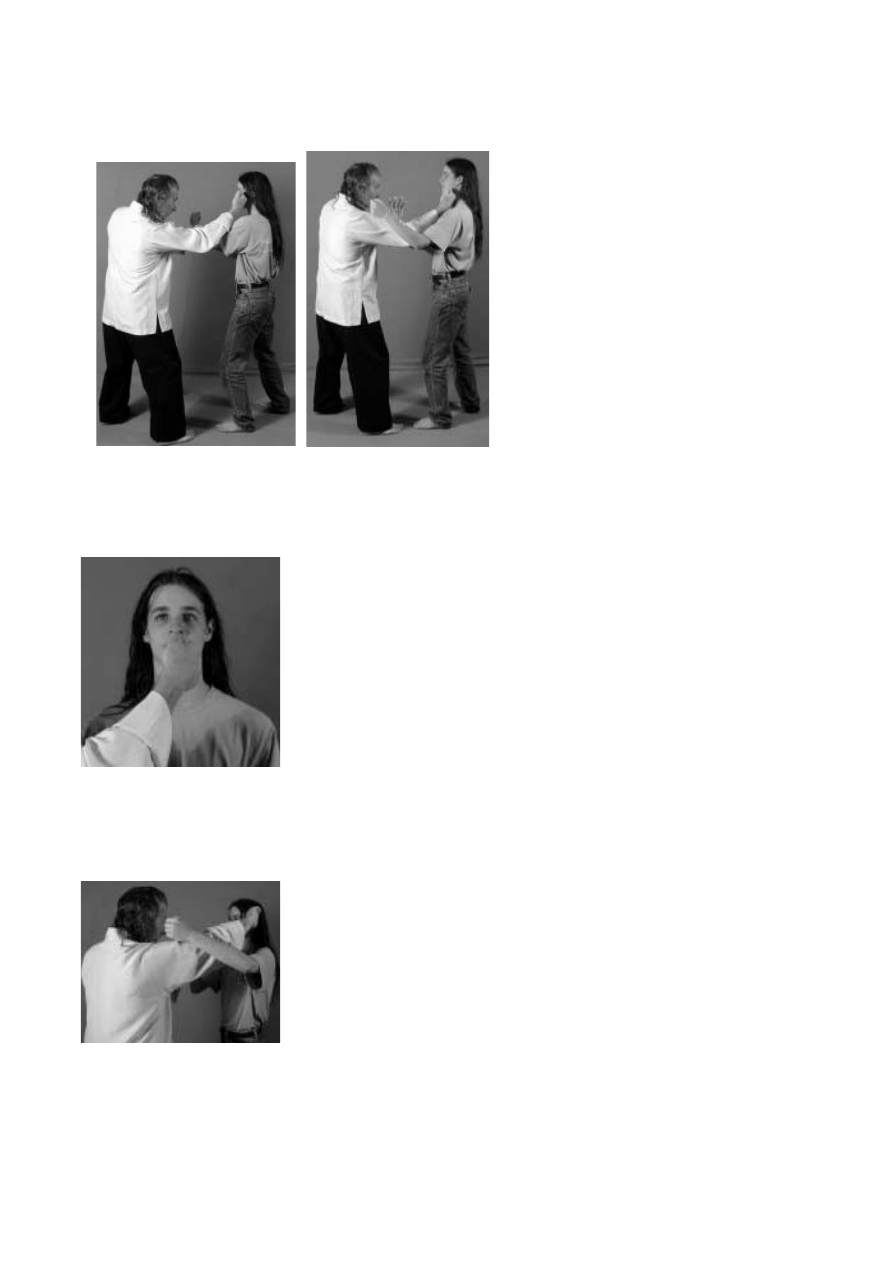
main targets is to the knock out point
called ST 5, a little back on the jaw.
This is an excellent knock out punch
and has the same effect that the ST 9
point has in activating the carotid si-
nus. Because it is a Stomach point and
that we have nerve ending in the base
of the stomach that come directly
from the ‘Vagus’ nerve, (that nerve
that runs from the base of the skull
down the back of the neck and into the
heart and is responsible among other
things for the control of the heart
rate), this point works to also slow the
heart rate down quite dramatically,
thus causing a knock out. The point is
situated on a hard boney area of the
face so it is also quite close to the sur-
face of the skin, hence its being so effective.
Photo No. 7
. This
punch can also be used to the ST 9 point. This is the classic knock
out or death point that all so-called knock out specialists use in dem-
onstration only! I say ‘only’ because the way most of them move,
they would not be able to use any knock outs in a realistic situation!
This is why I make the statement that “knock outs don’t work.”
When someone says that they do, and that they could knock me out,
I invite them to! When they even get anywhere near me, expecting
me to be a sitting duck like their other ‘prey’, I usually end up
knocking them out! Or in the least, pull my attack just short show-
ing them how difficult it is to do it for real not knowing how to
fight first of all! It is no good at all pretending to be a fighter if all
you have ever done is some ring fighting in tournament! You have
to have been in a few real ones before you understand what fighting
is all about.
Photo No. 8
shows the snap punch used against the ST
9 point. It can also be used to great effect against another of the
Dim mak points called GV 26. (Governor Vessel Point No. 26),
just under the nose about one third of the way down between your
nose and your upper lip. This is a death point when struck from his
left to his right and we have just the tool for this, the Internal Snap
Punch. GV 26 is also very good to use when someone is in shock.
You place your thumb onto the point and push upward.
Photo No.
9.
The Penetration punch can also be used to a number of targets,
however, it is more limited than the previous punch. However, it is
great for the job that it is intended for. It can be used as previously
shown against the temple or the death pont called GB 3 (Gallblad-
Introduction: Page 6
7
8
9
10
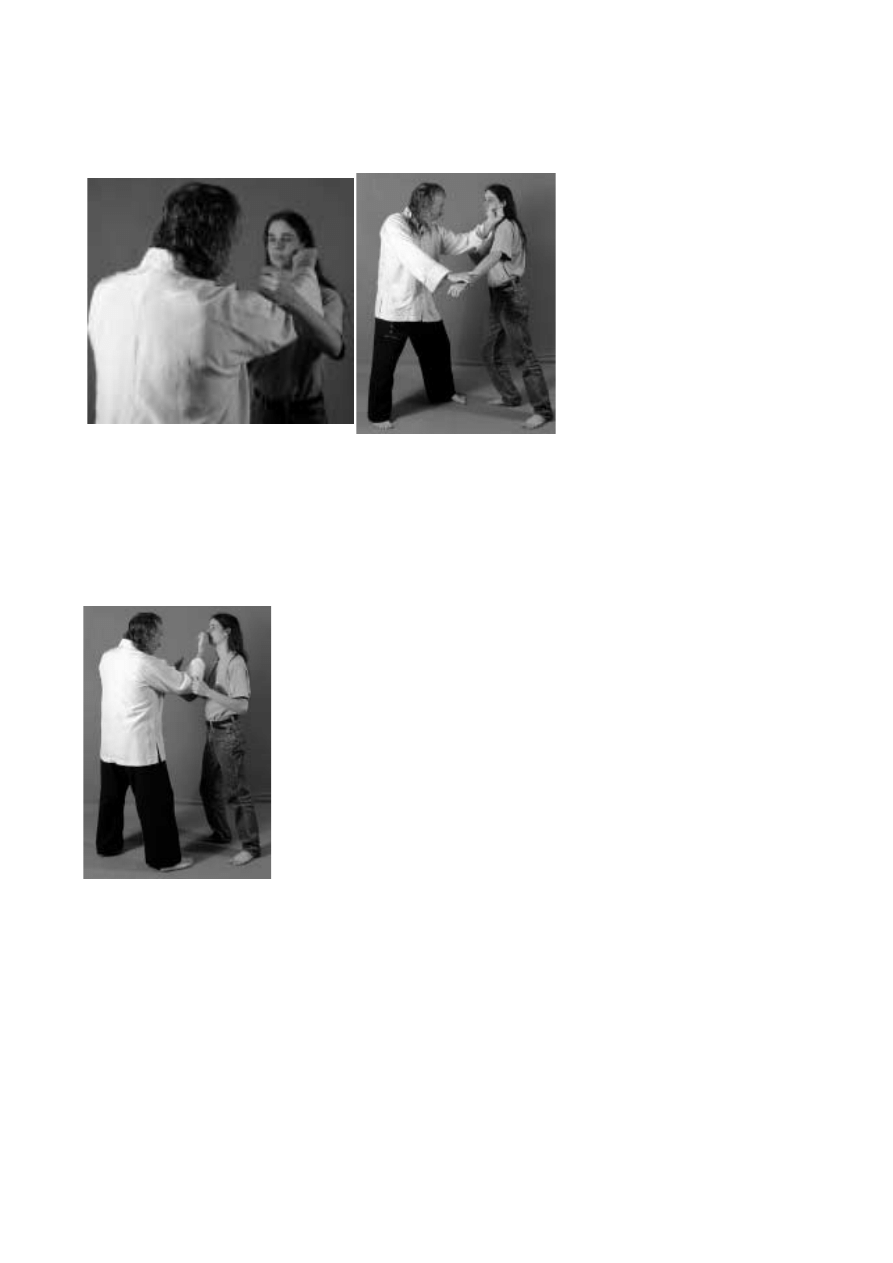
der Point No. 3). The Penetra-
tion punch does not come in
from the side like an arc, but
rather moves in straight and
slightly angles inward as if you
are doing a straight punch.
However, because of the ac-
tion of rotating it just before
impact, you get a sort of spiral
action that does great damage
to the temple area in just the
right direction to do that dam-
age.
Photo No. 10
shows this
punch against the ST 9 point
also. In this case it is ideal as
the correct direction is caused
again by the action of this
unique punch. It can also be used in just the same manner against
the “Mind Point.” This point is a classic knock out point as it stops
the electrical signals from reaching the brain from the central ner-
vous system and the body just falls down! It is located not on any
particular meridian as it is an ‘Extra Point’ just before the ear above
the jaw line a little up and back from ST 5 point.
Photo No. 11.
The Back Fist strike can be used in a number of different ways, it can
be used against the body but has to be modified for this purpose
putting more body movement into the punch to cause it to pene-
trate more due to the body being thicker and softer and well padded.
So it is generally used to the face and neck. It can also be used against
the mind point. It is ideal as all you have to do is to aim the back of
your wrist at the point of the chin. Then just as your wrist is about to
touch the chin, the body pulls back in that whipping motion causing
the fist to be whipped out thus reaching around to the side of the
face to attack perfectly the ‘Mind Point’
Photo No. 12.
It can also
be used as a vertical back fist as in Taijiquan. This time the body uses
a vertical type of whipping action like throwing a fishing rod. This
movement will again withdraw the wrist so that the fist is whipped
out into the point called CV 24, a death point or Qi drainage point
just in the crease below the bottom lip and above the chin.
Photo
No. 1
3. This has the added advantage of also breaking the jaw or
dislocating it as well as the electrical effect of the Dim-Mak strike.
I must add here that if you try the above and you just cannot get any
power, then you are probably doing a stiff external martial art that
does not allow for any looseness. It is always ‘user error’ if you can-
not get the power. One of the main areas of “Reflex Violence” is
Reflex Violence: Page 7
11
12
13

that you must be extremely ‘soft’ or in a state of ‘sung’ to begin with.
This is very difficult for so-called hard stylists to understand as they
are always told to ‘be strong’ and unfortunately, ‘being strong’
means being tense and stiff. There is an equal and opposite reaction
to everything you do so if you begin slightly tense, then as you at-
tack, you can only go that bit further into violence. But if you being
extremely soft, then the equal and opposite of that is extreme vio-
lence. ‘Sung’ is a Chinese word that means not being able to feel
your joints moving, . . . Because you are so relaxed. However, to re-
lax is not the correct word as there is no single English word to
translate ‘Sung’. Your body must be like a rag doll where every slight
movement of the body causes the peripheral weapons like the hands,
to whip out with great power. If you are at all stiff, even slightly, you
will not gain this immense power from being soft. The whole of the
internal martial arts are based upon this principle.
You must also sink your weight (Qi) into the ground when you use
any of these punches as this will give you more power and stability.
Once you have it though, you will be able to launch any attack from
anywhere and from any short distance. And this is where fighting
happens, in your face! Fighting does not happen from a distance. A
good fighter can be in your face before you can blink, and the short
range methods using fa-jing are the only way to protect yourself in
these situations. And if a fighter is not in your face in a matter of sec-
onds, then he is not worth fighting anyway, you should just walk
away and allow him to claim victory! If the fight is for real however,
and your life is threatened then the methods that I will give in this
book will give you all you will need, given the fact that you will of
course have had some basic training in fa-jing and looseness.
My main thrust in teaching is to always teach people how to fight
first. So it is not in my nature simply to give you loads of very deadly
techniques without some idea of The Montaigue System. The best
way is to include here my “Rules for Fighting” which I give to all
of my senior students. We go over each of these rules in turn, one
every month. We do not go on to the next ‘rule’ before I am sure
that the previous rule has been mastered in as realistic a situation as
possible given that I never damage my students in any way! When
people ask me what is the difference between myself and others who
also teach point striking, I tell them that Erle Montaigue is afraid to
hurt his students. Sure the occasional whack here or there just to
give the student some idea of what it is like to be struck, but I never
use knock outs or real point strikes as they can do permanent dam-
age later on in life.
Introduction: Page 8

These rules apply to people of all sizes, male or female as we all have
within us the ability to protect ourselves and family. It does not mat-
ter if you are a small framed man or woman, you can still summon
that animal within. It often is a little more difficult for some men
and some women who have been ‘conditioned’ more than others by
‘Western Ideas’ where we believe that woman for instance have no
hope of defending themselves against men. Using my methods
women have an even better chance of defending themselves because
of the interaction of their brain with their reptile brain. Remember,
the Paleo-mammalian brain or ‘Old Mammalian’ brain is the brain
that is responsible for our ‘mothering instinct’. And this instinct in-
cludes a very potent self-defense mechanism as all female animals
have the added responsibility of defending their young. Often the
female animal will have to defend itself against the male partner!
And this also unfortunately happens in the human world. And if
women knew about the immense power that they have at a subcon-
scious level, we would have deaduns (men) all around the place in
matters of domestic violence! I discovered long ago when I began
teaching women this stuff, that they are bloody deadly! When the
combination of both brains is tapped, the power that women have is
tremendous. And it’s not just that they have power, it’s the willing-
ness to attack and keep attacking spurred on by the
paleo-mammalian brain in conjunction with the reptile brain.
You can also look at it this way, the more ‘Yin’ you are when normal,
the more ‘Yang’ you will be when you have to be. So when women
learn how to access their hidden power source, because they are es-
sentially ‘Yin’, when they are threatened, they can turn into animals
with a killer instinct far greater than any male.
The Reptilian Brain
It works this way. The reptiles were given the first kind of brain.
This brain was very basic much like a computer that has been
programed to do certain tasks and to act in certain ways in certain
situations in order to survive. The reptiles were given some kind of
protective instinct as far as their young are concerned like when the
female crocodile protects her eggs from all attackers including other
crocodiles to the death! However, if she were still with those eggs as
they hatched, she would eat them! So, built into the crocodile’s rep-
tile brain is a program that told the Mother crocodile that at a cer-
tain stage in the eggs’ development, she was to go away from them
and allow them to hatch by themselves. This is a very basic
‘Mothering Instinct’. At these times, the female crocodile is the most
dangerous and will even take on the much larger male crocodiles
when her eggs are threatened. And most times she will win!
Reflex Violence: Page 9

So when God invented the mammals which are much more compli-
cated and needed the newly born young to be looked after as they
were too complicated to look after themselves until they had further
progressed outside the womb, there needed to be a new kind of
brain or ‘computer program’. Hence the next brain, the
‘Paleomammalian’ or Old Mammalian brain. This brain now caused
its owners to have a more advanced ‘Mothering Instinct’ which
caused the Mother (or the Father as in many other animals and hu-
mans) to look after and nurture its young after they were born, until
they were old enough to fend for themselves. So now, we have that
‘killer instinct’ also with the mammals. The most feared animal is the
Mother grizzly bear, who will kill anything regardless of how large
and strong it is, that tries to harm her young. This is called instinct.
However, it is simply the Old Mammalian brain coming into play
where the ‘program’ causes the female bear to act this way. It is re-
flex violence at its purest! The bear does not know why it is acting in
this way. It’s just that it has been programmed to do this.
The next most sophisticated brain was invented for us humans
where the human baby has of course to be looked after for much
longer than most animals before it can fend for itself, often into
adulthood with some children! So an even stronger ‘Mothering in-
stinct’ was programmed into this new brain for us humans. Both of
the other brains and programming was still there. However, the
new Mammalian brain or ‘Neo-mammalian’ brain was the strongest
and generally tended to take over from the other two. However, in
times past, like prehistoric, humans were able to access the old and
reptile parts of their brain readily in times of crisis in a reflex way. So
the ‘killer instinct’ was and is still there, hidden away ready for use.
However, the sad part is that as we humans became more and more
sophisticated, we lost the use of the first two brains preferring to rely
more upon logical stuff and other more ‘trained’ people such as po-
lice-officers for our protection. You’ll see the old mammalian brain
coming out in some women when they have just been abused so
much and they ‘snap’ and kill their so-called husbands in self defense
and out of sheer desperation because the legal system cannot protect
them or their children. Then most of them are themselves put into
jail for simply acting out of instinct in protection of themselves and
children reflexively by automatically going into their brain.
Many woman and men also in times of great crisis automatically see
a glimpse of their reptile brain when they receive superhuman pow-
ers in the many cases when woman and children have literally lifted
cars off their trapped and dying loved ones, cases that are well docu-
mented. Try for instance to grab an Aussie possum! It is only a small
cuddly animal, but when cornered or grabbed, it has amazing
Introduction: Page 10

power, which most strong men find too powerful to hold, as I have
discovered on many occasions when trying to protect an injured
one! If an animal this small has so much power, think of the power
that a human being has if we are also able to go into the
Paleo-mammalian and reptile parts of our brains.
Melissa Soalt
I will include a small piece from a friend of mine, Melissa Soalt
(M.A), who is a well-known American self-defense teacher. She has
some wonderful ideas on women’s self-defense.
From Melissa Soalt: “ ... Got your “Reflex Violence” tapes in mail
today. Can’t wait to view them!! God, its refreshing. The US has
gone soft and gooey around all this stuff. I love it that you say it like
it is: animal violence. (my beautiful junkyard bitch within thanks
you ) And that you so naturally pair this with the other side of the
coin - healing. Like I always tell women, we’re fundamentally a
beauty and beast combo: “Once upon a time we were all neander -
babes who lovingly suckled their young one minute, then speared
the bears and stomped on ugly snakes the next - I mean, two for
one... such a deal!” Cleaving the face of beauty from beast not only
fractures women’s souls, but it endangers women and keeps us
tithed to a victim role - unduly fearful of men and their powers.
But, sadly, this is a culture mired in dualities. “It” has a hard time
grasping and reconciling spirituality and violence (fighting arts); or
femininity and aggression. In spite of Xena and a culture gone “war-
rior chic” bashing back - even in survival - is not a popular notion.
More new age whipped cream on shit, if you catch my drift... Please
know that your bold attitude and big yin-yang heart inspires me ...
Best Regards. Ciao for now. Melissa Soalt ”.
Melissa and Michael Haynack run training school in the USA dedicated
to realistic martial Arts and self-defense. Their new video will soon be
available through Paladin Press. The following is an article she wrote es-
pecially for this book and also for Combat & Healing Magazine.
Reflex Violence: Page 11

HOMAGE TO BEAST-GIRL & ERLE:
By Melissa Soalt:
Two great powers from “down under!” May their boldness and
wisdom prevail...
I was nineteen when I had my awakening. It was on a crowded train
in India. A pervert posing as Mr. repeatedly wouldn’t take NO for
an answer. I had already exhausted my first lines of defense: I swat-
ted his hands away, told him NO in my best dog training tone of
voice, and flashed him my meanest don’t fuck with me look. I even
prayed to God for an unsightly nose bleed.
Like most Indian trains, this car was packed - a virtual sea of bodies
not to mention the requisite chickens and goats lay before me. As far
as my eyes could see, there was but one other female. Men, young
and old, were standing, sitting, squatting on their haunches, chant-
ing and jeering, merged together like dots in a photograph. It was
impossible for me to move; there was no place to go. I was stuck
with the perv.
Night had long fallen; it was dark in the train and most everyone
had dozed. When, in spite of my hyper-vigilance, I too dozed off, he
assaulted. I awoke, blurry-eyed, to hands stealing pieces of me in
the darkness. His hands roamed then groped my body like
hit-n-run thieves in the night,
striking high on my chest then
migrating low. He muffled
gravelly sounds under his
breath, his fingers hunting for
an opening in my clothing.
Frustrated, he groped again,
this time pawing me like a dog.
This all unfolded in a matter of
seconds. (who knows what
transpired during my slum-
ber?)
As I came to I caught a
sneak-peek at his uncensored
face, a window into his bestial
stirring. His eyes – hard, dis-
tant and glazed over with a
Introduction: Page 12
Melissa Soalt

thick icy veneer – reflected a chilling intent: to reduce me to matter,
to nothing more than meat, and to render me devoid of a human
spirit. To be rendered spiritless would be, after all, the ultimate anni-
hilation of a woman’s soul.
His face left such a frightening impression that for a moment I felt
myself succumb to his indignity. I could feel my spirit evaporating
as though atom by atom… but I quickly snapped out of it shaken by
a more primitive perception that he was a wolf and that I, his in-
tended sacrificial lamb. Take away the human element, the thin fac-
ing of civilization and its not unimaginable…
That’s when I exploded: I bolted up and whooshed forward in a
blaze. I dove and rammed my open hands into his face, driving and
slamming his head – , bamm – against the folded down wooden
bunk. Swearing in my best Brooklyn-eese, I grabbed him ’round
the throat, shook him like a rag doll, and when he attempted to
strike back, I busted his hand: Little bones crunched under the fury
of my fist.
My attack was so swift and ferocious that he had no time nor chance
to counter or cover. I never once thought about getting hurt; I sim-
ply attacked, intent on shutting him down. I remember the look on
his face, how his large and once menacing body deflated in my on-
slaught until he appeared small and vacuous and I, much larger than
he.
It wasn’t that I enjoyed hurting him – I did not; in fact, the whole
time I felt a peculiar mix of rage and compassion – but that home
run grin on my face revealed my profound sense of joy at having re-
trieved a primeval sense of power. As though some truncated part
of myself, usurped by civilization, popped back into place like a sin-
ewy muscle.
Call it cellular memory or maybe it was the magic of Mother India,
but this was a moment of righteous epiphany. Just before I went
“off”, I was transported, as though swirled back in time through
evolution and reunited with an ancestral part of myself – an earlier
(and much hairier) embodiment I call Neander-Babe. Something
clicked: For the first time ever, I felt my entire body – not just my
heart and mind - as an instrument of power. I had hit the primordial
jackpot.
This wasn’t the first time I encountered the creature-like part of my-
self. On my maiden voyage, even though I traveled with a man, I
experienced other far more violent attacks that resulted in mutual
Reflex Violence: Page 13

combat and taught me some important lessons. For example: if he
can reach you… you can reach him! Although I had no self defense
training I had good instincts and was endowed with ample chutzpah
(loosely translated as fighting spirit for the yiddish impaired). In Is-
rael I had successfully fought back and escaped from a near rape at-
tack (perpetrated by my not-so-kosher kibbutz “father”), and I had
managed to evade oncoming knives from a mad Afghani who
lunged at my companion and I when we politely refused his offer to
trade me for his prized camel.
She - my Beast-Girl - was omnipresent and always came to my aid.
Sounds fantastic, I know, but in each assault, she rose up from a sub-
terranean part of myself, busting her way through the cakey layers of
fear, the weight of socialization, infusing me with her beatific in-
stincts and bestial powers.
Maybe it was because I busted those bones, but the incident on the
train connected me to something deeper than the rest. It was a de-
fining moment that transformed me at the core. On this occasion
the primitive piece I recovered, a once hard-wired package of an-
cient wisdom and know-how, time-traveled back and promptly
(and permanently) re-loaded.
In hindsight, I think of this story like a fairy tale with a twist: attack-
ing back was the kiss that beckoned my sleeping beauty…
Decades have passed since my awakening. Having since trained
thousands of women how to protect themselves and summon
Beast-Girl in a flash (hence my beloved trade name, Dr. Ruthless!
®
), I can attest: the fear of rape and attack is every woman’s fear. You
can’t always see it but its there, crimping women’s sense of freedom
and quality of life. The (US) National Victim Center reports that
the fear of crime and attack leads a whopping 73 percent of women
to limit where they go alone. According to Margaret Gordon and
Stephanie Riger, co-authors of The Female Fear, it’s pervasive:
“Most women experience the fear of rape as a nagging, gnawing
sense that something awful could happen, an angst that keeps them
from doing things they want or need to.” Is it any wonder: fear has
become the background noise of women’s lives. What if he… turns
out to be a predator?
This fear has also spawned lunacy, generating a multi billion dollar
personal security industry. Grown women are driving around with
life-sized male dolls, advertised as “your personal bodyguard” buck-
led into the passenger seats of their vehicles and are propping them
in front of living room windows hoping to dissuade would-be ag-
Introduction: Page 14

gressors. Imagine what goes through a child’s mind who sees
mommy carting around her big male “doll” before driving off to the
mall, or seating him around the dining table…
The anxiety fueling such panic, however, is not unfounded: In the
US alone, the FBI reports that one million women a year are stalked,
that 1 out of 8 women will become the victim of “forcible rape,” and
that a woman is beaten, by the hands of a loved one, every 12 sec-
onds. In some US hospital emergency rooms, battering accounts
for as much as 50 percent of visits by women.
In so called ‘civilized’ western societies, women have primarily been
taught, particularly in pre-feminist days, to rely on the “good” guys
to protect them from the “bad” guys - a fundamentally flawed and
dangerous strategy: rapists and attackers typically strike when a
woman is alone, or at least without a male companion. And in cases
of partner violence, that good guy / bad guy line gets blurry fast
when Jekyll plays switcheroo with Hyde.
Go figure: In spite of epidemic violence against women, dieting –
not learning to protect ourselves – remains the female right of pas-
sage. More reasons why we bitches (read: female canines) need to
learn how to bite back and fend for ourselves.
Most women acknowledge wanting to learn self defense but few ac-
tually do. Denial and myths prevail – women dance around their
fears, feeding themselves excuses (I’m too fat / skinny / small; I have
no time) hiding behind a flimsy veil of denial (But I live in a safe
neighborhood; I have a gun / pepper spray/ tough attitude) or the
age-old myth that they’ll only get hurt worse if they fight back (as
though being raped or beaten doesn’t constitute injury?) Yet when
you ask the same women if they’d fight back empty handed to save
their young, their cover-girl veneer cracks and images of Medusa
flash across their faces. “I would kill,” they say without batting an
eye. This attitude, I might add, is the mother of technique. I know
it’s not a pretty term but the killer instinct – the other face of the ma-
ternal instinct - does not discriminate against size nor ascribe to be-
lief systems.
Myths kill. So does ignorance. So lose the pollyannaish myth about
your Mr. Rogers neighborhood: violence happens in nice neigh-
borhoods to nice people on bright sunshiny, good hair days. Preda-
tors are masterful at choosing their timing and windows of
opportunity. And criminals have migrated into the ’burbs where
goods are plentiful and women, often alone. Even your trusty gun
might not be handy nor safe to draw unless of course you’re dying
Reflex Violence: Page 15

for a bloodbath. Likewise, unless you sleep, eat and bathe with
your finger glued to your nozzle (no, not that nozzle…) your pep-
per spray won’t always do the trick, especially against determined
aggressors. My view is simple: the more tools the better. Technol-
ogy should work for us. Why run the risk of ruining my make-up if
I can zap a bad guy with my 200,000 volt stun gun and still make it
to dinner on time? But being overly reliant on any weapon is dan-
gerous and can create fixation – the enemy of adaptability. On the
other hand, train your body and – viola! - that unsuspecting pen in
hand or kitchen gadget can become a lethal weapon. I guarantee:
stick your nail file into a rapist’s eye or the soft tissue around his
throat and he won’t be feeling so, well, manly. Sorry fella, I thought
you liked it rough…
For those who like hard data, the jury is in: recent studies consis-
tently show that “ forceful resistance strategies” (i.e. fighting, yell-
ing, and immediate aggressive responses ) are effective in thwarting
rape attacks and do not lead to increased injuries. Conversely, cry-
ing, pleading, and reasoning is ineffective; evidence suggests that
such passive responses may even lead to increased violence. Since
most women are naturally endowed with ample violence inhibitors
and have been taught to fear, learning how to unleash violence on
their own behalf can be challenging, but I prefer to think of it as ex-
citing – Beast- Girl’s night out! A little rock’em, sock’em patty cake
from Hell…
If you harbor any doubts about housing such a flamboyant creature,
trust me, she’s in there. Slip off your civilized skin, kick back and try
to remember… once upon a time, say, 50,000 years ago we were all
Neander-Babes - anti-barbies with sturdy legs and tribal chic ’do’s
who suckled our young one minute then speared the bears and
stomped on ugly snakes the next. We’re a two-for-one combo. A
melange of beauty and beast. Divas and poster girls for Harmony…
or Else!
Margaret Mead has always said that women can be far more savage
and fearsome fighters than men. I completely agree, but Beast-Girl
may need some unearthing or a treat to draw her out. Put a stick in a
woman’s hand, give her something to hit - like a rubberized attacker
- and watch her go ! (with stick in hand and verbal cue to attack, I
mean… what more could a girl want?!)
But here’s the really good news about fighting back: evoking “maxi-
mum yang” has little to do with a woman’s size or body type – for-
get about those extra pounds or your spindly legs – but has
everything to do with fueling one’s counter attack with an ani-
Introduction: Page 16

mal-like rage, a no-holds-barred fighting spirit. Even the term self
defense is a little misleading. The single most important strategy a
woman can employ (as this gem of a book makes clear) is to hit that
“on” switch, become the predator and attack back. Not like playful
kittens, like wolverines. Nothing half hearted; there’s no time to feel
squeamish or test the waters. Because the first three seconds of an
attack are critical, calling for an immediate and explosive response,
even a moment’s hesitation, a mere blip on the screen, can mean the
difference between life and death. On a purely practical level, it’s im-
possible to fight off an attacker if ninety percent of the battle is go-
ing on inside yourself.
As a thirteen year trainer in full-force, scenario-based self defense (in
my classes, women practice techniques in simulated rape and street
attacks against a fully-padded mock attacker wearing state-of-the-art
armor, allowing for full blast kicks and strikes to the head, neck and
groin), I’ve witnessed scrawny and women, bouncy, gum-popping
teens and plucky grandmas kick ass, terrorizing their ‘attacker’ with
devastating blows, delivering power that, according to my armor
donning partner Michael Haynack, a former bouncer and thirty year
veteran of the fighting arts, “feels like a low velocity car wreck.”
Each body type is equipped with its own natural proclivities. I am
reminded of Sheila, a pencil thin student who couldn’t imagine how
she would muster up a defense but was quickly (and aptly) re-named
The Hummingbird From Hell. Her bony knees and elbows im-
paled her attacker, spearing him in the groin and throat. Her hands,
like invisible darts, stabbed and struck him about the face and neck
with lightning fast speed: one darted to his eye, another clapped his
ear with wing-like fury. As a member of the small tribe myself - I’m
five feet tall and 103 pounds - I can attest to our motto: IT’S NOT
THE SIZE OF THE WOMAN IN THE FIGHT, IT’S THE SIZE
OF THE FIGHT IN THE WOMAN.
Survival is the ultimate transformer; it forces you to summon all
your life forces – your courage, your will, your cunning, your wrath,
your intuition, your physical prowess – and use them like secret
weapons. When it comes to fighting for your life and you’ve re-
ceived good training, there’s a bit of magic, an alchemy of the flesh
that occurs. Arms and legs become conduits for primitive yet super-
natural forces. Loving hands transform into slice-n-dice attach-
ments. Nothing is out of bounds; nothing is unthinkable.
Here is a description of what that transformation feels like from in-
side my own skin during a full-force training scenario – an ambush
from behind where I am thrown to the ground:
Reflex Violence: Page 17

“My heart pounds, adrenaline is flooding my system; bursts of sweat
break out on my palms and soles. Instantly - a Presto! moment akin
to Popeye chugging on his spinach – my beautiful junkyard bitch
within emerges, and I feel my terror combust into rage. Before we
hit the ground, my pearly whites transform into razor sharp teeth
and a war cry erupts like a volcano from the center of my body.
Time has a mysterious way of warping in crises – everything seems
to slows down as though happening frame by frame…
Clunk! I have landed on my side; he is behind me now. My body,
like a missile, registers but one imperative: track and disable him. I
know how vital it is to land that first telling blow and have long
overcome any desire to open distance prematurely, or attempt to
flee before it is safe to do so. This is an attack; we are not sparring.
I whack back into his nuts as if to explode them, then I turn-in from
my hips, spearing him twice in the face with my elbow before driv-
ing my fingers into his eyes in a continual flow of attacking move-
ment. Surprisingly he recovers. “You fucking bitch he growls,” as
he lunges for my throat. My head juts back, but my arm, swift and
club-like, slaps his hands down beating his timing. My heart is rac-
ing… I pivot around on my hip, gain some distance and as he closes
in, I fire off three side kicks – Bamm, Bamm, Bamm – thumping
him like a giant wild rabbit square in the kisser, then use my leg and
heel like an ax to the back of his head. He rolls into the “dead bug”
position and I jump up, watching him like a hawk in case he
re-attacks. This has all happened in seven seconds flat. As I transit
back from my predator self, my body fills with power and calm, like
an ocean replete with equanimity.”
Call me biased, but I think of the fighting arts as a make over for the
soul, a wonderbra for the spirit that lifts and plumps. It imbues us
with a fierce self-love that fills in those craters of self doubt, the thin
spots in ourselves, and leaves in its wake a lamp of confidence. Hell,
a little ass kicking may even cure whatever ails you.
‘Going animal’ is vital to surviving an attack, but it isn’t enough;
there are other important strategies to effective self defense and that
especially hold true for females – typically smaller creatures with
considerably less muscle mass. Real self defense isn’t a contest; you
don’t have to win, you just have to not lose. The goal is simple: fa-
cilitate escape (which can mean doing the unthinkable) and survive.
To our credit, few women are invested with a macho “hang-in-and
make-em-pay” attitude, costing many a dude their life or landing
them in prison. We enlightened critters understand: Do your busi-
ness and get the hell out! This doesn’t mean you won’t get hurt (or
Introduction: Page 18

cut or shot) but adrenaline is a wonder drug. And you must never
give up.
Few attackers expect a female to attack back, let alone launch a sud-
den and violent pre-emptive strike. The element of surprise - going
from zero to one hundred percent; rag doll to ballistic – is, there-
fore, the crown jewel of techniques. Imagine the following sce-
nario: you are facing an aggressor who is about to close in and
attack. Adrenaline is pumping through your veins. The sensations
brought on by this potent fight or flight drug - racing heart, shakes,
desert dry mouth – can easily trigger panic and is often misinter-
preted as terror, inducing a freeze response – the old bunny in the
headlights. This is precisely what a predator is counting on. To an-
tidote this, it’s imperative that one remains focused and keeps
breathing, keeping that energy mobile. Think of your body as an
idling car (not parked) ready to accelerate in any direction. At the
instant the thug displays an attacking gesture or better yet on his
preparation to attack, for example as his shoulder pulls back or dips
down or forward signaling an imminent strike or grab, you step on
the gas. Floor it, as it were. No big windup; no telegraphing your
intention. Just enter (as Erle points out this should activate your
junkyard bitch) and immediately attack, striking as though to pene-
trate through him, to cut him down. To be effective, your opening
move – for example a palm strike if you can reach the head - must be
explosive. Yell from your guts. Yelling fuels the body, summons the
fighting spirit and can draw attention to what’s happening. Good
for you; bad for him.
Unlike men, women’s greatest strength lies in our lower bodies –
our hips and mid section is a women’s hub of power. All strikes and
throws should be powered from the hips. It’s like the motor in a cui-
sine art that drives the slice-n-dice attachments. Unless it’s turned
on, there’s no action – no whirr, whip or frappe.
In a violent encounter you must think of yourself like a guard dog
who’s been given the “sic” command, ready to employ a continuous
and vicious counterattack. You will likely have stick to him like
white on rice until “he” is sufficiently stunned, disabled, uncon-
scious (or dead) and it is safe for you to flee.
For most women, fighting back on one’s feet is scary enough but
few imaginings strike terror in a woman’s heart more than waking
up to an assailant on top of her. In a lying down (sexual assault) po-
sition, the timing and intensity of that opening move, the ability to
go from zero to one hundred percent becomes critical. Fighting
back in a rape attack involves the concept of a reversal; you must
Reflex Violence: Page 19

completely turn the situation around. This may involve the use of a
deceptive or submissive ploy. For example, if an attacker straddles
you, pinning your arms and hips while spewing threatening or filthy
language (versus immediately striking you), this may not be the best
moment to launch your counterattack. You don’t want to struggle
or contest his upper body strength. Instead, a woman may momen-
tarily feign compliance (“I’ll do what ever you say…; there’s money
on the dresser”), baiting or lulling him into a false sense of security
which can lower his aggressive arousal.
On the outside she must appear calm like a lake, free from undue
tension, but inside, deep in her belly, she is coiling up like a snake
ready to spring. Silently and stealthily she gathers her forces waiting
for the moment when he releases her hand(s), lays down a weapon
or shifts his position and her hips become free to move. This is the
defining moment of the reversal. When a woman decides to attack
back, in spite of her terror, from such a vulnerable position, it is a
palpable goose-bumpy witnessing: just before she ‘goes off’ you can
see the life force supplicate her body with Olympian fervor and
sometimes, grace.
In that instant she must explode, not like a firecracker dispersing en-
ergy all over the place, but more like a bullet - focused and directed,
attacking her targets like a lioness, ruthless and intent.
There are tricks women can employ. “Get his hands on you,” I tell
my students, “place them on your chest.” Once his hands are com-
mitted and you know where they are, it creates an opening for you
to strike. It can also shift his weight enabling you to heave him off
or get your legs in between – your strongest weapons –which you
then use like battering rams to his vulnerable areas, or to destroy his
limbs. This isn’t a pretty picture, but neither is being attacked…
Human violence is an unattractive subject, let alone reality. No one
wants it to happen to them or a loved one; few will admit they pos-
sess its potential, fearing the dark side within and without.
In spite of Xena and a culture gone warrior-chic, bashing back –
even in self defense – is not a popular notion. When I ran into an old
colleague and told her I was writing this piece for a book called Sud-
den Violence, she physically cringed, recoiling in horror. “Is all this
fighting stuff really necessary?” she asked with that look of moral
disdain on her face. (“A martial art?” she once quipped, “what’s
wrong with poetry?”) I find it ironic that so many, like her, are
quick to talk the warrior talk, eager to espouse warrior virtues, but
Introduction: Page 20

want nothing to do with anything martial or combat related which
is, ahem, what the word warrior implies?
Like most women I majored in empathy and the know-how to cre-
ate intimacy. I cry when Oprah has reunions and become deeply
distraught at the sight of human or animal suffering. I even escort
bugs out of the house. Empathy has also governed my work. For
years I worked as psychotherapist; week after week I companioned
my clients to painful and frightening places, ever attuned to their in-
ner lives.
Having always worked to prevent and help heal the wounds in-
curred by violence, I believe in the power of compassion and ascribe
to an ethic of least harm. (In teaching I emphasize prevention: rec-
ognizing the cues and ploys that precede danger; body language,
de-escalation and boundary setting skills; honoring one’s intuition.)
Violent defense is the last resort. Like my peacenik pals, I can think
of nothing more repugnant than violently harming a human being,
or worse, taking another’s life. But let’s get real: that’s the occupa-
tional hazard of being a rapist. And what is the cost to women when
we fail to uphold the sovereignty of our bodies and souls?
To deny the reality of or need for aggressive self protection is simply
delusional. It breeds cowardice and promotes a tribe of weak spir-
ited women, potentially unprepared and powerless against the
forces of evil. Predators are experts at sizing up women’s defenses.
They prey on women’s fear, lack of preparedness and nurse-angel
tendencies. One of the biggest mistakes women make when con-
fronted with a criminal (or bully) is to believe these disingenuous
words: “… and I promise I won’t hurt you.” A promise that has
haunted crime victims and battered women alike.
Maybe it’s this simple: Survival, like romance, should always hold a
special place in women’s hearts. Our compassion must be tempered
with a ruthless attention to reality.
“[There are] few who seem to acknowledge, respect, and allow for
aggressive forms of resistance instead of strapping on moral straight
jackets for the nineties which we ‘women’ must squeeze into,” wrote
Veena Cabreros-Sud, in her no-holds-barred essay Kicking Ass.
“To deny our instinct for self protection is to slam the door on all de-
sire, to create a lustless cookie-baking June Cleaver, the polite ‘good’
woman who goes eek at the mousies.” Hardly a zesty image for us
healthy female animals...
Reflex Violence: Page 21
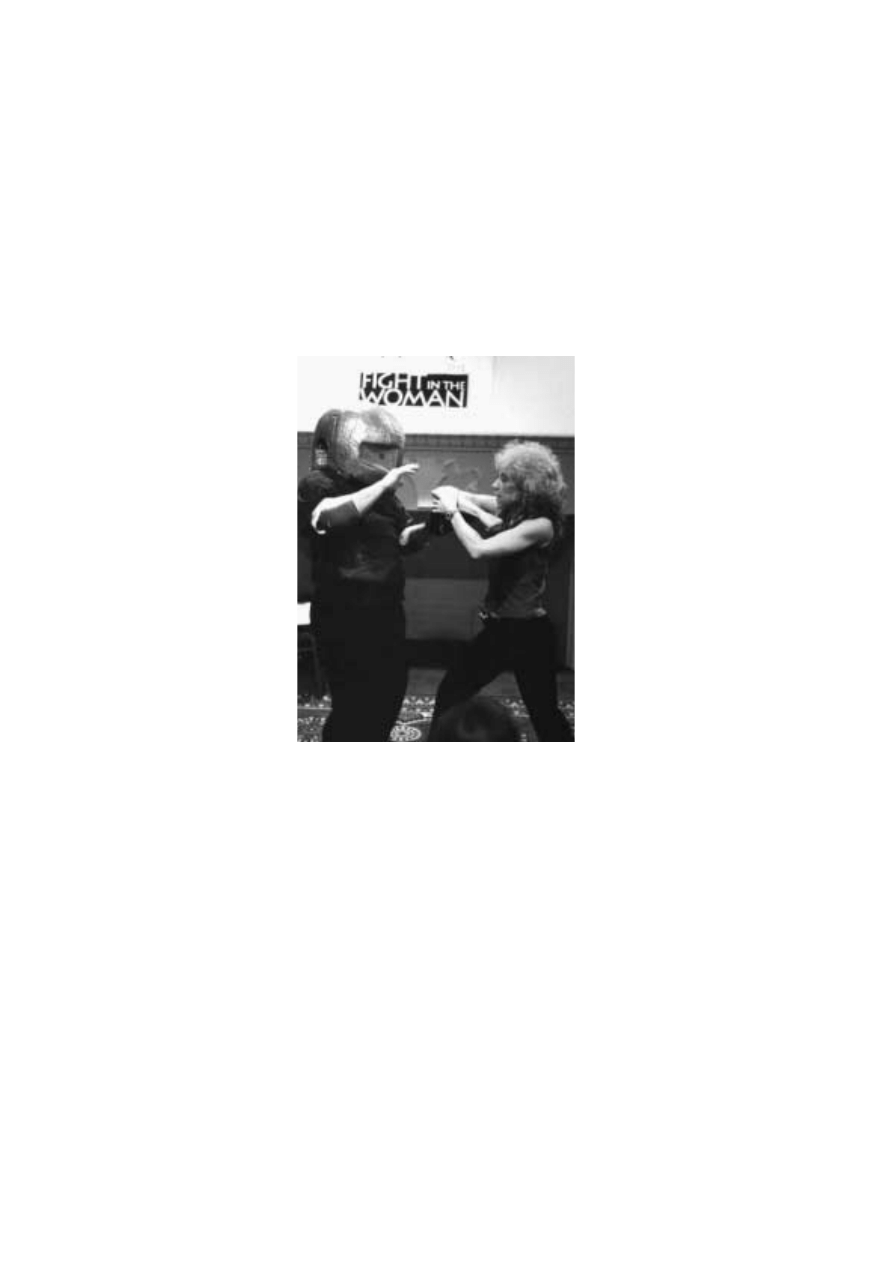
Healthy should equate with “ whole” but our culture, mired in dual-
ity, likes to pit ‘good’ girls against ‘bad’, sluts against virgins, glam
queens against the hairy legged, and has polarized an ideal of beauty
over beast. But cleaving the face of beauty from beast is a dangerous
split; it fractures women’s souls, diminishes our power and keeps us
tithed to a victim role - fearful yet dependent on men.
It isn’t just age old views that foster these either /or myths. In spite
of its ‘whole person’ claims, New Age culture perpetuates the divide
between femininity and
aggression. Gooey New
Age-ism
and
moon-to-uterus spiritual-
ity paints an insidiously
lopsided picture of women
as all beatific, all nurturing
creatures – and goddesses
of wisdom and compas-
sion – while downplaying
even disavowing women’s
innate aggressive nature
and
more
ruthless,
self-centered
predilec-
tions.
It softens our
movement and language
(“we don’t compete, we
best ourselves”; “we don’t
hate, we feel animosity”;
“we don’t want to wield
power, we just want power within”), quelling our bestial fire with
exchanges and a transcendent love-conquers-all philosophy of flow.
It’s drivel like this that sends me racing to Cosmo for a dose of real-
ity.
Connecting to a fierce, uncompromising primal nature and being
capable of harming, even destroying, what is life-threatening is as
much a part of the female’s heritage as her nurturing, life-giving
force. When women own this knowledge it shows and is a natural
repellent to would-be victimizers. They perceive: “This one bites!”
Political correctness (at least in the US) has also taken its toll in the
martial arts and self defense world. Even the once fired up women’s
self defense community has increasingly gone P.C. A growing num-
ber of schools are straying from their martial roots and no-nonsense
mission, toning down their more violent methods (and in some
cases subtracting their most effective and brutish techniques) in fa-
Introduction: Page 22

vor of a softer, more palatable amalgam that I call, “self defense
lite.” Careful not to offend (after all, empathy is in; aggression is
out) such groups trumpet conflict resolution sound bites, ballyhoo-
ing their verbal methods and teaching of “appropriate responses”,
while understating the brutality of attacks and women’s need for
swift and violent counter measures. In the context of self defense
the word “appropriate” is dubious; it carries a judgmental, moralis-
tic ring: Is it appropriate to physically strike back when an uninvited
someone cops a feel or two ? Is it inappropriate for a woman to
draw her gun on a violent ex who shows up in her building one year
later?
Of course one’s response should be proportionate and not invite
further violence. You don’t “dis” (mouth off at) a gun wielding
street thug, or deck a guy because he’s ugly and asks for your sign.
But victimizers don’t behave logically; when it comes to a woman’s
safety, appropriateness should not always warrant a vote at the table.
What matters is what is effective (and necessary) in stopping threat-
ening, violent or would-be violent behavior.
That women are victimized does not also mean we cannot or should
not be aggressors. Honor the Beast-Girl within. And keep the
force alive…
Melissa Soalt (a.k.a. Dr. Ruthless
®
)
Amherst, Massachusetts
May, 1999
Melissa can be contacted by either e-mail or phone as follows.
E-mail: fear2power@aol.com
Phone: USA: 413-253 1692
Reflex Violence: Page 23

RULES FOR FIGHTING: By Erle Montaigue.
• 1/. Never step backwards.
When you are attacked, do not do what most hard style martial arts
teach you to do, to step backwards as you block! This will invite cer-
tain defeat. Any fighters or brawlers all work on ‘switches’. We are
born with switches that tell us to do certain things subconsciously,
like a male puppy that, at a certain age begins to lift his leg, why? He
may not have seen any other dogs doing this but he does it anyway
as if some programmer has programmed a computer program into
his brain. This is not far from the truth. We are all born with
switches, those that tell us to cry, to begin crawling etc. Then there
are those switches that we learn from experience. It is the same with
the Qi that we are born with (prenatal Qi) and that which we gain as
we grow, (post-natal Qi).
A fighter learns certain switches as he becomes more and more expe-
rienced at fighting and aggression. However, these learned switches
can bring him unstuck in a fighting situation against someone who
knows about switches. The fighter learns these switches but also
learns subconsciously that his switches will also cause other switches
in those whom he is attacking, which will in turn switch on more
switches in himself. This is the way that a fighter works. He may not
know this and indeed it would be rare that any street fighter would
know about such things. So, when the expected switch does not
happen when he attacks someone, it throws his own switches out of
wack, thus putting his timing and coordinating off. This is where in-
ternal Gung-fu gains the upper hand. We know that the fighter ex-
pects us to react in a certain learned manner when attacked or when
faced with aggression. He expects us to move away from him trying
to lessen his attack. So he is ready for this and knows exactly what to
do when we do this expected movement. But if we do not, then he is
taken by surprise and before he has time to change his method, we
have already finished it.
Someone who is attacking you expects you to be where you are
when he attacks. Otherwise, he would not have attacked you where
you were. Someone throws a punch for instance, they do not throw
the punch to where they think you might be, but to where you are at
the time of the attack. Remember though, the attacker is expecting
you to either be there or move backwards. So even if you do move
back, he is ready for this and will launch another attack to compen-
sate for this movement. So, if you are not where he expects you to
Introduction: Page 24

be, and more important, if you are in his face attacking him, then he
is just not ready for this. He has to regroup and think about what he
has to do next, giving you time to attack with devastating attacks
from the internal Gung-fu system.
Often when we train in techniques or training methods, we will be
taught to stand still and not move. But this is only in the beginning
to get the movement correct. Once you have it, then you begin
training in a more realistic manner by moving into the attacker as he
attacks.
There is another important reason in for not taking a step backward
apart from the obvious physical advantages as I have indicated
above. And it is an ‘internal’ reason. The ‘primordial’ instinct for
survival is inside all animals including human beings. Ours has been
slowly lost over the years of depending upon others for our defense!
It’s still in there, but we just have to get at it in some way. Dogs for
instance have all kinds of primordial instincts like, at a certain age
when a male dog begins to lift its leg to pee. Why does it do this?
Well, we know why I guess, some chemical changes happen inside
causing the dog to have a need to mark its territory. But how it hap-
pens is a complete source of mystery and wonderment to me. Never
having seen another male dog, the puppy will always begin to lift his
leg at a certain age. He will also at this age, begin to attack, i.e.,
move forward into his ‘opponent’. In order to understand this, we
must also know a little about the ‘triune brain’, or the ‘reptile brain’.
The theory goes, that when God, was making us animals, he began
with his first creation, the ‘reptile brain’ which is that brain that all
reptiles have. It is a survival brain, totally relying upon instinct and
programming, no thought, only reflex reactions caused by its partic-
ular ‘computer’ programming. A snake does not ‘think’, it does not
love, hate or feel resentment etc., it just lives and survives. This is the
kind of brain that the snake has. We too have this brain! But it is
only 5% of our total brain size.
Then ‘God’ tried out a new brain for the more complex animals such
as mammals and we call this brain the ‘old mammalian’ brain. This is
that brain that dogs have for instance. A little more thinking for it-
self and some small amount of emotion even, but still much pro-
gramming and relying upon instinct and reflexive actions to stimuli.
The dog however is able to revert back to its ‘reptile brain’ any time
there is an emergency of survival. And it makes certain body changes
to enhance this effect to give it the greatest chance at surviving. Like
arching its back as all animals do including sharks just before they at-
tack. We in internal Gung-fu also make use of this when we are at-
Reflex Violence: Page 25

tacked. The animal also makes use of another area of helping it to
reflexively go into the reptile brain. That of always rushing forward.
You will only notice this phenomenon in those animals that are
closer to the source of ‘wild’ than many domesticated animals who
have also (as we humans) had this sense bred out! Like the Austra-
lian Blue Heeler dog that is part Dingo. He is one of the most coura-
geous small dogs on earth. Not because he is courageous however,
but because he is closer to the source than most dogs. There is in fact
an old saying with regard to this breed of dog here in Australia; “the
Blue Cattle Dog (the breed has several names and also comes in the
red variety), will eat anything it meets unless it is eaten first”.
The last and most sophisticated brain is the mammalian (human)
brain. But this brain did not replace the old mammalian or the rep-
tile brain, it simply was placed over the other two. So we as humans
still have the ‘survival brain’ and are able to access this animal brain
through training. This training is part of the internal Gung-fu train-
ing.
One way that we have to access this reflexive survival brain is to sim-
ply move forward as we are attacked. It triggers a switch that causes
us to attack and attack again! Just as an animal never stops its attack,
so too should we do the same. In my classes when I am teaching the
training methods, I have to begin by teaching them incorrectly! This
is because if I were to teach the correct way, .e., moving in as we are
attacked in training, we would have many more injuries! Moving in
seems to build up an attack energy that is often uncontrollable in the
beginner. Even the blocking type movements have far greater im-
pact when the reptile brain kicks in. And those are trained as ad-
vanced instructors that I allow to train in this manner.
• 2/. Never fight the peripheral attacking weapon, fight the whole body.
This is a big mistake made by many highly ranked martial artists.
They block the attacking arm or leg standing still! They do not move
into the attack as they block, they just stand there and block the at-
tack. If you can touch his arm, then you can touch his body and if
you can touch his body then you can strike him. Never wait for the
attacking portion such as a fist to reach you before you do some-
thing about it. See his whole body using ‘eagle vision’; react to what
his body is doing rather than to what his arm is doing. In order to at-
tack you, the attacker MUST firstly move his body. Try it now, try
punching without moving any other part of your body other than
your arm. If you are able to do this, you will have no power at all
Introduction: Page 26
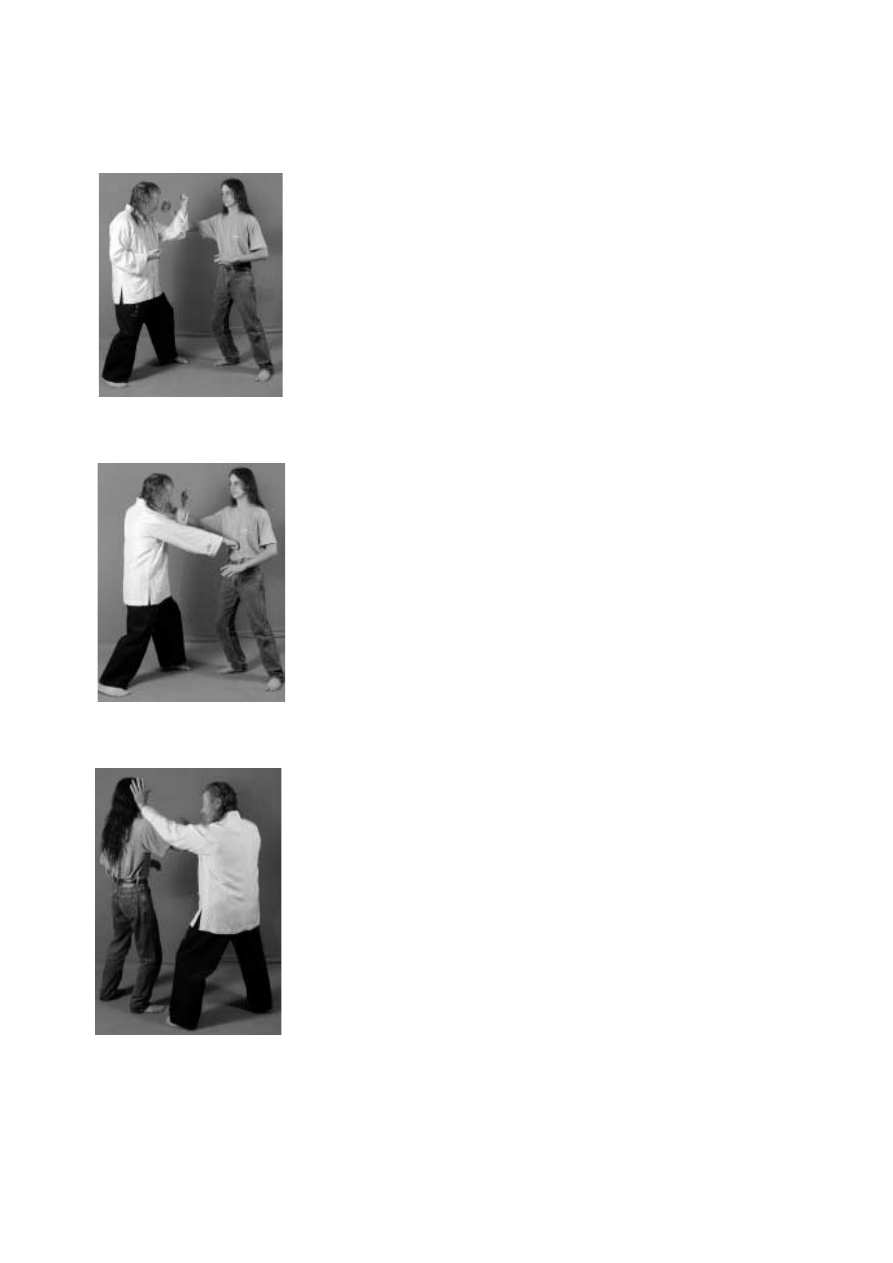
anyway! So we react to his total body movement not only his arm
or leg etc. The very instant he moves any part of his body, attack.
Do not worry about what he is going to attack with as his attack
will be totally minimized by the fact that you have moved in on him
and have closed him up before his attack has had time to even gain
any power.
• 3/. Never meet force on force, always move at a slight angle to the
attacker as you move in.
You must move in a ‘V’ shape to either side of the attacker. This will
give you deflecting power as well as increased attack power using
his power against him. Like a ricochet. If the projectile has nothing
to bounce off of, it will not have much power, but if it has some-
thing solid to bounce off, then its power will be great. The tenser
the attacker is, the more power you will gain with which to revert
back on him. This movement will also put you in complete control
because you have your ‘distancing’ correct by using this method. It
will place you at exactly the correct place to be in control of the at-
tacker. He will never expect you to do this.
• 4/. Never use two steps in fighting.
You must always make your defense your attack. Never block, then
attack, make your block your attack. His subconscious switches tell
him that you will attack next after you have blocked. But if your
block becomes your attack, he has not had time to think about it.
You have attacked him during the time that he is supposed to attack
you! If you block first, then it is his turn to attack because you have
asked him to attack now. This is the logical way of the fight, he does
something, then you do something, and then he does something.
You must change the logical fight into a totally illogical fight, so
that his switches are all broken down. Make it a fight of; he attacks,
then you attack, then you attack, then you attack! Never give him
that slight break when his brain tells him that it is his turn to do
something. Take his time away from him and use it for yourself. In
Photo No. 14
, who is in control of this situation? This is where I
have used a so-called hard style type of method of two steps. I have
blocked his attack and in
Photo No. 15
, I have re-attacked. The at-
tacker is still in control of this situation. However, in
Photo No.
16
, I have simultaneously blocked and attacked. Now who is in
control? I am. See how the distancing has placed me right in the at-
Reflex Violence: Page 27
14
15
16

tacker’s face in total control of his body. I am now able to attack at
will.
• 5/. Never look at the attacking portion.
Eagle vision is a marvelous way of using the eyes. Human beings are
so used to focusing on things that we see, that when we do this in
fighting we always lose! Why, because you can see much more by
not looking than you can by focusing. Eagle vision is that vision that
birds have. Humans have a completely different system of vision
than birds and it has to do with the way that we get blood to the eye.
But we can make use of the way that birds see. An eagle for instance
when catching a moving mouse, simply flies down and catches it. It
does not focus on the mouse, it uses a kind of peripheral vision to
lock onto the mouse’s space. Sort of like locking its Qi onto that of
the mouse. So if the mouse moves, so too does the eagle, the mouse
cannot escape unless it goes into a hole. You must see the whole
body of the attacker, and not just look at the peripheral that is at-
tacking you. In this way it does not matter what portion he is attack-
ing with, your body will reflexively adjust to the attack and always
come back with the correct answer. This is particularly important
when we are using dim-mak (death point striking) in a fighting situ-
ation. If we were to look for the points, we would always miss them,
as we just do not have time enough to look. But if we use eagle vi-
sion, we see the ‘shadows’ of the body, the little hollows where all
dim-mak points reside. We see shadows reflexively and are then able
to hone in on these shadows to pinpoint the dim-mak point auto-
matically without thinking.
• 6/. Never use a lock or hold as your main fighting method.
Locks and holds do not work in a realistic fighting situation. I have
discovered this aspect of fighting through my own experiences and
from that of others who have survived street attacks. It is all right to
use a lock to control an attacker once he has been disabled by using a
point strike or some other striking disabling method. However, if
you try to use a lock or hold against someone who is trying to harm
you, then you will lose the confrontation. This is especially impor-
tant in the street when it is not usual for only one attacker to be at-
tacking you! In these cases, you would never even attempt to use a
lock or hold as his friends would have a chance to attack you at this
time. Stun the attacker with a strike to the temple (GB 3) or another
Introduction: Page 28
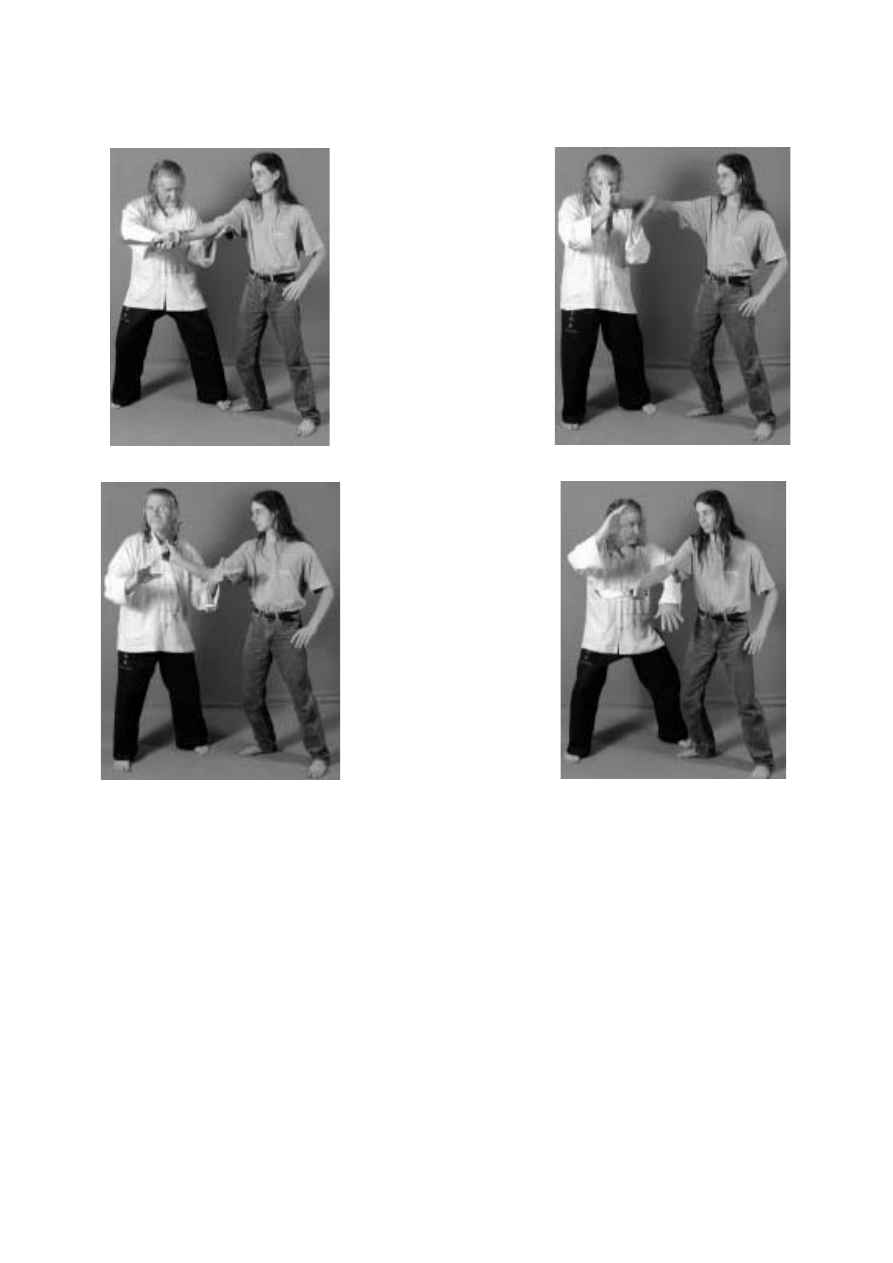
vital point, then you are
able to take a lock or
hold. This is greatly im-
portant when fighting
against an armed at-
tacker. Most schools
will teach that you
should grab the hand
that is holding the knife
or other edged weapon
for
instance.
These
methods work fine in
the dojo but in reality,
you are inviting defeat
and/or even death to
use such methods. You
must remember that an
attacker, especially one
who is holding a knife,
must be pumped up in
order to have the ag-
gression necessary for
such a deadly attack. So
grabbing his arm is not
going to stop him. In
the dojo, you might be
able to use a technique
such as in
Photo No.
17.
But if the attacker is
serious about doing you
harm, and he knows
what he is doing, he will
probably make use of
his yang energy to rip your hands and arms to shreds before bring-
ing the knife back to kill you.
Photo No. 18. & Photo No.19
.
In the case of an edged weapon remember the three words; evade,
bump and attack. Without writing a whole book on knife defense it
goes something like this.
Evade: He perhaps attacks using a lunge. (The same methods work
for any type of weapon attack from anywhere). Using a ‘hinge’ type
of weapon, you move your body out of the way by slightly turning
to the side as you slam his arm so hard that it damages his arm
bumping his weapon arm out of the way for that split second.
Photo No. 20.
Notice that my right palm is already up ready to
Reflex Violence: Page 29
17
18
19
20

strike to deadly vital points. In doing this you have done the
first two of the words, ‘evade’ and ‘bump’. You have also stuck
to the above rules of never backing of and never using a
one/two type of method. Your defense has become your at-
tack. Now I am able to strike using deadly methods to points
that will either kill or drop him.
Photo No. 21
. Then, and
only then, when he is down and out should you take the knife.
The ‘hinge’ type of attack is also one of those that will bring
up the reptile brain causing your energy to build up to a high
level for the final attacks.
Using the reptile brain, every time you touch the attacker,
your own energy will grow to cause you to want to continue.
Your own energy system will be enhanced by the fact that you
are borrowing his energy and sending it back to him. You are
using only one bit of energy and recycling it. In this way you
do not feel tired having to block, then build up more energy
for the next attack etc. Your first lot of energy (Qi) is reused through
the attacker’s body draining him of energy and building yours up.
• 7/. Never use pushes or pulls in self-defense.
This may seem contradictory as most people view Taijiquan for in-
stance as having many such techniques. Bagwazhang and
Xingyiquan (H’sing-I) do not have this idea though. I think that the
idea that Taijiquan has many pushes and pulls comes from the incor-
rect idea that the training method of ‘push hands’ is in itself a martial
art or self-defense art. Or in some way a fighting technique. How-
ever, push hands should never be thought of as a fighting art by it-
self. It is only a training method that teaches us timing, balance and
how to move the body when attacked. The attacking methods in ba-
sic push hands are only there to take the place of the more realistic
types of attack and defense so that the practitioners do not harm
each other. So if pushes and pulls do not harm people, why use them
for self-defense? The only time you could use a push or a pull is to
put the attacker into the line of an oncoming car. The pushes are
only there in order to teach the very dangerous dim-mak point
strikes inherent in all Taijiquan forms. However, you will still see ar-
ticles in prominent magazines on so-called Taijiquan self-defense
methods where the practitioner will use a pull or a push to defend
against attack! It is my advice to leave a class immediately the
teacher begins to teach you to do this is a realistic fighting situation.
He is being fraudulent in teaching self-defense that isn’t. And it is
dangerous for students to have a false sense of security instilled in
Introduction: Page 30
21
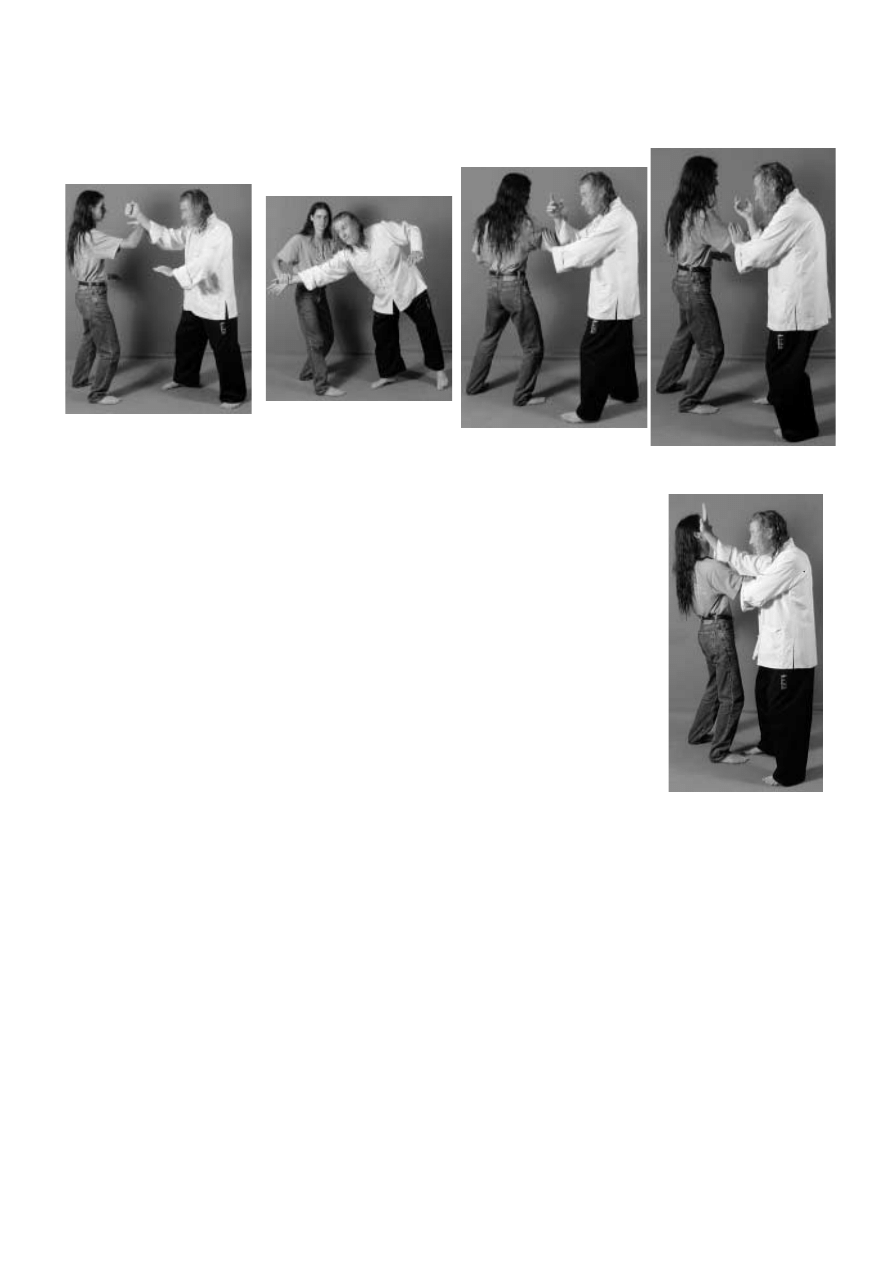
them by using these inane fighting methods in
the class. Sure, they might even work to some
small degree in the class, but it’s a completely
different matter in the street when the attacker
is really trying to get you! I have seen teachers
teaching small framed people to use techniques
such as ‘Lu’ (roll back) in defense against an at-
tacker. He attacks with a punch so the attackee
defends using P’eng,
Photo No. 22
. Then he
takes the attacker’s arm and uses ‘roll back’
Photo No. 23,
to put him face down in the
dirt! Anyone who would use this type of de-
fense for real is inviting disaster. But this all co-
mes about from teachers not knowing the
advanced methods of Taijiquan like the ‘small
frame’. Moves such as ‘Lu’ (roll back) take on a
completely different meaning when used in the small frame mode. If
we again take the above scenario when we are attacked by someone
with a right straight punch, we might again use P’eng. However,
this time we do not move backwards, but rather move our weight
forward as we do this thus putting his timing off.
Photo No. 24
.
Now, in small frame mode we use ‘Lu’ but very quickly to deflect his
power and again as we are still moving forward. We do not use it to
pull him forward, only to deflect his energy for a split second, thus
causing him to have to try to move back to regain his balance.
Photo No. 25.
In this window of opportunity, we should attack
with devastating point strikes to vital points on his head and neck,
like ST 9 (stomach point No. 9) using the right palm, and next to
GB 3 (gallbladder point No. 3, temple) using the right elbow.
Reflex Violence: Page 31
22
23
24
25
26
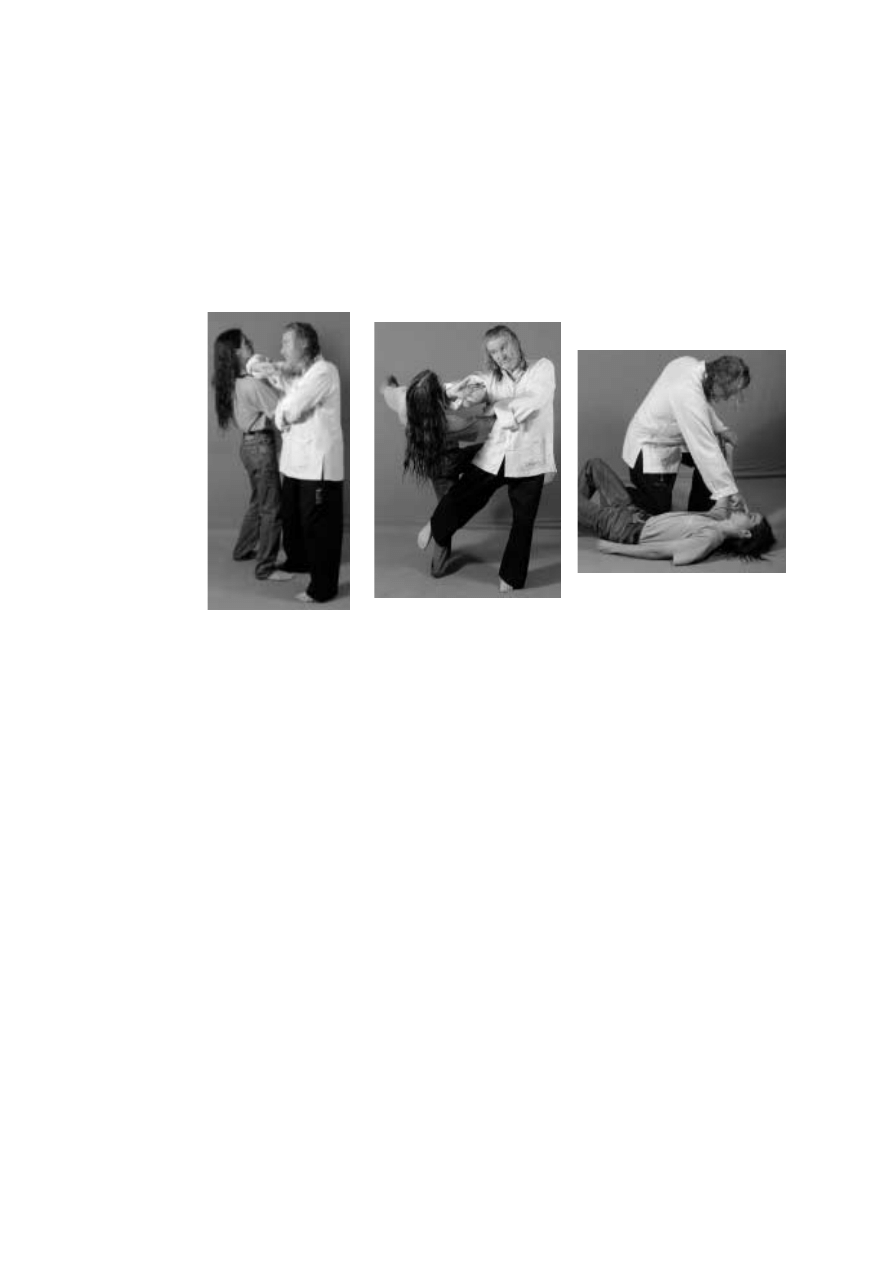
Photo No. 26 & Photo No. 27
. We could finish this if he is alone
by now, and only now, taking him down using our right leg while
thrusting the right elbow across his neck.
Photo No. 28
. Following
this with fingers to the eyes while on the ground to completely con-
trol him.
Photo No. 29
. This last method would of course only be
used if you were only being attacked by the one person.
• 8/. Never go to the ground.
I have always said to my students that if someone is able to take you
to the ground then either get a new teacher or learn better and train
harder! Many people nowadays have the wrong idea that fights usu-
ally end up on the ground. Well, yes, but only if you do not know
how to fight! Grappling is great, but not if the attacker has friends!
And this is usually the case in most street attacks that I have been in-
volved in. You have everything there in your internal Gung-fu style
to defend against grappling type attacks, learn to use your art cor-
rectly.
• 9/. The legs are for standing, the hands are for fighting.
It is a big temptation for the beginning martial arts student to learn
fancy kicks in order to show his friends that he is doing a martial art.
But in reality, kicks of any kind will put you at a disadvantage. Leave
the fancy kicks for the films and use your hands for self-defense.
Once you even lift your leg to kick at a low target, you are at a disad-
Introduction: Page 32
28
29
27

vantage and most students just have not done the time training to be
able to allow the legs to take care of themselves while the hands do
their work. And if you must kick, only kick from the knee down-
ward. Use short chopping type kicks, those that do not require great
balance. And if you must kick, always kick from the front leg! This is
contrary to most hard style martial arts as they always kick from the
rear leg in order to get the power. However, internal Gung-fu has
ways to gain power using correct body structure even kicking from
the front leg. The attacker, if he is used to fighting will expect you to
kick from the rear leg and will see it coming. But he is not used to
being kicked from the front leg and cannot see it coming. Bagwa has
a wonderful training method called the ‘8 kicking method’, which I
introduced in my Book on Baguazhang published by Paladin Press
in the USA..
I will be giving more ‘rules’ as the book progresses but these will be
specific to certain training methods.
The above rules will give you some idea of how the Erle Montaigue
system works. It might sound different to what you already know.
However, these rules have been tested many times over many years
in real situations.
The Fighting Methods in this book will be arranged in ‘Fighting
Sets’. Fighting methods that have a common link will fill each sec-
tion. The first set for instance (Set One) will concentrate upon cen-
trifugal methods making the most use of your whole body in the
easiest way. All of my fighting system makes use of the waist and
centrifugal and centripetal movements, but there are some that are
easier understood than others. So the sets will go from the easier sets
to the more difficult. However, I will not be presenting very compli-
cated movements unless any particular set of movements is particu-
larly good for training. Most of the techniques will be direct with no
fuss, using the easiest and shortest route to the target. And I will
only present those techniques that work and which will help you in a
real situation. The more advanced methods are only advanced be-
cause they rely upon more of the internal way with very little body
movement. The body movement is there of course as it has to be,
but it has become so small that it is difficult to see physically with
90% of the movement being internal.
Reflex Violence: Page 33
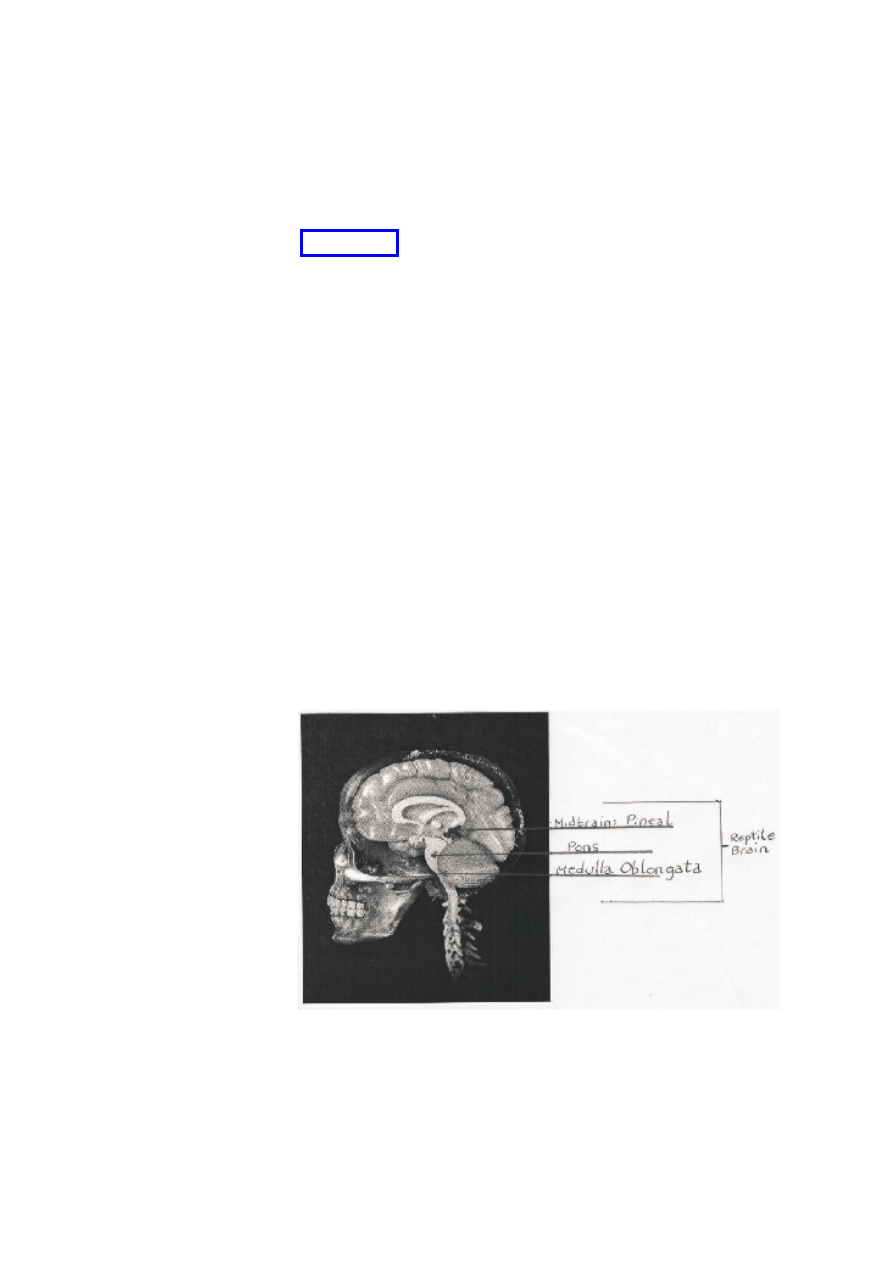
Getting in Touch with your Reptile Brain
Chapter One
W
hen I introduced the concept of the Reptile Brain to the
martial arts community many years ago, many were en-
thralled, many were skeptical. Once upon a time, the
mention of the ‘reptile brain’ would bring tumultuous laughter
from most of the scientific community. Nowadays however, it is
a different matter with this area of the brain now being recog-
nized by the wider scientific community. It even has an area of
the whole brain allocated to it. The reptile brain is actually the
‘brain stem’ that area of the base of the skull that holds so much
significance to we in the internal martial arts.
The brainstem (Diagram No. 1) is the portion of the brain
comprising the medulla oblongata, the pons, and the
mesencephalon (midbrain). It performs motor, sensory and re-
flex functions and contains the corticospinal and the
retriculospinal tracts. The 12 pairs of cranial nerves from the
brain arise mostly from the brainstem.
Chapter One: Reptile Brain: Page 34
The Brainstem

To break it down into its individual components we also see that
they are widely used in sensory stuff.
The pons is located in the brainstem, vertically between the
midbrain and the medulla oblongata, and sagittally between
the cerebellum and the pituitary gland. It is responsible for
serving as a bridge (“pons” means “bridge”) between the cere-
brum, the cerebellum, and the medulla oblongata. By serving
as this liaison between the different parts of the brain, the
pons is able to facilitate coordination between the functions of
the two sides of the body as well as those of the face and jaw.
The origins of the fifth through eighth cervical nerves are as-
sociated with the pons.
The medulla oblongata is the lowest part of the brainstem and
serves as the site of connection between the brain and the
spinal cord. Located just above the foramen magnum in the
skull and in front of the cerebellum, the medulla oblongata
contains a number of nerve centers, which are responsible for
controlling involuntary processes such as the heartbeat,
breathing, and body temperature regulation. It is only about
an inch (2 ½ centimeters) wide and comprises less than one
percent of the weight of the central nervous system. In spite of
its small size, though, it is integral in the transmission of nerve
impulses between the spinal cord and the higher brain. Many
of the nerve fibers that pass through the medulla oblongata
cross over, so that many impulses from the right side of the
brain control functions on the left side of the body and
vice-versa. Thus, any injury or disease in this area is often fa-
tal.
The Mesencephalon is one of the three parts of the brain
stem. It is mostly made up of white matter with some gray mat-
ter. A red nucleus is in the mesencephalon. It contains the
ends of nerve fibers from the other parts of the brain. Deep in-
side the mesencephalon are nuclei of several skull nerves.
The mesencephalon also contains nerve nuclei for certain
hearing and seeing reflexes. Also called midbrain.
The function of the pineal body, or gland, within the midbrain
is not fully understood. It is generally believed to be a vestigial
(no longer used) sensory organ, which is incompletely devel-
oped, in the modern anatomy. The term “pineal” means “pine
cone shaped.”
• A note one the above.
It is this humble dabbler in medical science that we are able to get
back the original function of the Pineal gland, like communica-
Reflex Violence: Page 35

tion at a much higher level than just speech and communicating
with the earth such as dolphins, whales and seal are able to do.
We can do this by practicing Qigong and the internal martial
arts. Back when science didn’t help at all, the ancient Chinese
would simply say that when we do Qigong, we get back to nor-
mal, or what we should have been had we not been so reliant
upon speech, travel, radio waves and television in modern times.
Obviously, when a part of the body is not used, it becomes use-
less, like a leg muscle that has to be re-trained after a long illness
of inactivity. We use our Pineal gland very rarely and on the odd
occasion that it does work, we are amazed and call it coincidence
or ESP. etc. These things should happen all the time but we have
little use for real communication skills because it’s so easy to pick
up a phone or to watch the news on the TV. Qigong helps our
Pineal to work again by getting in touch with the ‘ground’ and
‘ground Qi’. This is the reason that in all internal martial arts, we
are told to do nothing! This does not mean that we do not move
or look or hear, but it means that our conscious brain rests while
we practice thus giving our so-called extra-sensory organs a
chance to reestablish themselves within our framework. How-
ever, it is not that easy of course as it takes much training before
we are able to perform movements that are alien to us at a
sub-conscious level. Hence the saying that it takes years before
one advances in his or her Taijiquan training. It only takes a short
time to learn the basic movements of Taijiquan. However, they
are only that, movements! We must take these movements to a
much higher level, a sub-conscious level so that they become like
everyday things, like breathing or our heartbeat, they must the
THAT automatic.
The reptile brain is that brain, part of the ‘Triune Brain’ that we
use for survival; it is our oldest brain with the ‘Paleomammalian
Brain’ (known as the “Limbic System” since 1952) being next
and the youngest brain is called the ‘Neomammalian Brain’. All
reptiles have the Reptile Brain, all mammals have the
Paleomammalian Brain plus the Reptile Brain but it is only the
higher Mammals such as humans that have all three brains.
Paul D Maclean in his exemplary work on the “Triune Brain”
says of the Reptile Brain: “The remaining brainstem and spinal
cord constitute a neural chassis that provides most of the neural ma-
chinery required for self-preservation and the preservation of the spe-
cies”.
The three brains however, should not be thought of as standing
alone and having three separate functions. Although they do
have different areas that they control, they also work in total har-
mony with each other. As each brain was developed, it was
added to rather than discarding the older brain in preference for
Chapter One: Reptile Brain: Page 36

the newer one. So the newer brains enhanced the older brains
rather than replaced them. The Reptile brain is that brain that we
use when we are first born; it is our survival brain. We cannot
learn with it we can only survive with it. Experiments with ani-
mals where their Paleomammalian Brains have been removed,
(decerebration), have shown that with only the Reptile brain,
they will still have motor functions but cease to be themselves,
they will only stand or sit in one spot until they die! If forced to
eat, they will live however, or if stroked, they will move around.
But all learnt stuff is lost. As we grow to about age 4, (some chil-
dren develop quicker than others however), our artistic part of
our Limbic system (Paleomammalian Brain) kicks in and we be-
gin to discover things and to learn about how things work etc.
This part of the triune brain is used for play and children learn
from play. It is very difficult to teach children of this age about
math’s and science, reading and writing etc. To do so is to their
later detriment, they lose something! The Paleomammalian (Old
Mammalian or Limbic System) Brain sees 3 main differences to
the Reptile brain. Nursing in conjunction with maternal care,
audiovocal communication for keeping in contact with offspring
and play. Both boys and girls between the ages of around 4 (it
can be earlier) and 7 develop a maternal or paternal instinct,
playing with dolls or cuddly animals, putting them to sleep, feed-
ing them in play etc. Play can also be regarded as the way to learn
about artistic stuff. Emotional behavior is also evident in the
Paleomammalian Brain.
At the age of around 7, the logical part of our brain kicks in
(Neomammalian) and we then begin to learn about things like
reading, mathematics etc.
In his great work, Paul D Maclean tells us: “Compared with the
limbic cortex, the neo cortex is like an expanding numerator, bal-
looning out progressively in evolution and reaching its greatest
proportions in the human brain.” The Neomammalian brain
seems to be primarily concerned with the ‘external world’. It has
developed highly in the area of problem solving (mathematics
and science etc.) learning and detailed memory.
This is all now scientifically known so it is anyone’s guess why
we try to teach our children at ages 4, 5 and 6 (or younger),
mathematics and reading and writing! Children before the age of
7 try to use their artistic side of their brain to do the work of the
logical side because we force them to do this by sending them to
schools that insist on teaching logical things before the brain is
ready. It’s like trying to tighten a nut using the wrong kind of
spanner, it can be done, but what happens to the nut? It gets
burred and eventually is made useless causing us to have to cut
the nut off! And that’s what happens to a child’s artistic side
Reflex Violence: Page 37

when we force them to do logical stuff too early, and they lose
their artistic abilities. Schools such as the Steiner system try to
address this by not teaching logical stuff like mathematics and
reading before the age of 7 but rather concentrate on what the
brain of that age does best, playing and as such, the child reaches
adulthood a much more balanced person with art and logical
stuff equally balanced. It is my view that if you are able to, do not
even send your child to school before that age of 7 and better still
not at all! Children will teach themselves by playing if given the
correct tools. To quote myself from an earlier book, “Children
just learn.” That is what they do and by forcing them to ‘learn’
stuff that they cannot, then we will hinder their real learning
about life. It’s great to be a great scientist, but not if it to the det-
riment of the child’s/adult’s life!
Everything that we learn from age 2 to age 7 is what we will
know. It doesn’t take much; perhaps we give our small child a
toy piano who then bangs away on it. That child has now learnt
how to play piano! Once the child gets to around 7, the
Neomammalian brain takes over and then he or she can learn the
technical abilities of playing piano. However, if that child did not
have any contact with any kind of music up until the age of 7,
then they would never learn to play piano. Sure a person can
learn the technicalities of where to put the fingers and what notes
mean what fingers etc., but they will never advance beyond the
technically perfect stage. The pianist who learns in this way is
able to use the Neomammalian brain to learn to play piano, how-
ever, there will be no ‘soul’ in the music, no art, it will be all tech-
nical. Same for all the arts, give a child a pencil and some
paintbrushes, some paint and some paper and their
Paleomammalian brain has learnt how to draw and paint. When
they get older, it is a relatively easy task to teach that person how
to really paint and perhaps become great at art.
When a child learns in this way, through play, once the
Neomammalian brain kicks in, it is a matter of then learning the
technical aspects of their chosen field. Once this has been estab-
lished, the brain adjusts itself by producing more of the required
cells for that particular required field of study. So, if we were able
to, it is my thought that we would see a totally different brain,
cell wise in for instance the brain of Einstein and that of Mozart
because their brains have developed themselves in different di-
rections and needing different cells.
So the more ‘play’ things that a child can have at an early stage,
the better he or she will be equipped in later life to take on a
number of fields and excel greatly at one or even two. Logical
things like mathematics can also be a game whereby the
Paleomammalian brain is able to learn, just as long as it is a game
Chapter One: Reptile Brain: Page 38

of counting for instance. But mathematics for mathematic’s sake
has no reason for being! Writing for the sake of writing also has
no reason for being. However, science is all-around children, ev-
erything they do is science, they discover stuff and that is science.
The Reptile brain is where all of our ancient memory is stored,
things like past lives, who we were and who we are, what we did
and what happened to us, it’s all there for us to tap into if we
wish to. Why would we want to do this? It is many people’s be-
lief that stuff that happened to us in previous lives shows up on
out current physical body. Like a birthmark that could possibly
be linked back to when a previous incarnation was flogged for
stealing a loaf of bread? So if we can get in touch with that mem-
ory that is causing the birthmark, then this is the first step in re-
leasing the anguish caused by that ancient memory. The
birthmark will not go away of course (many however believe
that even this will disappear), however, the pain caused to our
subconscious mind will be taken away from our knowing why.
And any modern physical or emotional damage is usually easily
fixed by allowing the patient to see why they are in such a mental
state.
When a child is born, it has to rely solely upon instinct and sen-
sory stuff and reflexes. The child has no way of learning what is
right or wrong. So it is little help to slap a child or chastise it in
any way until it’s next brain comes into play so that is able to
learn. When a child is slapped while still in the reptile brain
mode, its only recourse is to go into survival mode (reptile brain
mode) and as it cannot fight back, only cries! So how stupid is it
to slap a child or to shake it to teach it a lesson when it has no way
of learning!
Science now tells us that the reptile brain is that part that is in
charge of these things. A child for instance knows nothing about
the fact that if it fell off a table it would hurt itself, but if this hap-
pens, it will make an attempt to grab or in many cases it will not
venture past the edge of the table. Why, because the reptile brain
is looking after it.
Normally, there is no need to access the reptile brain in normal
life. However, in order to learn properly the internal martial arts
we must have access to this brain. It causes us to stand out from
the so-called hard styles, as there is no mention of the reptile
brain in any hard style that I know of. Hard styles are ‘hard’, they
cause someone to be continually on the lookout for danger, and
this is because hard styles are purely physical with little or no in-
ternal aspect. In the internal arts, we are taught that we are nor-
mal people, artists, writers, poets, schoolteachers, mechanics,
Reflex Violence: Page 39

mild-mannered reporters etc. And we do not have to be tense
and aware of an attack at any time! If an attack does happen our
reptile brain kicks in and we are into survival mode becoming a
raging animal fighting for our lives, with our physical conscious
brain totally unaware of what is happening. We have of course
done the training to cause our body to react with the correct
movements but these have been done so much that they are now
reflex actions that work independently from the conscious brain.
So an internal stylist does not LOOK like a martial artist because
he or she does not have to! We can be totally happy in knowing
that instinctive survival mode will kick in at the right time taking
care of business and not allowing our artistic brain to be affected
by this confrontation. To this end, the internal martial arts of
Taijiquan, Bagwazhang and Xing-I Ch’uan have all been devel-
oped to cause the body to move in a self-defense manner auto-
matically and reflexively.
Western science now accepts that we have a reptile brain, so
much so that the rule in judging whether or not someone is clini-
cally dead is to find out if the reptile brain is still functioning by
sending out electrical waves. If it is not, then the person is dead!
Babies cannot be children and children cannot be adults because
of the development and use of the different brains from birth.
Babies cannot talk, they cannot talk physically because their lar-
ynx is in the wrong place! Once the ‘Limbic’ system or Old
Mammalian brain kicks in, the larynx drops allowing babies to
begin to speak at around 13 to 15 months or thereabouts. Its
amazing isn’t it. And they tell us that all of this has evolved! Give
me a break, the human body is just so amazing that it defies even
thinking about. In fact, I often get a little depressed to discover
that we are really only a machine put together by some awesome
thing, God. Like the ‘balance mechanism’ deep within the ear.
Wow, but this really give me the shivers when I think about it.
Three circles filled with liquid that tell us where our balance is by
the action of this liquid rolling over tiny hair that then transmits
the information to the brain! A feat of engineering that only now
we are beginning to understand. One circle is vertical and turned
90 degrees to another vertical circle with a lateral circle in the
middle which can then tell us exactly to within one degree how
steep something is for instance and how our balance will cope
with this. We have this particular ability from birth and works
from the Reptile Brain for survival. A baby will not crawl down
a hill that is too steep. Why? It does not know scientifically that
the hill is steep but relies solely upon reflex actions from the Rep-
tile Brain to tell the body not to go down that steep hill. But if
the hill is not that steep, the baby will crawl or even turn back-
wards to go down the hill.
Chapter One: Reptile Brain: Page 40

Humans along with Chimpanzees and the whale family are
among the very few animals that are able to recognize themselves
in a mirror. But a baby only gets this ability once the Limbic sys-
tem kicks in. Animals cannot cheat and lie but humans will do
this as the final brain, the Mammalian brain begins to work, this
is the downside of being a human. We are told that those chil-
dren are the most intelligent who will lie the most. However, it is
my belief from experiments of my own that this all depends upon
the child’s parents and the way the parents relate to that child. If
the child is brought up in an atmosphere where there is no fear,
then that child will tell the truth no matter what. Because there is
nothing to fear in telling the truth! However, if a child is con-
stantly chastised for breaking things or doing something ‘wrong’
then it will have reason to lie!
Qigong & The Reptile Brain
The region of the reptile brain (brainstem) is one of the most im-
portant areas for Qigong and Dim-mak. In Qigong it is used to
help us to go into the reptile brain where we are in survival or re-
flex mode allowing the body to heal itself or to help us to heal
others. There is a good ruler as to whether or not you are doing
your Qigong correctly and it has to do with the Reptile Brain.
When we are taught the basic standing Qigong, we usually begin
by getting used to all of the new physical things that we are faced
with and are feeling. Like the shakes that accompany the stances.
Once over this area and we are faced with a mild vibration which
is quite pleasant, we feel the Qi ‘lifting up’ the back and being ac-
tivated at the points known as GB 20 (gallbladder points No.
20) just below the base of the skull. We feel something lifting up
and ending at these points, like a sensation. Everyone’s sensation
is different so it is difficult for me to tell you what to feel, better
for you to feel it yourself. But be warned, you MUST do Qigong
correctly and that means that every tiny peripheral is in its correct
place, the weight is placed exactly in the correct place, the head is
held correctly, the breathing is being performed exactly and so
on. I recently heard from a chap who had been doing so-called
Qigong with some ‘master’. He complained that he felt ill after
every session and his mind was scattered afterwards. So I sent
him my Basic Qigong tape so that he could see exactly what he
was doing wrong. He discovered that just about everything he
was doing was wrong and thus having a detrimental effect rather
than a healing effect! The worst thing that most people do when
learning Qigong is to place the weight over the balls of their feet
right onto Kidney One point. This is the most damaging thing
Reflex Violence: Page 41

that one can do as it causes ‘adverse cyclic Qi’ to be generated
which can damage the reptile brain! Not many ‘masters’ realize
that KD 1 point is NOT the activation point for KD one. It is the
area of the heels that activates KD 1 point on the foot, the energy
input point for ground Qi. So when we place weight onto KD 1
point, it actually stops the Qi from entering into the body. How-
ever, if the ground Qi did not enter the body we would die, so it
must come in somehow. So, it builds up to such a degree that it
comes through in violent bursts, which reach right up, into the
reptile brain damaging it! This is the reason that many people ex-
perience violent shakes and body movement while standing in a
basic Qigong stance. Many ‘masters’ say that this is powerful, but
they are wrong. The weight must be placed upon the heels thus
leaving KD 1 point free of all tension and allowing a moderate
and balanced flow of Qi to enter the body gradually, thus en-
hancing the reptile brain.
We are always told to ‘sink the Qi’. But why? The reason is that
only in this way does the Qi turn into ‘jing’, a more purified and
evaporated type of Qi which is then able to flow to all parts of the
body, condenses and settles into the marrow as fat enabling our
body to produce more ‘T’ cells for our immune system. In ‘sink-
ing’ we allow the ‘activation points’ for the Reptile Brain to
work, activating the Reptile Brain. The very instant that you be-
gin to discover ‘sinking’ or as the Chinese call it, ‘Sung’, you will
feel the reptile brain come into play. For a short time, you feel in-
vincible but do not worry that will go away, leaving you with a
feeling of well-being because in this condition, your body is free
to do what it has to without external tension and the Reptile
Brain is free to help you to survive. Survival does not only mean
survival against physical attack, but also against disease and
pathogenic attack. Tension is one of the greatest things that af-
fects the well being of the Reptile Brain so Qigong is able to help
the Reptile Brain do its subconscious work unhindered by ten-
sion. All of your glands will be able to do their allotted work.
Your Thymus gland, which is in charge of balancing the Qi, will
not shrivel up as it does in most people at age around 15. The
Thymus gland is more susceptible to stress than any other gland.
When we are younger and have not much adult stresses placed
upon us, this gland is large and healthy, a tuber shape reaching
down from CV 22. So when we begin to get rid of stress, this
gland comes back again to control our flow of Qi again. By be-
coming aware of the Reptile Brain we also activate and assist the
Pineal gland, which is also responsible for our perception of na-
ture and the things around us and our place on the planet. So it is
not unusual for this gland to increase in size. There are some ani-
mals whose size of this gland is half the size of their total brain at
birth enabling them to be totally aware of their environment
from day one and be in total survival mode.
Chapter One: Reptile Brain: Page 42
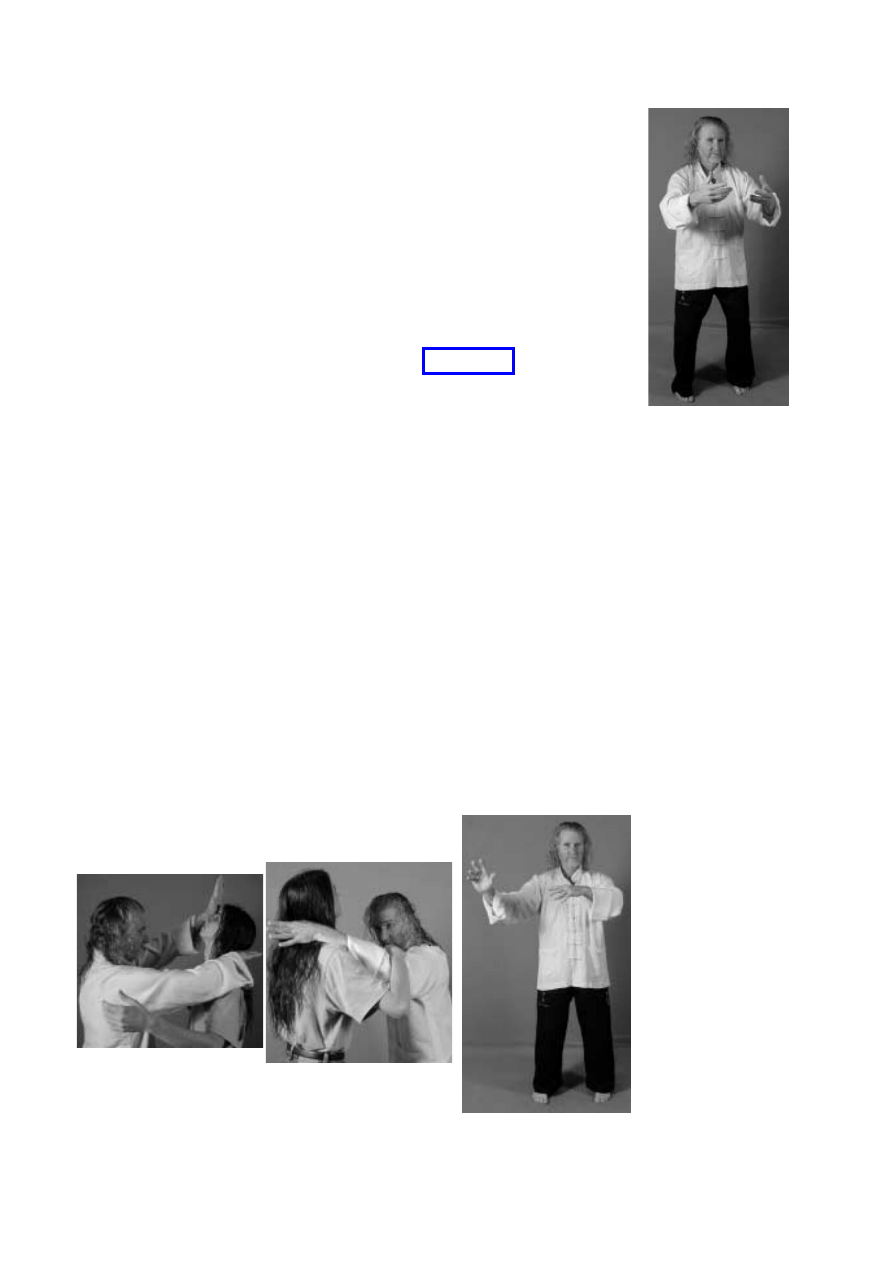
So while many people do Qigong simply
to become more relaxed, they do not
know that this ‘simple’ exercise is one of
the most beneficial that anyone can do to
enhance the Reptile Brain, hence enhanc-
ing the workings of the whole body. See
Photo No. 30
for the basic three circle
standing Qigong stance.
Dim-Mak & The Reptile Brain
In the Dim-Mak area we strike more to
the brainstem than to any other area
other than to the front of the neck and the front of the neck is
simply another way of getting to the reptile brain area. Deadly
points such as GB 20, GB 12, GV 15 and 16 are all in the area of
the reptile brain. When the reptile brain is kinked by either jerk-
ing the head forward violently
Photo No. 31
or by striking it,
the person’s conscious brain shuts down causing knock out as
the other two brains cannot function if the reptile brain is not
working properly. I once tapped a person lightly onto the reptile
brain area in workshop conditions and he was on the ground so
quickly that I never again did that kind of strike, it was so effec-
tive! The reptile brain area is easily accessed when for instance in
a grappling situation when we have closed with the attacker and
are able to get one hand around the back of his neck, just a slight
tap just under the skull is enough to put him down. The direc-
tion of this strike must be slightly upward into the skull using
perhaps a reverse
knife-edge strike.
Photo No. 32.
Another way is to
use the Taijiquan
method of “Arn
Left or Right”
Photo No. 33
.
We take an attack
from the front for
instance from the
attacker’s
right
fist, slam it with
our left palm as
the right palm is
sneaking up un-
derneath our left,
Reflex Violence: Page 43
30
31
32
33
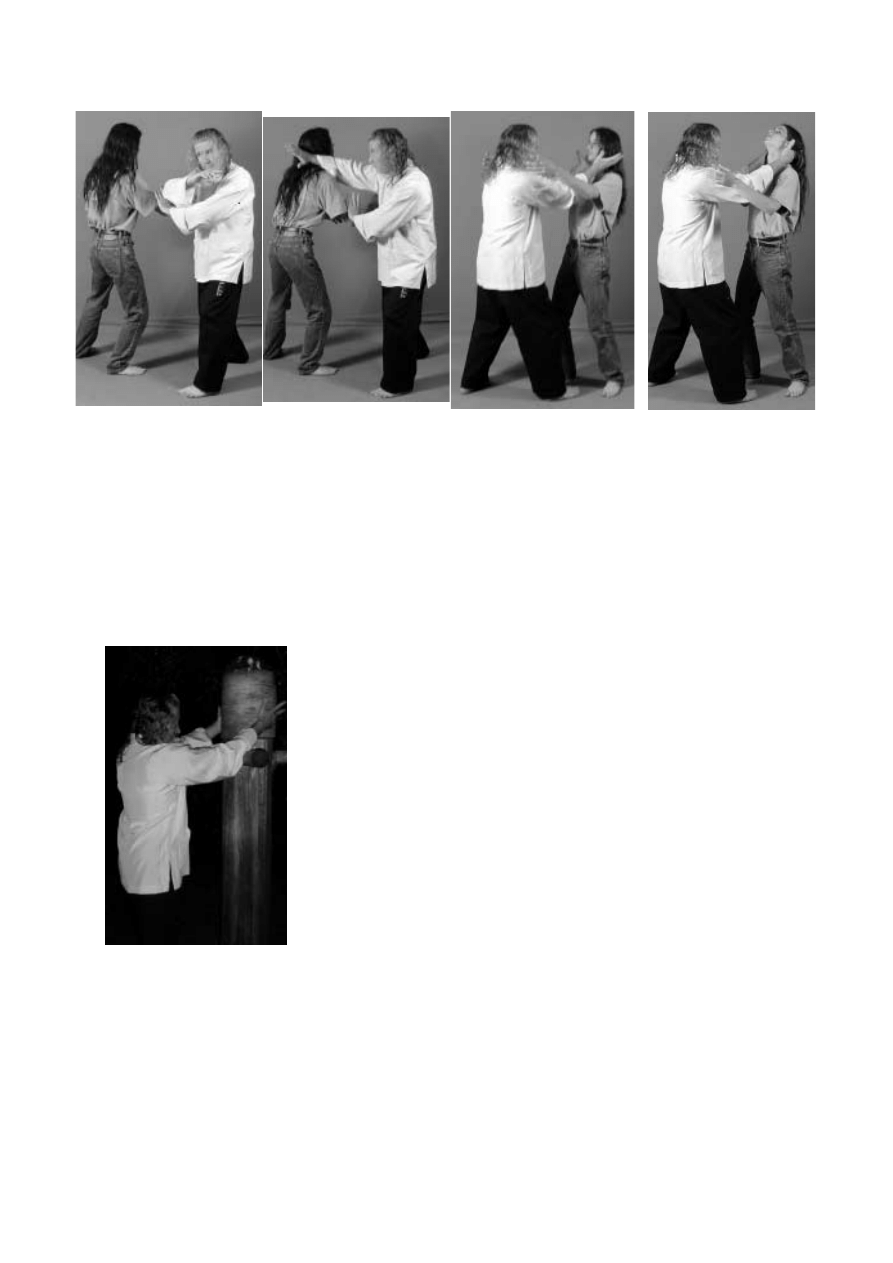
Photo No. 34
, and strike in from behind with the right
knife-edge palm as we step slightly to the left.
Photo No. 35.
Or
for a more deadly attack to the Reptile Brain, you could use a
Bagwazhang method of overkill thus: An attack comes in using
both hands as in the attack of a grappler. Both palms slam his
both arms outward and glance off into either side of his neck.
Photo No. 36.
Your both palms immediately hook around the
back of his neck and jerk forward violently, thus kinking the
brain stem causing death in this instance!
Photo No. 37
. This
method is taught during the “Mighty Bagwa Wooden Man”
training from the seventh method.
Photo No. 38.
We also use the Reptile Brain to assist us in fighting, or rather
survival when attacked. Animals such as dogs who have the ‘Old
Mammalian Brain only have to go back one brain in order to sur-
vive. Look at a dog when it is threatened. It firstly raises its back
(all animals do this to get into the Reptile Brain mode), this is
the ‘putting the car into neutral with the engine running’ mode,
ready for the fight. At this stage it is still possible to call the dog
(if it is obedient) and have it come back. However, if the fight is
on and the dog must survive against another dog for instance, it
is very difficult to stop the fight once the Reptile Brain mode has
kicked in. Just try breaking up a couple of Pit Bulls! You have to
almost kill them in order to break them out of Reptile Brain. At
this point, the dog is no longer a dog but a reptile, void of any-
thing else other than survival, you cannot teach it anything, nor
can you call it. Try teaching a snake something, it is impossible
because it does not have a learning brain. It relies solely upon
survival brain. Sure a pet lizard will crawl up onto your shoulder,
but only because you have food for him and he knows that in or-
der to survive this is what he must do. However, you can teach a
dog or a cow or a horse while it is in its normal brain mode.
Chapter One: Reptile Brain: Page 44
34
35
36
37
38

Humans are too sophisticated and the Reptile Brain is just too
far back for us naturally to go into the Reptile Brain, so we must
relearn how to do this.
Sinking is one way, and the learning of a real internal martial art
is another way. But sinking is also in the internal martial arts.
Rounding the back, (“lifting the back” as in the classic from
Taijiquan) is also a physical way to do this. However, just raising
or rounding the back will not do it for you, it must be a combina-
tion of everything, sinking, breathing, allowing each vertebra to
settle on top of the next. Doing this we have access to a very
powerful energy called “Spine Qi.” When we look at each verte-
bra, we notice that each is like a small capacitor capable of hold-
ing electricity. When we join the vertebra of the whole backbone
together by ‘sinking’ we access this immense power. To do this, I
tell my students to imagine that their backbone is like a chain in a
plastic tube. When the chain is held at each end, it is straight and
tense allowing the tube to be moved up and down along the
chain. However, if you then release each end of the chain, it has
nowhere to go because of the tube and so each link falls onto the
one underneath it. This is the way the vertebra of the backbone
should be allowed to drop while doing Qigong or while going
into the Reptile Brain mode.
Once into the Reptile Brain things seem to go in slow motion.
So if for instance when I am demonstrating Reptile Brain mode
in workshop, I warn people not to move too quickly when I am
in this mode as it could cause my brain to react to survive! Like a
crocodile or snake. I am known in my area as the ‘Snake Man’ be-
cause I work with snakes saving them from people’s lofts and
washing machines, on top of cupboards etc. So I know much
about reptiles. The snake does not look at you. It just waits mo-
tionlessly. However, it sees your every move using its ‘eagle or
snake vision’, it feels you every move. No need to move however
as you are not as yet a threat, so it just waits there. There comes a
time however when you are just too close and without thinking
(because a snake does not ‘think’, but reacts), strikes at you. Not
his fault, your stupid fault for coming too close! He does not
think about what technique he will use as he has no way of learn-
ing ‘techniques’, he just attacks for survival. Once done, he goes
back to basking in the sun not even aware of what he has done.
So when someone is in Reptile Brain mode, you see with the
eyes of a snake. Every tiny movement you see by not looking at
it, not focusing upon anything in particular. It’s amazing how
much you can see when in the Reptile Brain, and it is quite nice
being there. Even if a group of people is surrounding you, every-
thing seems to be in slow motion with plenty of time to defend
yourself against this group as each one in turn comes too close.
Reflex Violence: Page 45

Taijiquan at its ‘Small Frame’ level automatically teaches how to
go into Reptile Brain mode, it is part and parcel of learning
Taijiquan or Bagwazhang or Xing-I Ch’uan at their highest levels
of ‘Small Frame’. But sadly, not many ever get to or have a
teacher who knows about or has ever even seen Small Frame as it
takes many years to get to this level and there is no easy way
other than to practice.
A Physical Method of Accessing the Reptile Brain
There is another method that comes from Internal Martial Arts
healing and it involves a ‘Healer’ helping you to realize your
Reptile Brain.
The points that the Healer will use are GV 15, 16 and 17. Or GB
19 and 20. A healer however, is not some person who chants, or
makes weird noises and is ‘seen’ to be a Healer, but rather a per-
son who is simply in tune with nature and his or her own body
and is able to transmit energy. Using ring, longest and index fin-
gers of the right hand and standing on the left side of the pa-
tient’s body, the Healer places these fingers onto the GV 15, 16
and 17 points respectively. However, as the Reptile Brain is ac-
cessed easier from the side, the GB 19 and 20 points can be used.
When using the GB points, you should use the index finger onto
GB 19 and the longest fingertip onto GB 20. The ‘Laugung’ or
PC 8 point of the left palm (the point on the palm that the lon-
gest finger touches when you make a fist) is placed over the
‘Third Eye’
Photo No. 39
. You could also place your left
Laugung over the area of the Pineal Gland which is also respon-
sible for the production of Melatonin which is a hormone se-
creted when we wish to go to sleep. So this method can be used
in cases of not being able to sleep. The Pineal gland or ‘Pineal
Body’ is found under the points called GB 10 or 9, back from the
top of the ear. Very light pressure is placed onto the fingers and
only a touch with the Laugung point. This position is held for up
to fifteen minutes until a feeling of well-being is felt by the pa-
tient. If the patient is lying down when you do this he or she
could fall off to sleep. After about 5 minutes you (the Healer)
will notice a slight vibration firstly in the right palm and then
about one minute later in the left palm, this is when activity be-
gins with the Reptile Brain. At this point, you are able to simply
leave your palms as they are, or move the left palm to a point on
the patient’s body where there is perhaps something wrong to af-
fect a healing or you could move it to a point where there is for
instance a birthmark to affect memory from the Reptile Brain.
Chapter One: Reptile Brain: Page 46
39
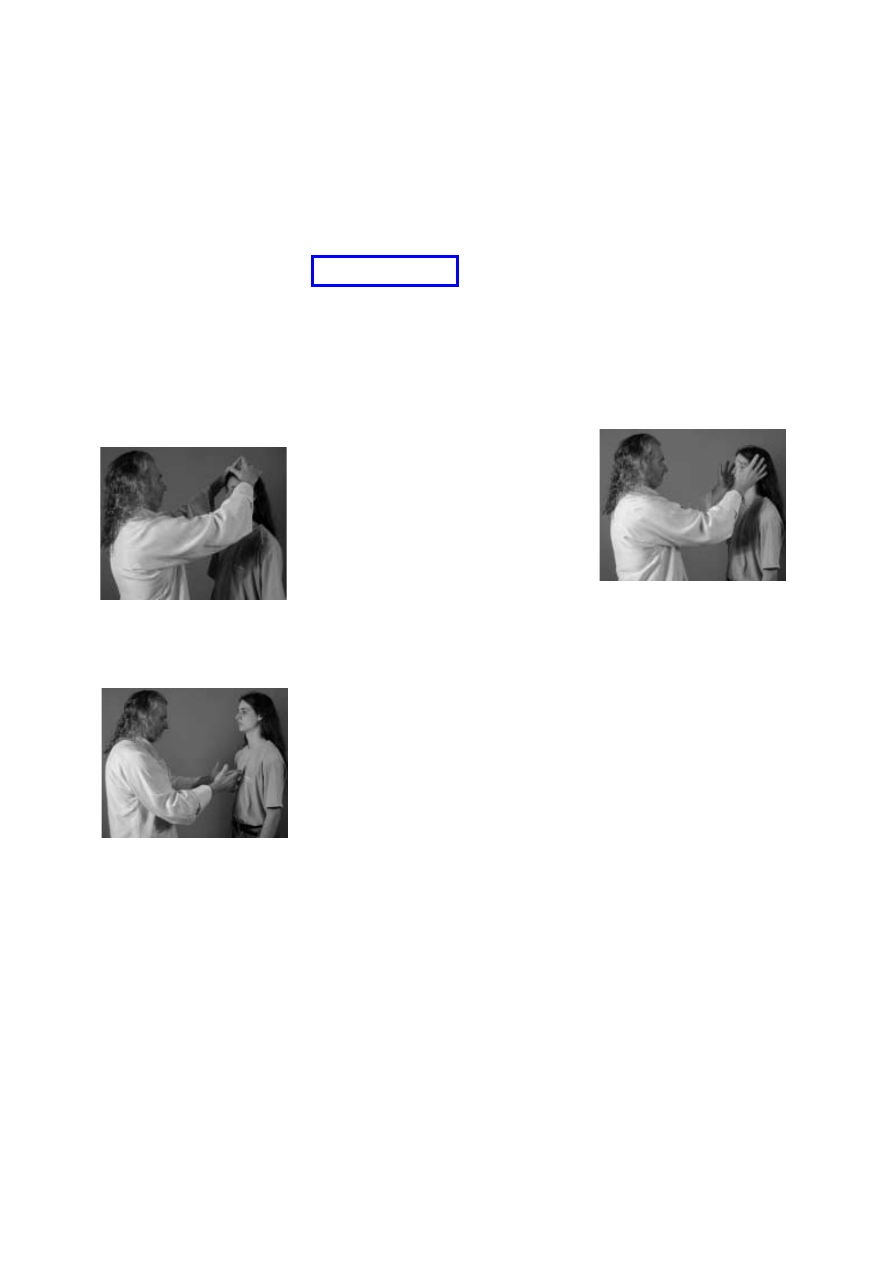
Warning: However, using this ancient memory method, could
be dangerous as you are opening up ancient memories of past
lives or from childhood bad experiences that have long since
been stored away! So use great caution when using this method.
The Danger Signs
As I have warned, you must not do the above method if you are
not trained in such matters! However, I know that to tell a ‘child’
not to do something is to invite he or she to do it! Please do not
perform the above method. The dan-
ger signs are for professionals such as
psychotherapists and doctors.
1/. The eyes could begin to widen and
go glazed. At this point you should
stop the treatment and do the “Qi Bal-
ancing” method as described below.
Place your palms with thumb, forefin-
ger and longest finger touching, over
the crown of the patient’s head.
Photo No. 40
. You must relax
and not think about anything. You in fact, must be accessing
your own Reptile Brain by doing Qigong yourself as you do this.
Hold this position for at least ten seconds. Now, part your fin-
gers and ‘draw’ a tear shape around the patient’s face,
Photo No.
41.
End the tear shape at the point on the patient’s chest called
CV 14 (Conceptor Vessel Point No. 14) near the sternum. As
you do this, allow your last three fingers to join.
Photo No. 42.
Now perform the same routine a ‘positive’ number of times. Pos-
itive numbers in Chinese things are 9 or 36. When you move
your palms back up to the crown (GV 20), you must not move
your palms back over the same line that you moved them down
on! Move your palms right out to the sides keeping well away
from the face. Your palms, when coming down will come as near
to the skin as possible without actually touching the skin. After
about the 3
rd
time, you notice that the eyes are now back to nor-
mal, … hopefully! You must be very careful with people who are
prone to mental activity other than that which is perceived as be-
ing ‘normal’.
Reflex Violence: Page 47
40
41
42

2/. The second danger sign: If you get to here, you must really be
serious about this and be prepared for the consequences! The pa-
tient’s head will rock backwards with eyes closing.
It must be said that it is possible to take people back or to access
ancient memory without the danger signs ever happening and
this normally happens in perfectly well adjusted people. You
want the recession to occur gradually over even a period of days
or weeks, with only the MEMORY of the event being remem-
bered you DO NOT want the patient to BECOME their former
incarnation! Our conscious memory has been blocked for a rea-
son and normally should not be accessed. However, in certain
cases it is beneficial to access ancient memory in order to heal an-
cient scars that are having an effect upon the modern body and
mind.
3/. If you get to this point then you are mad yourself! It is very ir-
responsible for anyone to ever get to even point one let alone this
3
rd
point. The body begins to convulse; it is trying to not only go
back to a previous existence mentally but also physically! And
this can be fatal! However, there have been cases where for in-
stance one patient who was almost blind regressed and could see
perfectly! This was done however under hypnosis.
Reptile Brain Ancient Memory or ‘Cell’ Ancient Memory.
There are two areas of the body where ancient memory is held.
The Reptile Brain holds memory of us in previous lives while the
sperm or ovum holds memory of time. Some even believe that
this memory is held in every cell in the body, others believe that it
is only held in the brain cells because the brain cells are those that
are never renewed. However, because of recent discoveries it is
my belief that it is held in the sex cells. Recent discoveries
showed that contrary to common belief, the sperm cells for in-
stance were updated with knowledge every day! So when we
sleep, the brain (our hard drive) is backed up into these cells so
that every experience is stored forever and then passed on to the
next generation. Hence the Chinese saying that the best possible
parents are those where the father is as old as he can be and the
mother is as young as she can be. The theory is that children re-
ceive their ancient memory and therefore experience of life from
their father while they receive their power and strength from the
mother. A young mother has very strong “Kidney Jing” while an
older mother is not able to pass on much “Kidney Jing.” And a
young father does not have much life experience to pass on.
Chapter One: Reptile Brain: Page 48

Everything that has ever happened is held in these cells and is
passed on when a new being is born. However, it is my knowl-
edge that this memory cannot be accessed, although I have tried
and tried. It is now my view that to access this knowledge would
cause the conscious brain to die as this knowledge is just too
great! We can however have very brief, (milliseconds) experi-
ences of this memory that come in the form of ‘flashes’. Flashes
are a phenomenon that come when one gets into the internal arts
such as Taijiquan and Qigong. They are difficult to explain be-
cause our conscious mind was never meant to view this informa-
tion. It is my belief that often some minute part of this ancient
memory becomes damaged and has to be replaced. It comes
from the Universe, or God. And it must come into the body via
the main ‘Qi Input’ point, the crown. We have seven Qi input
points in the body, which are all activated at some time during
the practice of our Taijiquan form. However, the form MUST
be done absolutely correctly in order for this to happen, no
shortened forms for instance, will cause flashes!
It has been my own experience that when these flashed happen,
our conscious mind gets a minute glimpse of what IS! And what
HAS BEEN. It’s awesome and when it happens to me, I just
stand for some minutes afterwards trying to think on it, but this
is impossible so the feeling slowly goes. But when it happens, it’s
like the Universe opens up. It’s inexplicable, and large! Too large
for our puny brain to comprehend.
Ways to Access the Reptile Brain for Healing and Martial Arts.
When the internal martial arts were invented by generations of
genius, they did not know about scientific stuff like ‘brainstem’
or medulla oblongata etc. However, they did know that per-
forming certain ‘self-Qigongs’ that a person could become a
great healer or a great fighter. They knew that the back of the
neck and up into the skull held great significance so they in-
vented exercises that would allow someone to access what we
now know as the Reptile Brain. Every organ in the body includ-
ing the three parts of the brain need blood and Qi to survive and
the more of this it has and the better quality of these things, the
better it will work. Hence the old Chinese saying of “you must
raise (the Qi up) the back.” We are told that when we do this in
Qigong and Taijiquan we must ‘feel the Qi’ at the points known
as GB 20, (Gallbladder points No. 20) just below the base of the
skull on either side. GB 20 points are those points that are closest
to the Reptile Brain and these points are the major points of re-
Reflex Violence: Page 49

vival from knock out! When we are knocked out, our memory is
blocked out, so when we activate GB 20 by pressing in and up-
ward into the skull, we are actually causing our memory to come
back thus reviving the patient! If the person has been so trauma-
tized that he is dead and cannot be revived using CPR then we
can access the ‘Cell Memory’ for a split second by cutting or
striking into KD 1 point on the base of the foot violently. This
releases life force Jing held in the kidneys. To revive someone by
doing the GB 20 method is like having a hard disk crash and hav-
ing to do a restore from you backup. Using the KD 1 method is
like having to reformat the hard drive and load all of your pro-
grams again!
Drumming:
Drumming is a way of getting in touch with your Reptile Brain
by yourself. These two methods have been around for hundreds
of years and have been used as healing aids in China. This is a rel-
atively simple way of unlocking the power of your Reptile Brain
with none of the dangers of the methods described above.
• Method No. 1:
Place both of your palms over your ears as in
Photo No. 43.
No-
tice that the fingers of each palm touch the Gall-
bladder points that access the Reptile Brain.
Pressing gently with your palm over your ears,
you begin drumming with all of your fingers
over the GB meridian in that area. You will hear
the sound of the ‘drumming’ in your head be-
cause your palms are over your ears. You must
breathe gently but deeply as you do this. You
may sit or stand in a 3 circle Qigong position.
You are also able to move the fingers so that they
are on either side of your backbone to use the
‘straight in’ access points. You ‘drum a positive
number of times, either 9 or 36.
Chapter One: Reptile Brain: Page 50
43

• Method No. 2:
Link your fingers and place
both of your palms again over
the back of your head. Your
thumbs will be touching creat-
ing a spring effect as you push
your thumbs together with
some force. Load your thumbs
up, and then bring them down
like a trigger being released
onto the back of the base of
your skull.
Photo No. 44
. Do
this a positive number of
times, either 9 or 36.
The ‘Keys’ in the Internal Martial Arts.
I have spoken about the ‘Keys’ in several articles. There are nine
keys that a teacher must give to a student in order for he or she to
advance to higher levels. These keys are never talked about nor
does the instructor tell the student when they are being given.
Each key is different and will often involve some physical contact
like a stroke or a grab of the arm or other points. Sometimes it
will involve some words, however, each time, the effect is dra-
matic. A few days later, things begin to happen in that person’s
training and life in general that will be for great benefit. For in-
stance, at one of my annual camps, a student, from overseas, told
me that he and his wife had been trying for years to have a baby
with no luck. They had tried everything. During training, I no-
ticed that this chap was advancing quite well and so decided that
he should have the first ‘key’. The first key involves unlocking the
Reptile Brain a little so that he could have some of the immense
healing power from the brain. It simply involved grabbing the
back of his neck with both hands from both sides and working it
a little. Now, I had to find some reason to do this and did so
when I executed one of the Qi disruptive methods on him to
show that with just a wave of the hand, energy could be drained
from his body. Then, as he was obviously weakened by this expe-
rience, I used a re-balancing method of grabbing the back of the
neck! The outcome was that when he arrived back in his own
country, things began to change, he told me that weird things
were happening to his training, nice things and best of all his
wife was now pregnant!
Other Ways to Reach Your Reptile Brain
All three ‘brains’ are interconnected and to a degree all depend
upon each other in the daily workings of the body that they are in
Reflex Violence: Page 51
44

charge of. So we are able to use this feature to gain access to the
most powerful Reptile Brain or ‘survival brain’ by using our con-
scious brain. We can in fact use our conscious brain to control to
certain degrees certain normally, subconscious or motor func-
tions like heartbeat and blood pressure. I am able to control my
own blood pressure and heart beat so that often when I visit my
doctor, he does not quite know what is going on! You only have
to concentrate upon the palm of your hand to see that you are
able to bring more blood and hence ‘Qi’ into the palm. Why does
this happen, because the conscious part of our brain is linked to
the subconscious and visa-versa.
So we are also able to activate our Reptile Brain by simply plac-
ing our conscious mind onto the area of the Reptile Brain. It
helps greatly of course if you know what the Reptile Brain or
Brainstem looks like and where it lives in your skull. In fact it is
not possible to perform this action if you do not know these
things. In recent experiments, I was able to increase my power
and aggressiveness so greatly using this method that I have
stopped for fear of hurting one of my experimentees!
You must have of course gone through the initial training of
Qigong and/or Taijiquan before you will be able to do this prop-
erly and herein lies the rub. In learning in this way, you also be-
come more aware of whom you are and of the ‘goodness’ inside
of you so all thought to ever hurt anyone consciously is gone.
However, when the time comes to defend yourself and family,
heaven help anyone who attacks someone who is able to go into
the Reptile Brain.
If you are in a situation where it looks likely that you should be
attacked, firstly you must drop your tongue down to your lower
palate. Pull your chin in gently and exhale. As you do this, it will
provide you with a physical expression and feeling of your Rep-
tile Brain area allowing your mind to concentrate upon the area.
Your eyes become cool and calm as does your whole body, how-
ever, looks are deceptive as your body is ‘in neutral’ with the mo-
tor running ready to by put into gear at the slightest move to
attack. You will feel your arms go really relaxed or as the Chinese
call it ‘sung’ where even the slightest body movement will cause a
great movement of the arms with tremendous power. You can-
not talk well while in Reptile Brain mode you cannot focus, you
can use only peripheral vision or as we call it, “eagle vision.” You
no longer have to think about techniques; you will only react to
what is being done to you with the correct method of defense/of-
fence.
The above method of course can never be used in a tournament
situation because your life is not threatened and therefore does
Chapter One: Reptile Brain: Page 52
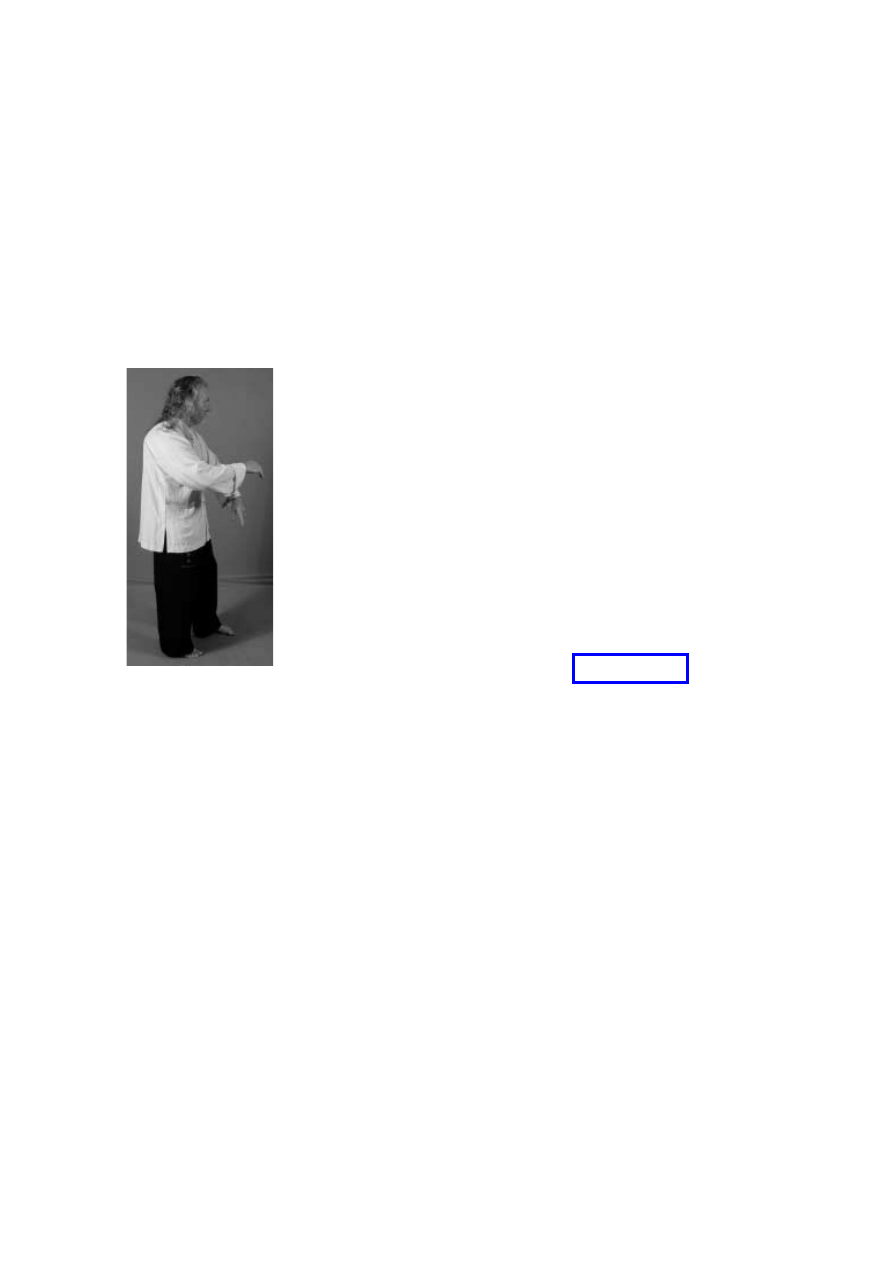
not call for ‘survival mode’. Reptile Brain can only ever be used
for survival that’s what it’s for. A snake will never attack for the
sake of attacking, it always has a reason, either that a human
came too close and therefore threatened it, or that someone was
trying to pick it up to show off! Or someone stepped on it acci-
dentally. But no reptile will ever attack you if it does not mean
survival either for food or for defense.
Carrying on with the above method: You now advance this
method by doing much the same thing as the healing method of
physically linking your Reptile Brain with an affected part of
your body only now you do it with your mind. As you concen-
trate upon the shape and area of your brainstem, you will try to
imagine an internal link to an attacking portion of your body
such as your palms or fingers. You should feel your fingers or
palms begin to tingle as the Qi rushes to the area ready for ac-
tion. Now, having done the correct internal martial arts training,
all that is left is for the attacker to attack you. Immediately your
palms or fingers will attack relentlessly until the danger is over
and you have survived. There must be absolutely no tension in
your body and especially in your mind intent attacking portions.
And isn’t that exactly what for instance, Taijiquan has to say. Ev-
erything that I have been talking about above is exactly what we
are meant to do while practicing Taijiquan! Sadly, not many
know of this.
The Ears and Backbone
What do all animals do when threatened? Every animal will
round its backbone. Sharks do this, even chickens do this with
the cat being the epitome of the ‘C’ back when ready to attack.
Rounding the backbone slightly, allows our Reptile Brain to
take over from our conscious mind and puts us into survival
mode. See
Photo No. 45,
for the ‘C’ back posture. As your
backbone is curved, there is a feeling just under your skull in the
area of your brainstem or Reptile Brain, you eyes become a little
glazed and you are ready. However, there is another method that
is always used in conjunction with the ‘C’ back and that is that
the ears of all animals when threatened, are flattened out and are
lowered. The horse is the typical example of this. Humans of
course have lost the method of moving the ears, however, the in-
ternal muscles still work in joining the Reptile Brain to the rest of
the body in just the same way that it does when an animal flattens
its ears. When an animal’s ears are lowered and flattened, this is
an automatic reaction to being threatened and it is a physical way
of accessing the Reptile Brain. To move your ears internally so
that the Reptile Brain is accessed takes some practice. Some peo-
ple I know, can do this naturally, however, for most, it takes
practice. Pull your chin in slightly and stretch your mouth
Reflex Violence: Page 53
45

slightly as if smiling without opening your mouth. Your ears will
move ever so slightly backward and you will feel that Reptile
Brain feeling at the base of your skull. But isn’t that what we are
told to do in Taijiquan practice. We are told to pull the chin in
slightly and to have a slight smile on our face when practicing.
This was always to access the animal within and not some kind of
nice meditation!
The sign that you are accessing the Reptile Brain, is that, the feel-
ing at the back of your skull will rise up and over the top of your
head and end up at the ‘third eye’ point in between your eye-
brows. This is when your eyes will glaze a little and it will seem as
if everything is in slow motion. At first you will only be accessing
a small portion of your survival brain but with practice you will
be able to go into the Reptile Brain automatically when the situa-
tion arises.
It is the Paleomammalian brain that will kick in when you are
healing. The Reptile Brain is for survival while it is the Old
Mammalian or Limbic system that is used for higher levels of
healing. Our protective instincts come from this area of the
brain. But this too is for the most part a subconscious action and
I have always said that healing should not be a clinical physical
thing but rather a subconscious healing. So if you are an acu-
puncturist for instance, do not wear rubber gloves as I see so
many wearing nowadays as this will block your own Qi (electric-
ity) preventing you from performing a ‘higher healing’. The
higher masseur for instance does not think about where he or she
is placing the hands or what organs they are healing, they allow
their subconscious Paleomammalian brain to take over to guide
their hands to the correct areas that need to be healed!
The Neomammalian brain of course is used in healing, but this is
for when things like bone fractures are present and need physical
intervention, some diseases at advanced stages also fall into this
category when it has just gone too far for natural methods. Doc-
tors use this brain for their type of healing. My saying is “Dire
Means for Dire Straits.” So if you have taken 10 years to get into
the poor state of health and your organs need to be ‘fixed’ right
now using surgery for instance, then you must do it. It has taken
many years in some instances for someone to get to where they
are and natural methods will reverse the situation usually at half
the pace of how you got there and in many cases people just
haven’t the time!
Chapter One: Reptile Brain: Page 54

The Reflex Violence Methods
Chapter Two
NOTE:
I will be using point names like ‘LU 5’ (Lung Point No. 5). I
suggest that you get my ‘Point Location’ book, free to download from
our web site, as you will not have any idea of what I am talking about
if you do not already know about Dim-Mak points.
T
he danger is writing this book is that people will see the pho-
tos, never having experienced or even having seen fa-jing
being performed. They will see the photos as representative
of ‘techniques’ step by step. However, this could not be further
from the truth as fa-jing (explosive energy) has to be seen to be
believed and to be experienced.
It is easy to take some photos of each of the Reflex Violence
methods showing step-by-step photos. However it is difficult to
show how these methods work or are performed in fa-jing, in
fact it is impossible! So I urge those who find this book interest-
ing to get the “Sudden (Reflex) Violence video series so that you
can see and learn how to do them correctly and not like some ka-
rate kata! Or worse still, like some pretty, dancing style of
Taijiquan form! Taiji (Tai Chi) is violent, and it has to be. How-
ever, it is not violent in the mind, it is violent subconsciously us-
ing the reptile brain so that the ‘human’ brain remains calm at all
times. The subconscious brain causes the body only, to react vio-
lently leaving the brain calm and in charge. We go into a sort of
‘motor’ mode where the body seems to work by itself. This is
why a martial (fighting/killing) art can be called calm or a type of
meditation while at the same time being very violent as one has
to be when one is protecting his or her life or that of the family
etc. So if anyone tells you that they can use the lovely slow move-
ments of Tai Chi for self defense not changing them from what is
represented in the slow form, walk away as that person knows
nothing and has obviously never been on the cobbles in a real
scrap! All of this comes from people only ever learning slow
form which is only one 100
th
of what there is to learn in
Taijiquan. We use the slow form to move without thinking as
that is the easiest way to learn this part of fighting. Then later, we
learn the violent movements while still remaining calm internally
and this is one reason why Taijiquan is also so good for health. I
heard from one student in the USA whose teacher of Tai Chi
would only teach in the dark in candle light with nice music play-
Reflex Violence: Page 55

ing. The student asked him why he did this as it was difficult to
actually see him doing the movements in order to learn them.
His answer was that this was awareness training! Apart from
someone who is blind, (and I have taught many blind people
who are able to grasp the concepts often better than sighted peo-
ple), we DO have eyes! And our eyes are part of our awareness.
You will not see an eagle hunting at night, why? Because he can-
not see at night and he would bump into trees! Same with us, we
train using every sense that we have including our eyes in the ‘Ea-
gle Vision’ mode.
The above reminds me of a nice joke. A vampire bat comes back
from a night of hunting, his face covered in blood and hangs up
on the roof of his cave. Gradually, the thousands of other bats in
the cave come to him and ask. “Wow, where did you get that
blood?” The bat tells them to bugger off but they insist that he
tell them. So he finally agrees and flies out of the cave with thou-
sands of bats following eagerly in anticipation. They fly over a
valley and a couple of mountains until the first bat says to the
others. “Ok, do you see that valley of trees.” “Yes” they all ex-
claim excitedly. “And do you see that huge oak tree over there?”
“Yes! Yes” they reply. “Well I didn’t!”
Although I will be showing each method in static photos, you
must remember that each method takes between one and two
seconds to perform. However, looking at the photos, it would
cause one to believe that they would take much longer as I have
no way of representing what fa-jing looks like in photos. Each
movement bounces off the last in a violent continuous attacking
method, never giving the attacker time to move, let alone think!
We make use of energy and recycle it into the next movement as
this is the Taijiquan or ‘internal’ way of fighting. So when I show
you for instance three or four attacking movements, you have to
work up to speed (explosiveness) so that you get to where you
simply count ‘one’ and you are done.
The Reflex Violence methods are taught in groups. So you will
see that some will contain mainly centrifugal movements while
others will contain vertical movements and others will contain
straight-line movements. The centrifugal ones are usually taught
first as they are usually the easiest to grasp as generally, each
movement is easy to see.
WARNING:
The following methods are deadly! Each individ-
ual strike will cause anything from extreme nausea to death.
Even light contact can cause death or injury. Practice on a kick
bag to get the idea of the extreme power that can be generated.
These moves are only meant for dire situations where life is
threatened!
Chapter Two: Reflex Violence Methods: Page 56
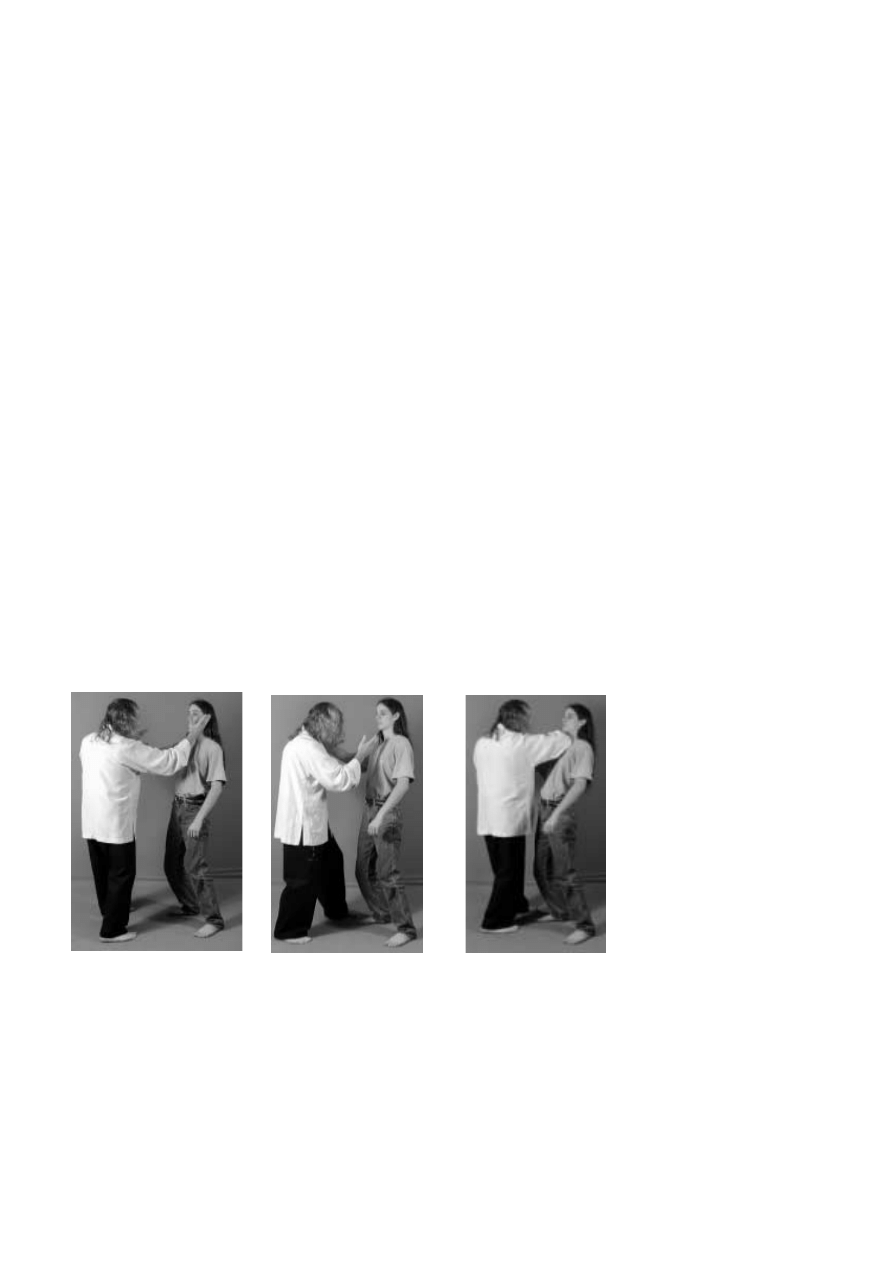
Method No. One.
NOTE:
Each of these methods is designed to build upon your
‘violent’ Qi building from the first movement so that once you
get to the last one in each set, you have a huge amount of Yang
energy bursting out. So it is important in training only, to con-
trol this immense power building up because you could hurt
your training partner.
We begin with the most common type of street attack, the old
‘haymaker’ or curved, roundhouse type of attack.
The attacker attacks with a right hook punch. Using the centrifu-
gal power from my waist, I turn my waist to my left which also
takes my left palm with it causing great damage to the inner fore-
arm area to the ‘Neigwan’ point which drains a huge amount of
Qi from his body. At the same time, utilizing the power from
that same turning, my right knife-edge palm attacks with great
power across and down the whole of his neck. This in itself is a
death strike.
Photo No. 46.
Many neck dim-mak points are
struck here including ST 9, ST 10 and SI 16, all death points. It
doesn’t really matter where you strike to as long as it is the neck.
Because of the centrifugal nature of this movement, your right
hand in particular will not stop at the neck, but will continue its
trajectory down to your left side slightly ready for the next move.
You must have moved forward
(golden rule)
into his attack and
never have moved
back! Load your
waist back to your
right (in an instant
of course) which
loads your right el-
bow,
Photo No.
47
and release the
elbow into his
throat at CV 22
(pit of the neck).
Photo No. 48.
If
you do not load
back to the right
before
releasing
the elbow then
you have not used the rebound from the previous movement and
you will have to load separately which will cause the movements
to be static!
NOTE:
You have less control over your elbow, so
please pull it short of your partner’s neck. Once the rebound en-
ergy kicks in, it is difficult to stop this strike from making con-
tact!
Reflex Violence: Page 57
46
47
48
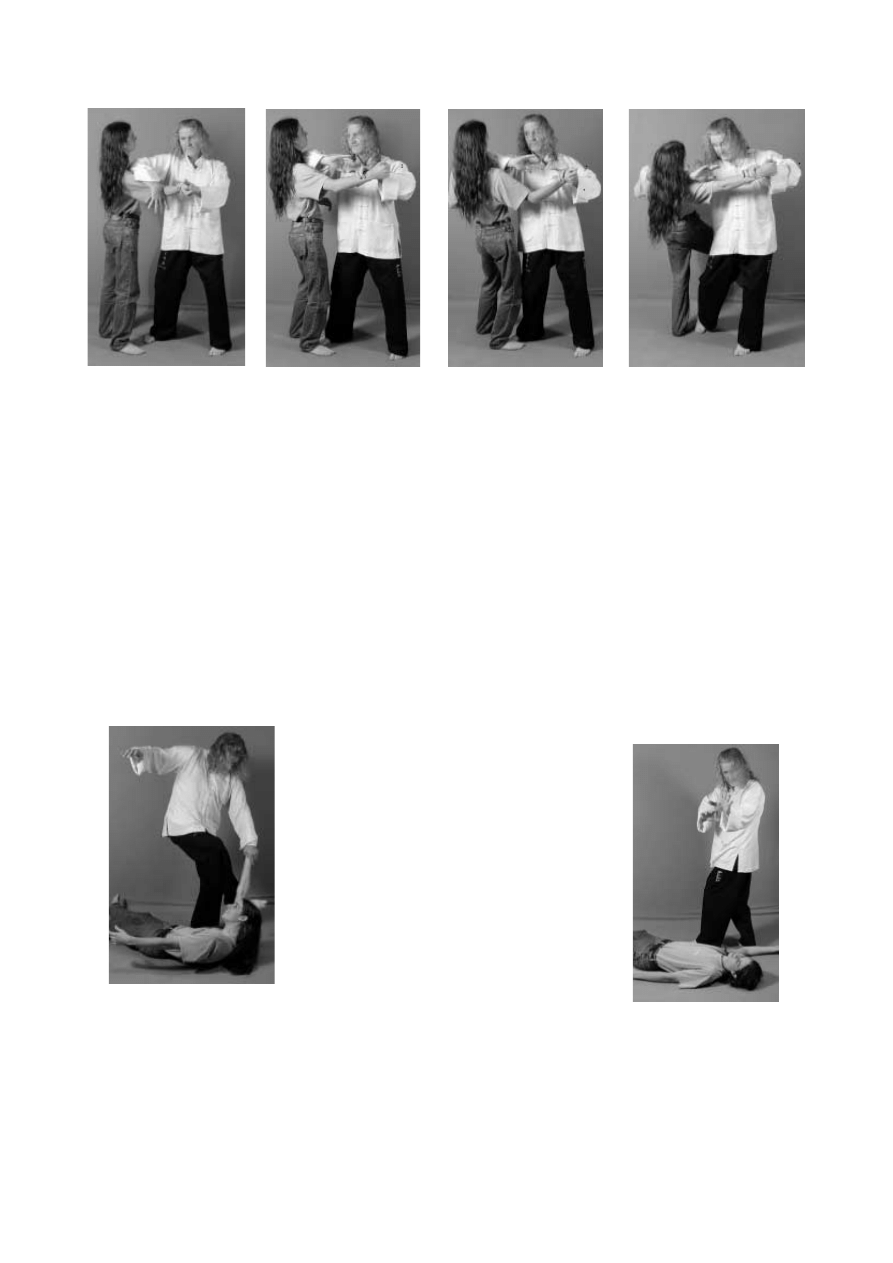
Now, place your right palm over his right elbow joint just above
it in fact as your left palm opens to control his wrist area, pushing
with your left palm as your right palm pulls violently thus break-
ing his right elbow.
Photo No. 49.
Using the rebound from the last break, you load your right el-
bow back to the right again using your waist and again strike him
in the CV 22 point with your right elbow.
Photo No. 50.
A bit
of overkill? Yes, it is meant to be as these are life and death situa-
tions!
Allow your right elbow to again load right and again attack the
neck with your right elbow.
Photo No. 51.
Notice that the left
palm is attacking his Neigwan points every time you attack to the
neck. This keeps the Qi drained.
Take your right leg around behind his
right leg and as you again attack his neck
with your right elbow, your right leg
will kick/sweep his right leg out. You
have attacked to a very dangerous point
called Kidney (KD 10) ten point behind
his knee which basically causes renal fail-
ure!
Photo No. 52
.
As you take him down, turn your body
and holding his right wrist, turn it so
that the back of his elbow is presented
and kick using your shin into his elbow
joint breaking it.
Photo No. 53.
You
then take his arm and beat him over the head with it! (Nah). Fin-
ish up in the position shown.
Photo No. 54.
Chapter Two: Reflex Violence Methods: Page 58
49
50
51
52
53
54
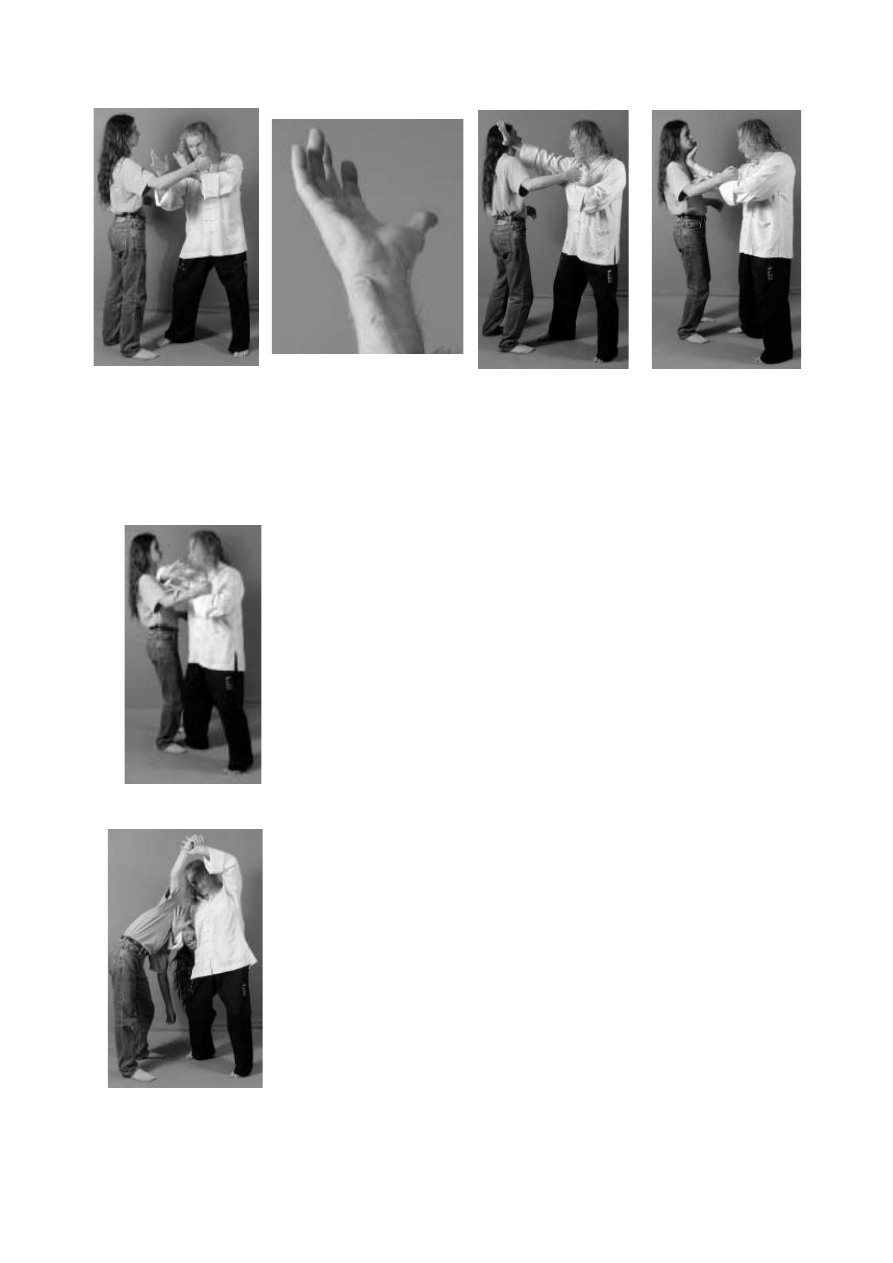
Method Number Two.
This one is like the previous one. But now, you haven’t done the
right thing in moving in so you will have to strike his right inner
arm with both hands in order to do the most damage in that situ-
ation first of all.
So he attacks with the right hook again. This time both of your
knife edge palms will strike the inner forearm. Your left at his
right ‘Neigwan’ point while your right will strike into his LU 5
point (Lung point No. 5). This point is the classic Qi drainage
point and will knock someone out when struck correctly. It is lo-
cated in the inner elbow on the thumb side just over that large
tendon.
Photo No. 55.
Using the natural rebound from that last
strike, your right palm will now bounce off to strike him just be-
hind the ear at the point called, TH 17 (Triple Heater Point No.
17). This can be used as a ‘come with me’ point, and is used by
bouncers to great effect, or it can be struck harder for a death
strike. The weapon we use here is a small bone on the little finger
side of the wrist which fits nicely into this point. We also use this
weapon for other targets such as Neigwan. See
Photo No. 56,
For this weapon and
Photo No. 57,
for the strike. Your right
palm will naturally rebound from the previous strike as your
waist turns to your right, load and strike into CV 22 point.
Photo No. 58.
We use the heel-palm for this strike. The re-
bound from that strike is used to strike him again into CV 22 us-
ing your right elbow.
Photo No. 59.
Your right palm will now
snake around his neck as your waist turns to the right and your
left palm will control his right arm upward. Notice the position
of his head. It is sideways thus making for a classic neck breaker.
Photo No. 60.
Careful with this one
as you can break necks re-
ally easily or in the least put his neck out.
Reflex Violence: Page 59
55
56
57
58
60
59

A close up on my right palm shows the optimum position so that
he cannot escape. My palm is flexed and hooked under his chin.
Photo No. 61.
Notice also that I am using my stomach to jam
his head up against for leverage. You do not stop there. You sim-
ply violently shake his head off!
NOTE:
Do not move onto your opponent in order to grab his
head. Pull him into you. If it is a larger person and you jump up
to wrap your arm around his head, he could still have the
strength to just stand there, so violently, using all of your weight
drag him into you as you snake your arm around his neck. You
will also strike into the back of the neck as you pull him into you.
You will have struck the ‘Reptile Brain’ or the ‘brainstem’ as you
do this. The reptile brain is the part of the body that indicates
life! When the brainstem stops emitting signals, a person in clini-
cally dead. So when we strike it, the person is in shock mode for a
few seconds as this is the most important part of the brain as far
as life is concerned. Hence why the old ‘rabbit chop’ works so
well. And remember that there should at no time be any anger
involved in fighting for life! When you get angry, you lose all
reptile brain mode because reptiles do not get angry, they simply
survive. Dogs do not get angry as such, but they do what has to
be done in order to survive. Anger causes the Qi to raise making
you ‘top heavy’ and unbalanced. It also affects your liver ad-
versely.
Method Number Three.
He attacks with a straight right. This time we use a Taiji method
called P’eng. Your right forearm meets his attack but does not
push it, it bumps it by the use of your right wrist changing form a
Yang shaped palm to a yin-shaped palm. In other words, we
strike the arm rather than simply blocking it. Almost immedi-
ately, your left palm will strike him at GB 12 point (just behind
the ear). Your left palm has changed from a Yin palm (which
stores Yang Qi) into a Yang palm, thus releasing that stored
Yang Qi.
Photo No. 62.
NOTE:
When training this method
(and all of them), your partner must attack using force, other-
wise you will have no reason to bring up the Yang Qi. His on-
coming force causes you to use the correct amount of force to
counter his attack. His energy will go into you and be rerouted
back into him via your own movements. So if someone attacks
you with no force, you do not have anything to give back and
must then revert to muscular type of attack as in karate.
You move in and folding your left arm, strike with great force us-
ing the power of the waist with your left elbow into GB 20 point
which is further around behind the ear just under where the skull
begins and to either side of the backbone. GB 20 points are ma-
Chapter Two: Reflex Violence Methods: Page 60
61
62
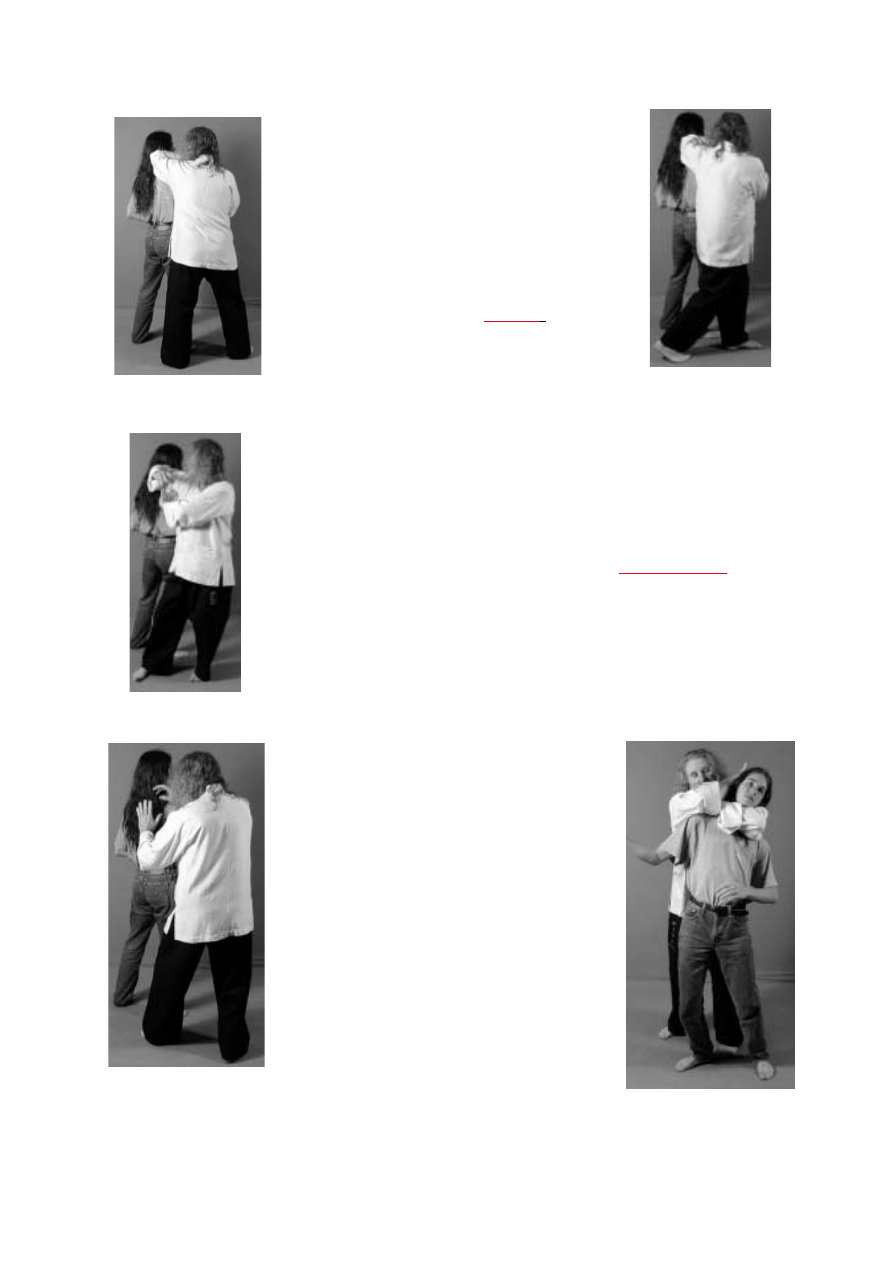
jor striking and healing points. They can
also be used to revive someone who is
knocked out by pressing up and into the
skull thus reviving the Reptile Brain.
Notice also that your right palm is now
controlling and breaking his right elbow
by wrapping around it and utilizing that
fa-jing shake which caused the elbow to
strike. Never give a sucker an even
break!
Photo No. 63.
RULE
: When-
ever you move, hit something! If your
body can move anywhere, then you can
also hit him by using that movement be-
cause in the internal arts we use the
movement of the whole body and not
just the attacking portion.
Next, take your right foot around behind your left one. This hap-
pens in an instant and the following strike also happens in an in-
stant.
Photo No. 64.
Now spin around using the power of the
waist on your left heel and the right ball to strike again into the
back of the neck with your right elbow.
WARNING:
This is
VERY dangerous so be really careful in training!
Photo No.
65.
Notice the left palm is still controlling his right arm. Your
left palm is also striking into his right scapular at SI 11 point
which is a Qi drainage point.
Swing your right foot to the rear,
Photo No. 66,
and adjust
your left foot so that your left arm can violently grab him around
the neck as your right arm also comes
into play to get a choke hold (sleeper)
which blocks the blood supply to the
brain causing him to ‘sleep’! This, when
done correctly can only take around one
to two seconds to work. Your left biceps
are squeezing his left carotid artery
while your left forearm is squashing his
right carotid. In other words, you have
his neck in a ‘V’ shape caused when your
left arm bends around his neck. Your
right forearm is like it is folded under
the left adding squeezing pressure to
both sides of his neck.
Photo No. 67.
In order for this to work, this one in par-
ticular must be done very violently!
Notice that my right palm is on the back
of his head turning his head slightly
sideways to add to the effect.
Reflex Violence: Page 61
63
65
66
64
67
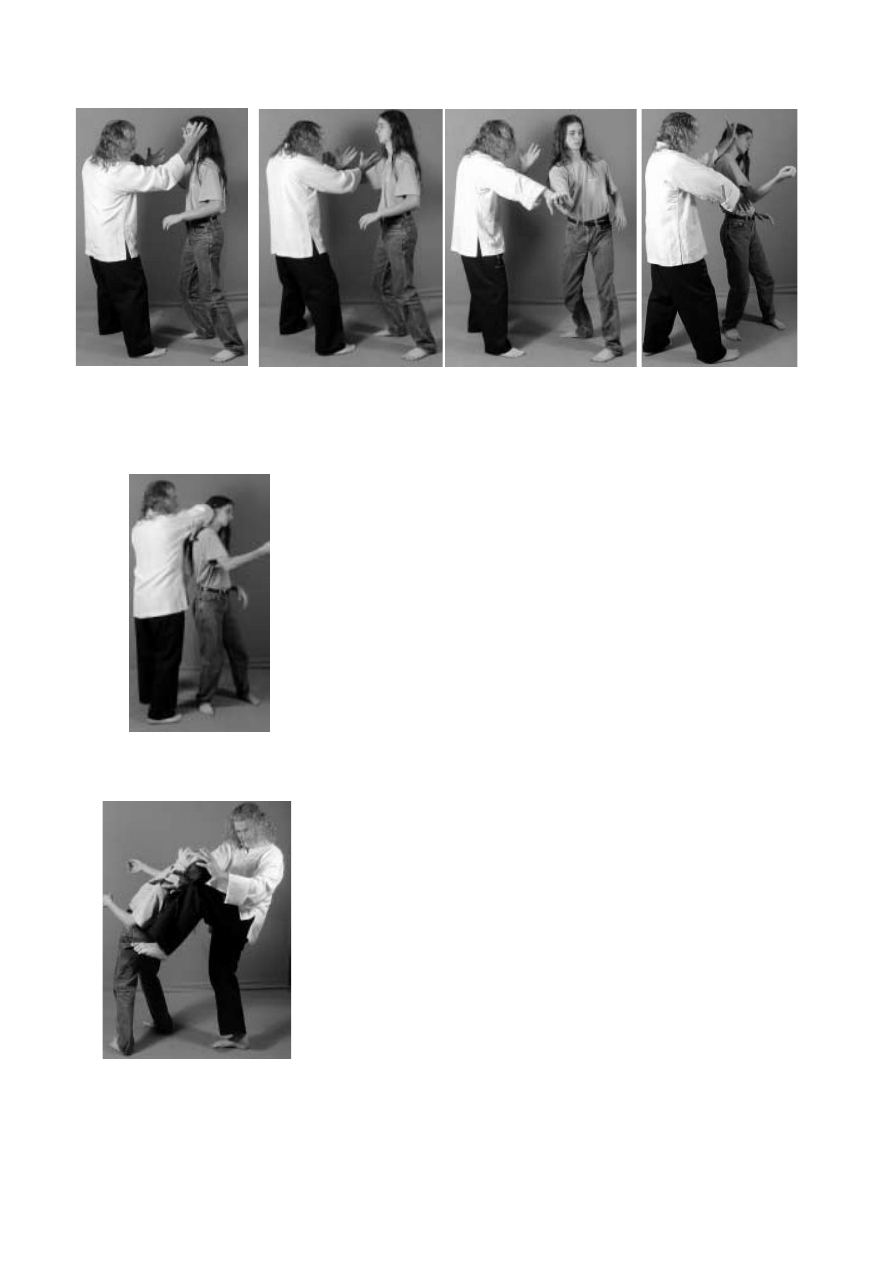
Method Number Four:
Moving in on his right hook punch (haymaker), use your left
P’eng arm to attack to his ‘Neigwan’ points or to his LU 5
points on the inside of his right forearm. Your right heel palm
will attack to his ST 5 point on the left side of his jaw. This is one
of the better knock out points as it leads directly to the Carotid
Sinus which in turn stops or slows the heart beat dramatically. It
also has the effect of shocking the brain so that it shuts every-
thing down until it works out what is happening. This is the
classic jaw strike as used in most Westerns and other movies.
Photo No. 68.
NOTE:
Use the power of your waist in turning
violently to your left which causes great power in your P’eng
arm. In these cases, the harder he strikes, the harder he is struck.
Your right palm continues its downward movement to strike
into his LU 5 point.
Photo No. 69.
You move your body ac-
cordingly as your right palm hooks over his right forearm/el-
bow and violently forces his arm over to your right causing his
back to be exposed.
Photo No. 70.
Where you will now strike
him using your left palm into his GB 12 point. NOTE: This
whole section of movement has been smooth and continuous
with each move moving into the next.
Photo No. 71.
Now,
your right elbow will strike into his GB 12 point again using the
power of your waist. Notice that your left palm has again con-
trolled his left shoulder.
Photo No. 72.
NOTE:
If the attacker
is very tall, you can go under his left arm with the elbow as there
are just as many death points in that location such as SP 21, GB
22 etc. Your left palm snakes around his neck as your right palm
grabs over his head to drag him backward violently onto your
right knee which is moving upward. You can either strike into
his back or into the back of his neck with the knee.
Photo No.
73.
Chapter Two: Reflex Violence Methods: Page 62
68
69
70
71
72
73
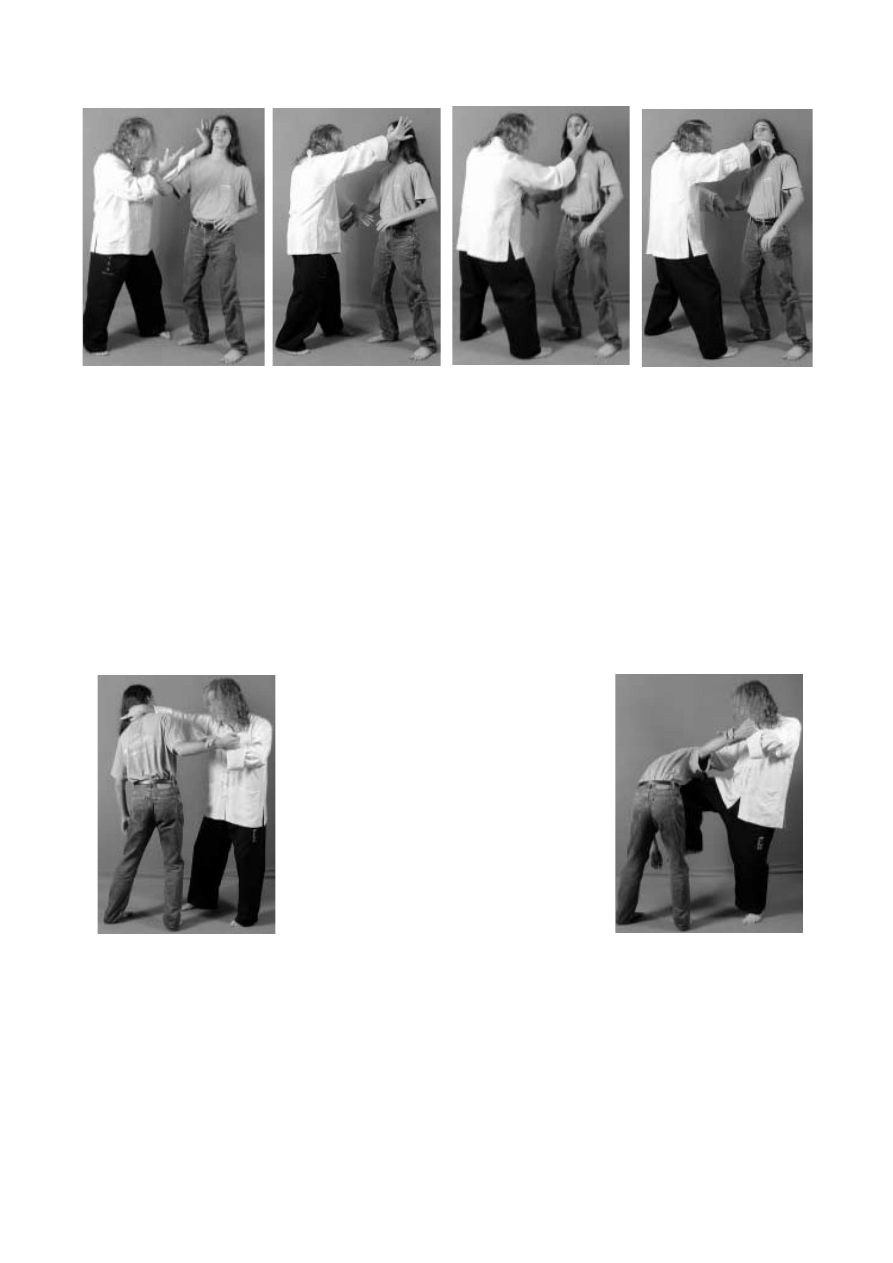
Method Number Five
This one begins the same as the last by taking his straight right
attack this time with your right P’eng and attacking him into his
GB 12 points on the back of his head.
Photo No. 74.
Now, your
left palm comes down to his right elbow and hooking over it, vi-
olently pulls it over to your left as your right back-palm attacks to
his temple. This is a beautifully flowing movement with the first
running into the next. This is the ‘Stork Spreads Wings’ strike
from Taijiquan and is one of the most powerful strikes known as
it utilizes the whole power of the waist.
Photo No. 75.
Using
that same waist shake as it automatically
moves back to your right from the last
movement, your right palm will circle
over and strike downward along the
whole of the left side of his neck taking
out very important points such as ST 9,
ST 10, ST 11. ST 11 point takes the
‘will to fight’ away.
Photo No. 76.
Next, you make the ‘Single Whip’ hook
with your right palm and strike down-
ward taking out the whole left side of
his neck and points in that area.
Photo
No. 77.
Slide your right palm around
his neck as your left palm controls his
right forearm.
Photo No. 78.
Now,
pulling violently on his neck forward and forcing his right arm
upward thus opening his rib area, pull him onto your right knee
thus attacking his whole rib area and points in that area.
Photo
No. 79.
Reflex Violence: Page 63
74
75
76
77
78
79
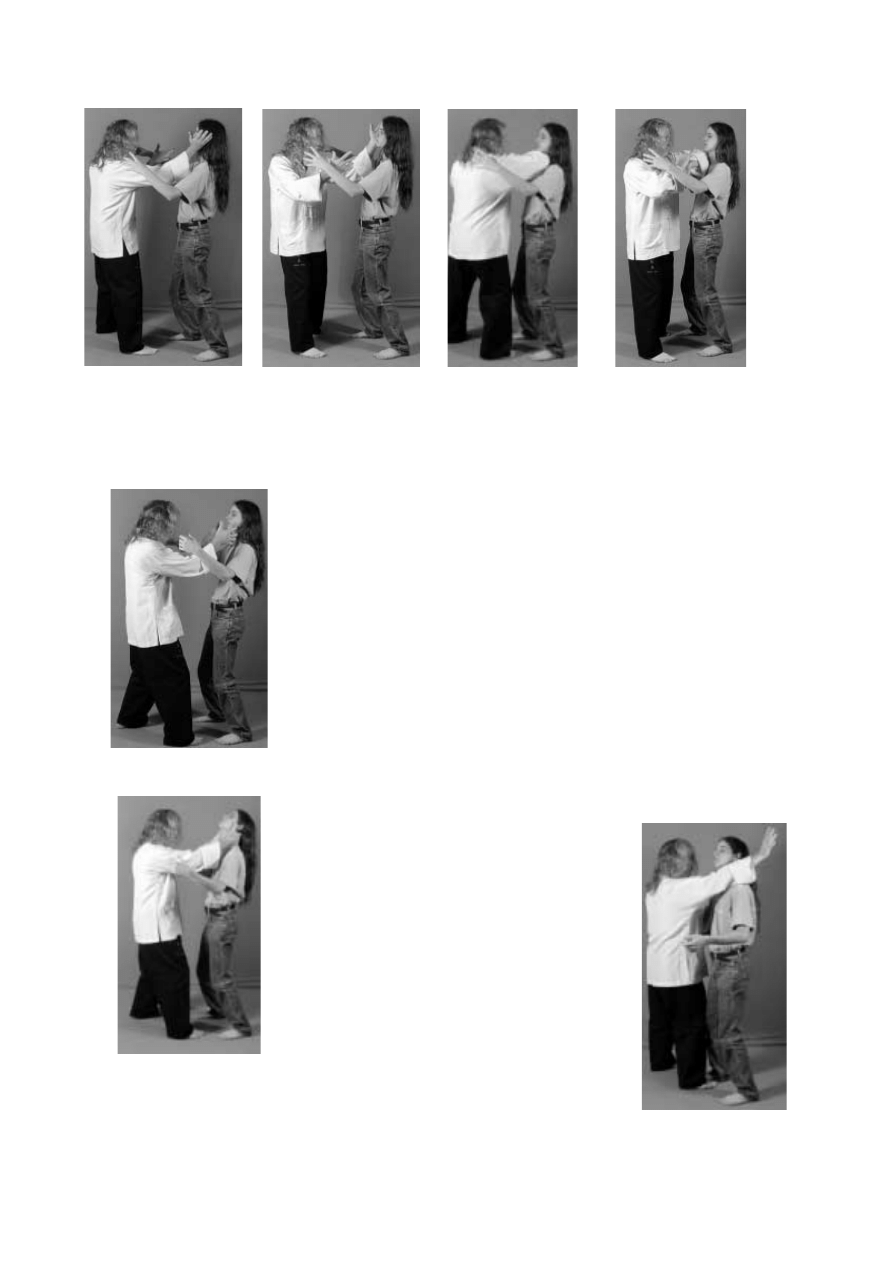
Method Number Six
You are attacked by someone using both hands as perhaps a
grappler would. Your left palm releases Yin Qi into his right in-
ner forearm at ‘Neigwan” while your right palm attacks to the
side of his jaw at ST 5 point.
Photo No. 80.
Instantly, you re-
verse that by slamming your right outer wrist into his left
‘Neigwan’ point thus draining much Qi from his body, as your
left palm now attacks into his right sided ST 5 point, an excellent
knock out point.
Photo No. 81.
Now, using that same rebound from the previous movement,
and using the power of your waist, slam your right elbow into
the left side of his neck taking out points such as ST 9 and ST 10,
a death strike!
Photo No. 82.
Now, using that same waist
power, turn your waist violently back to your right and slam the
other side of his neck with your left elbow.
Photo No. 83.
NOTE:
The above movements have taken all but a split second
to execute thus giving him no time to re-
taliate.
As your opponent moves backward,
load both of your palms facing upward
and violently dig the fingers of both
palms into either side of his neck, again
taking out many vital dim-mak points.
This movement in Bagua is called “Mon-
key Offers Fruit.”
Photo No. 84.
As he
moves back even further, reach around
behind his neck with both palms and vi-
olently jerk his neck forward thus throw-
ing his head backward which will at the
least kink his brainstem causing knock
out or kill him.
Photo No. 85.
As his
Chapter Two: Reflex Violence Methods: Page 64
80
81
82
83
84
85
86
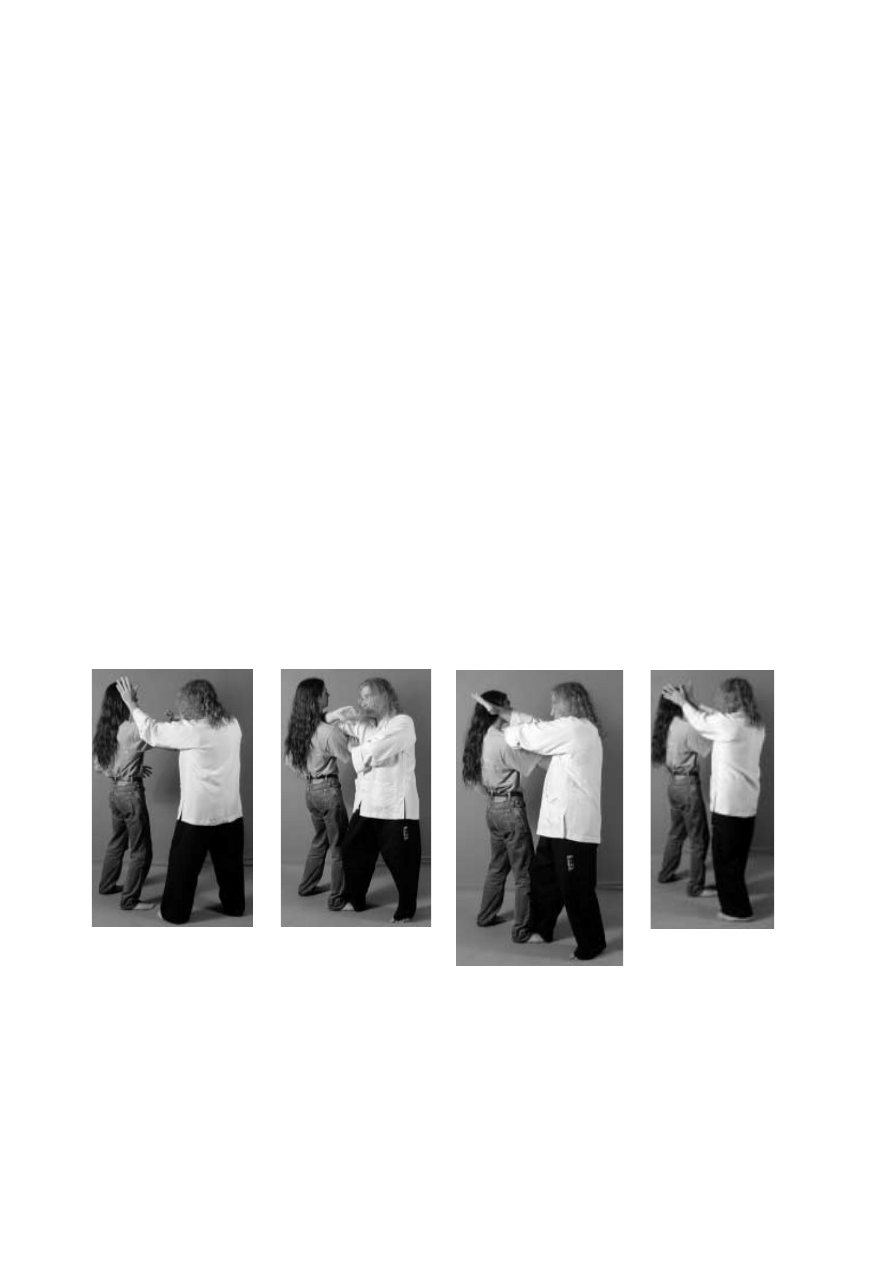
neck moves forward, you have already loaded your right elbow,
coat hanger him across the right side of his neck.
Photo No. 86.
Method Number Seven
A right handed straight attack. You take it with your left palm
positioning your body so that you hardly feel his attack nor he
yours. You left palm slips up his arm attacking him in the temple
as your right palm guards his right forearm.
NOTE:
You do not
push his arm away but rather position your body to your left so
that he feels like as if you have not done much to him until he is
struck in the temple.
Photo No. 87.
Now immediately and with
great violence (fa-jing), your right elbow using the power of
your waist strikes into his neck. Notice that my right knee is on
the outside of his right knee thus controlling it or I can use a knee
breaker.
Photo No. 88.
Notice also that my left palm has
slapped down onto his biceps muscle thus upsetting his energy
and also controlling his right arm. From this position you will
open both palms violently thus attacking him at point GB 20
(Gallbladder Point No. 20) with the right palm and with the left
palm straight across his neck at ST 9.
Photo No. 89.
Using the
rebound from the last movement, the both palms will load and
strike him into the temple (GB 3).
Photo No. 90.
Reflex Violence: Page 65
87
88
89
90
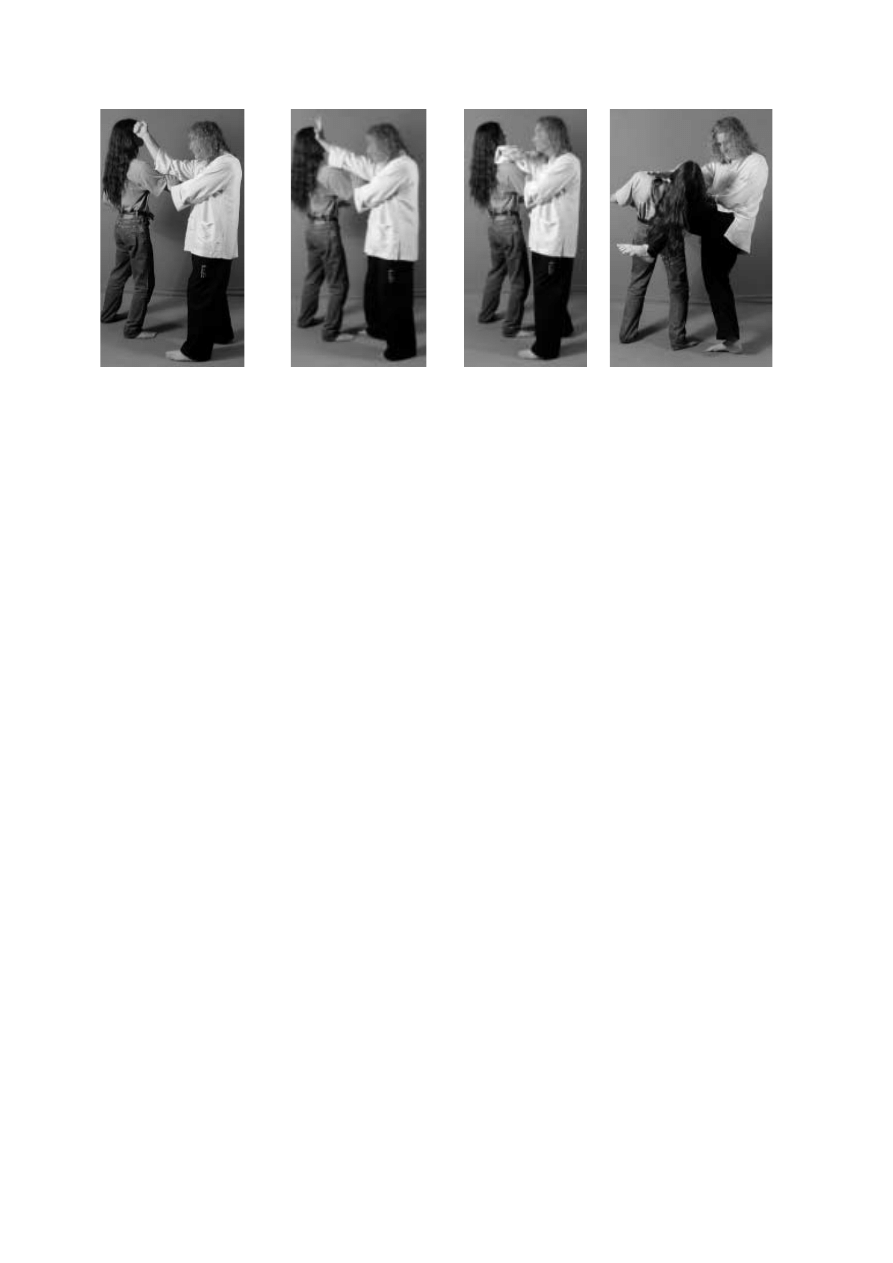
Method Number Eight
This is the last Reflex Violence method that I will be including in this
book which covers pretty well the first two of my video titles of the same
name. However, we have another 6 volumes in the video format. In
any case, it is important to view the videos if you wish to learn this sys-
tem properly as it is impossible to show the absolute violence and fa-jing
in a book. In fact, I had to not put No. 8 into the book as I found it im-
possible to even show the moves in photo form, so I will go straight onto
method No. 9 from the tape series although I will name it No. 8 in this
book. This book is intended to give you an idea of what the whole system
is all about in order to show the violent nature of the so-called ‘Soft In-
ternal’ Systems! I have not covered for instance the pre-emptive at-
tacking methods where we initiate the attack.
The attacker attacks with a straight right. Move naturally to your
left and slip block his right forearm with your left palm as your
right one knuckle punch attacks to his GB 3 point. (Temple).
Photo No. 91.
Using the rebound form that strike, your right
palm loads Yin and then re attacks Yang into the GB 3 point.
Photo No. 92
. This movement will load your right elbow to at-
tack also to the side of his head or into his neck.
Photo No. 93.
The speed of these movements has to be seen to be believed! It
takes only a split second to execute all three. Notice that my left
palm is still touching his right arm, in fact it has struck it as I have
struck with the elbow thus further setting up the point strike.
Move your right forearm around his neck and lifting your left
knee pull the back of his head just under where the skull meets
the neck, violently onto your knee.
Photo No. 94.
Chapter Two: Reflex Violence Methods: Page 66
91
92
93
94

Conclusion
I hope that this book will help in your understanding of the in-
ternal martial arts and that you are able to glean something from
this information to perhaps enhance your own martial art.
The whole video series called “Sudden (Reflex) Violence” is as follows:
Volume One:
MTG 184
Volume Two:
MTG 185
Volume Three:
MTG 187
Volume Four:
MTG 188
Volume Five:
MTG 191
Volume Six:
MTG 193
Volume Seven:
MTG 195
Other titles of the same nature include:
Entering Methods:
MTG 108
Fighting Methods of Internal Gung-fu:
MTG 166 Vol.1
Fighting Methods of Internal Gung-fu:
MTG 173 Vol 2
Fighting Methods of Internal Gung-fu:
MTG 179 Vol 3
Self Defense Volume One:
MTG 126
Self Defense Volume Two:
MTG 132
Self Defense Volume Three:
MTG 137
And again, please feel free to distribute this book to your friends,
but please do not plagiarize the information for other publica-
tions etc., as it is illegal to do so. And please give credit where
credit is due if you should begin to teach what is in this book as
the Montaigue schools are the only schools who have published
this information so it can only have come either directly or indi-
rectly from Erle Montaigue.
Reflex Violence: Page 67

About the System
The Erle Montaigue System is that which Erle Montaigue has
eclectically gathered from the Internal Fighting/Healing systems
of Taijiquan, Baguazhang, Dim-Mak, Wudang Shan Qi Disrup-
tive System and Qigong.
The names, ‘Fa-jing Ch’uan’, H’ao Ch’uan and the Erle
Montaigue System are registered names belonging to Erle
Montaigue.
And information in this book falls under International Copy-
right ©laws. Permission must be gained from the publisher,
“Moontagu Books” before any portion from this book may be
used in any other publication.
However, as this is a free book, please feel free to download it
and share it with friends free of charge unless you are one of our
registered distributors who has made professionally bound cop-
ies for sale.
For information contact Erle Montaigue or his representatives
at:
Moontagu Books
POB 792
Murwillumbah, NSW 2484
Australia
Phone: +61 2 6679 7145
Fax: +61 2 6679 7028
E-mail: info@moontagu.com
Web: http://taichiworld.com
For information about the World Taiji Boxing Association
(WTBA) and how you can join, please e-mail Mause Eaglen at:
wtba@better.net.au
Chapter Two: Reflex Violence Methods: Page 68

Other Books by Erle Montaigue
Please see our site http://taichiworld.com in the ‘Books’ section
for all of the books authored by Erle Montaigue and published
by Paladin Press or Moontagu Books.
Paladin Press can be contacted by e-mail at:
service@paladin-press.com
http://www.paladin-press.com
POB 1307
Boulder, CO 80306
USA
Phone: +1 303 442 8741
Fax: +1 303 442 8741
Credit Card orders: 800 392 2400
Erle’s books on Dim-Mak, Taiji, Bagua and the Encyclopaedias
of Dim-Mak are best selling books in their genre.
Tai Chi
(NEW)
March 2000.
By Erle Montaigue
Published by Carlton Books London and now available in your
local bookstore. If they haven’t got it, ask them to get it in.
This book covers the Yang Cheng-fu form of Taijiquan as per-
formed by Erle Montaigue. This is a beautifully printed and illus-
trated book in full colour.
Erle’s Books Published by Paladin Press and available through Moontagu
Books.
See our site for detailed information on each book.
DIM-MAK, Death Point Striking (Banned in Australia)
Advanced Dim-Mak (Banned in Australia)
Dim-Mak's 12 Most Deadly Katas
Power Taiji (Montaigue & Michael Babin)
How To Fight A Grappler
The Erle Montaigue Encyclopaedia Of Dim-Mak. Volume One
The Erle Montaigue Encyclopaedia Of Dim-Mak. Volume Two
Baguazhang: Secrets of the 8 Diagram Palms.
Video: Secrets of Dim-Mak.
Books Published by Moontagu Books
Internal Gung-fu Volume One (Qi)
Internal Gung-fu Volume Two
Yang Lu-ch’an, Old Yang Style Taijiquan form. (Free)
Chinese Self Healing Methods. (Free)
Reflex Violence: Page 69
Wyszukiwarka
Podobne podstrony:
(E Book) The Erle Montaigue Files Artigos sobre Kung Fu Taichi Defesa Pessoal Alimenta豫o Artes
! Martial Arts How To Use Tai Chi As A Fighting Art (Erle Montaigue)
(eBook) Martial Arts Erle Montaigue #10 Combat & Healing
Czy rekrutacja pracowników za pomocą Internetu jest
do kolokwium interna
internetoholizm prezentacja na slajdach
Zasady komunikacji internetowej Martens
Osteoporaza diag i lecz podsumow interna 2008
7c) Argas reflexus
Internet1
Aplikacje internetowe Kopia
Participation in international trade
28 Subkultury medialne i internetowe
więcej podobnych podstron